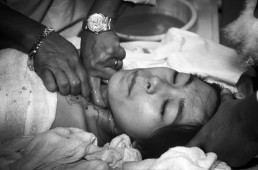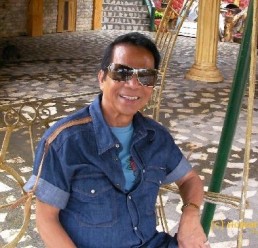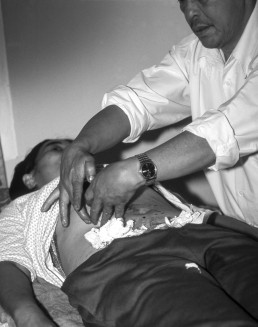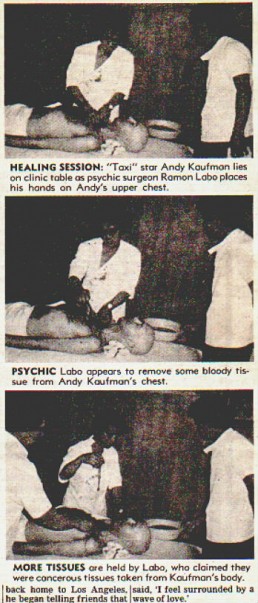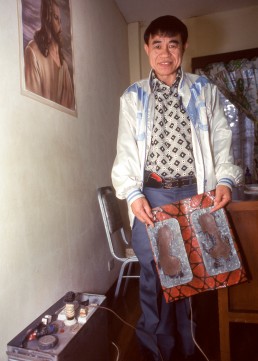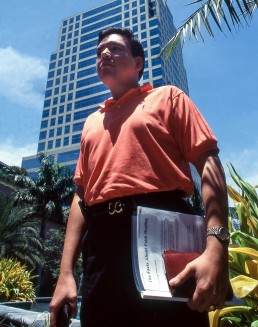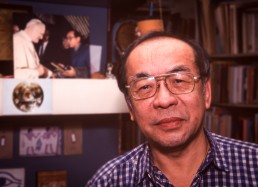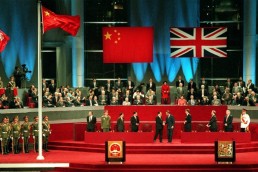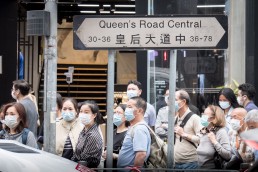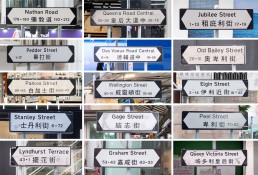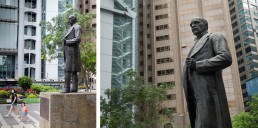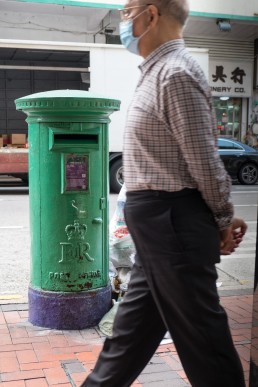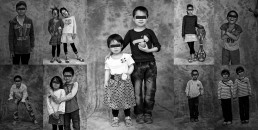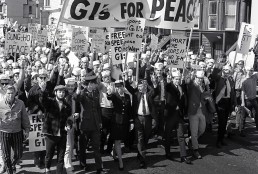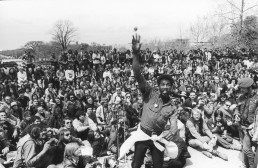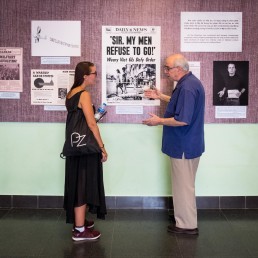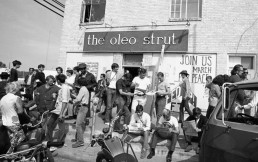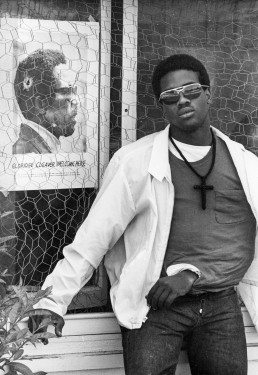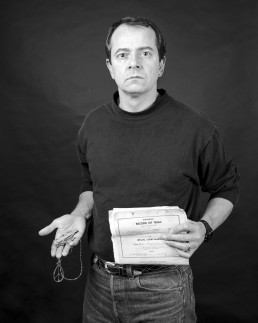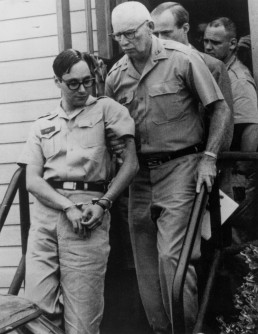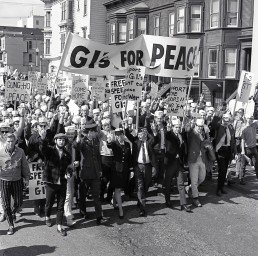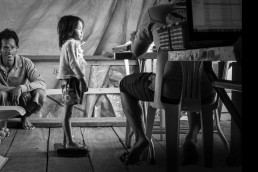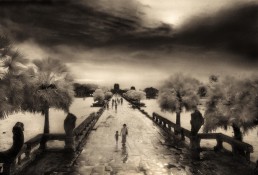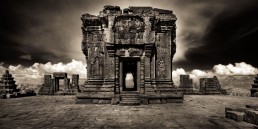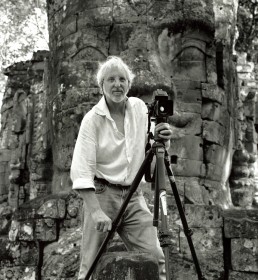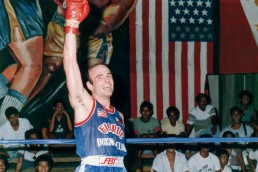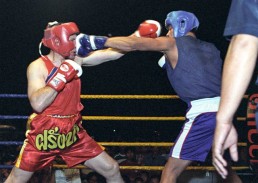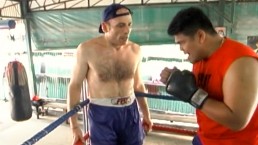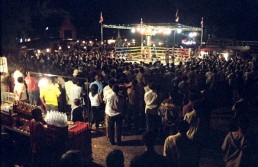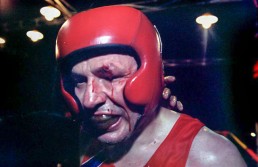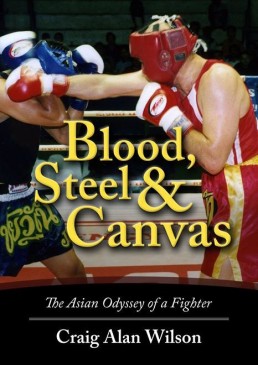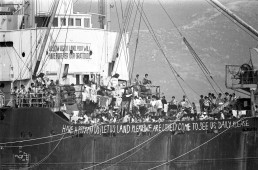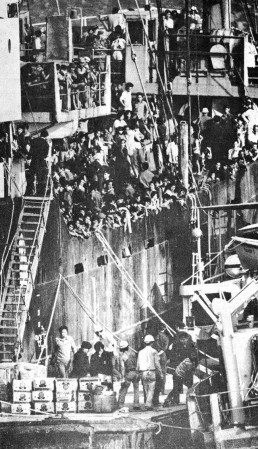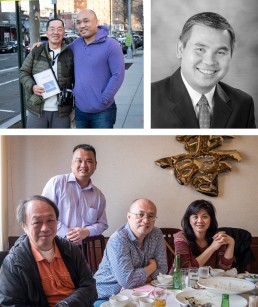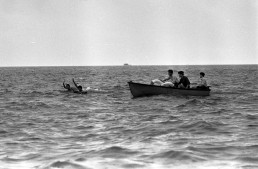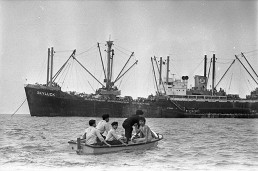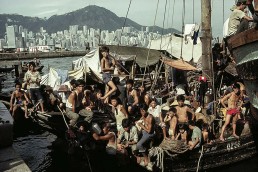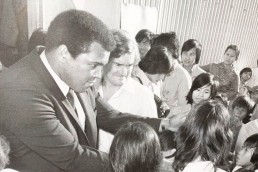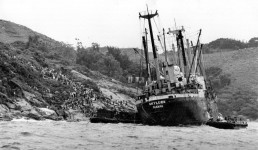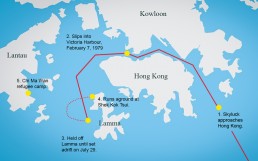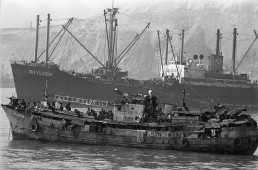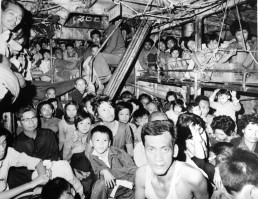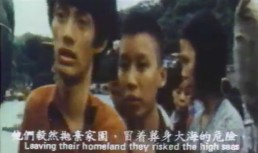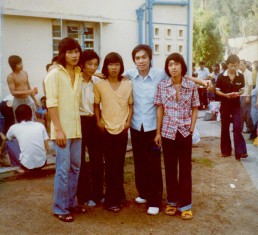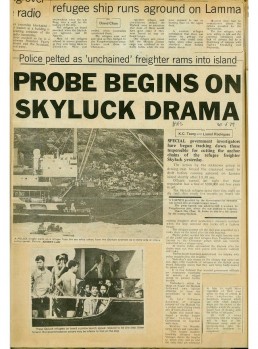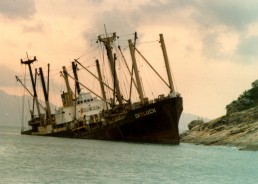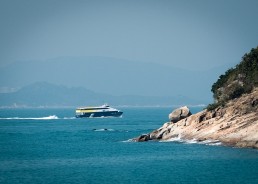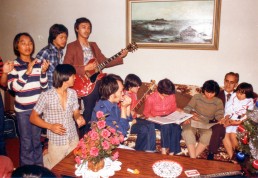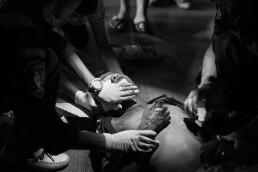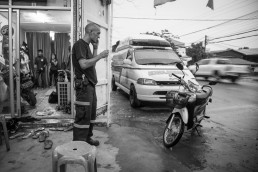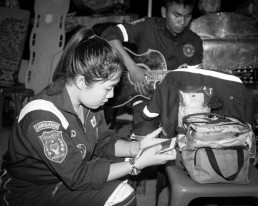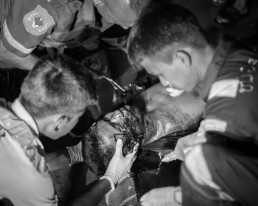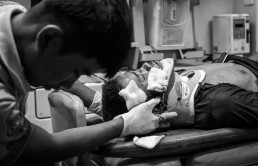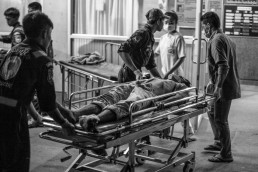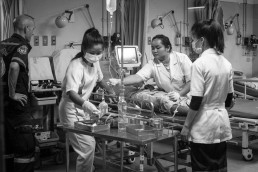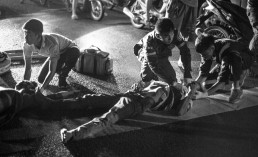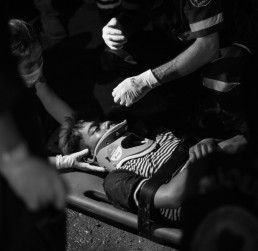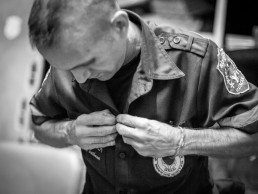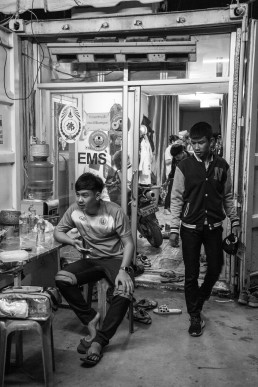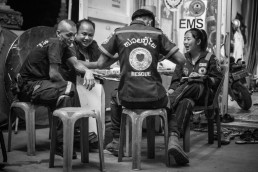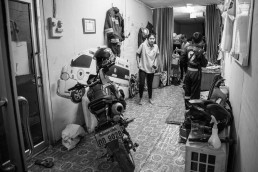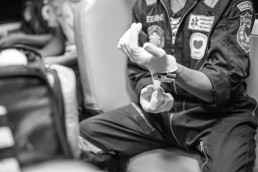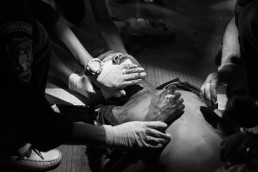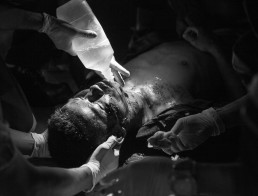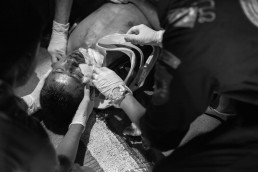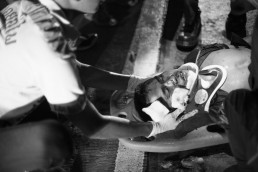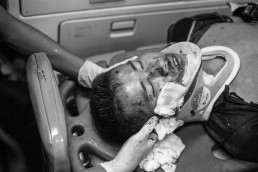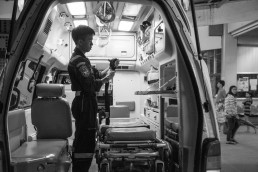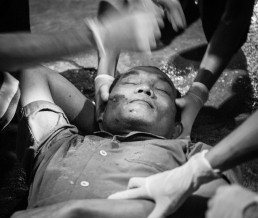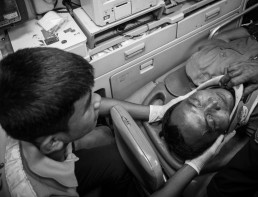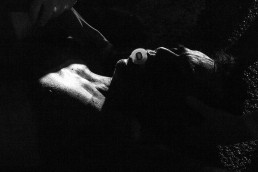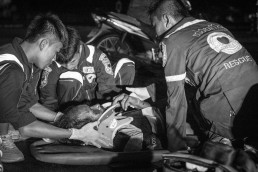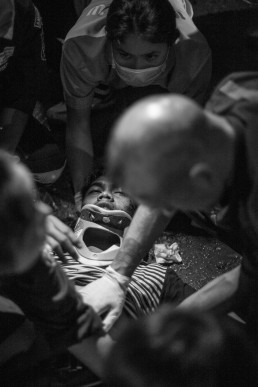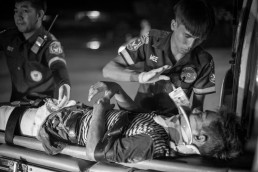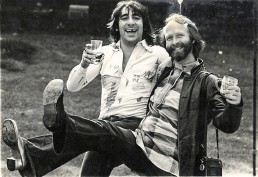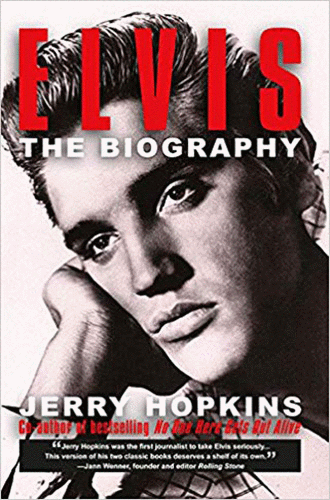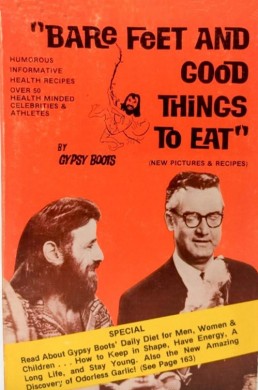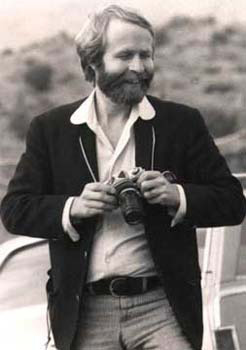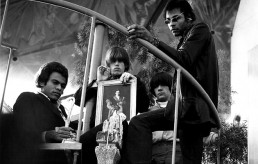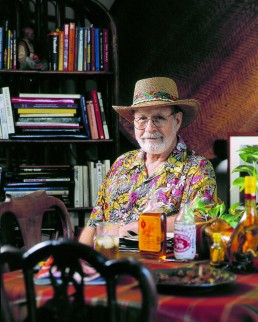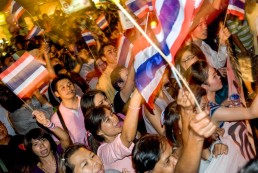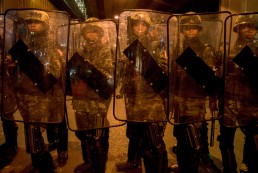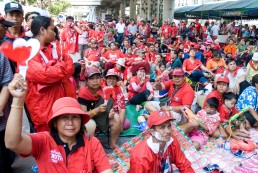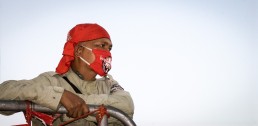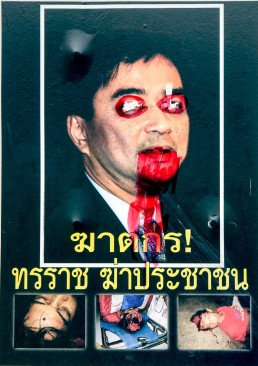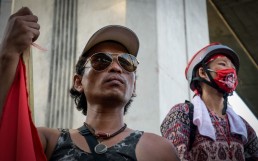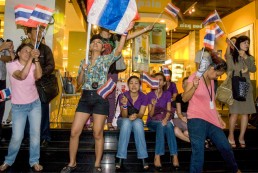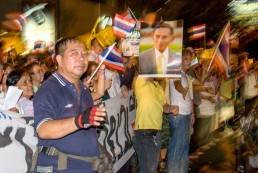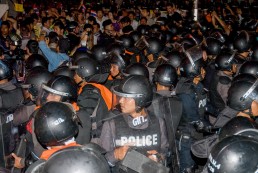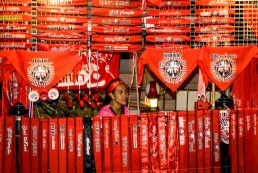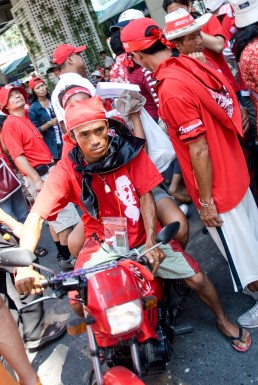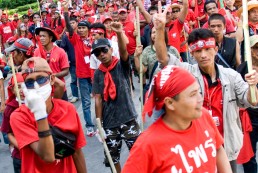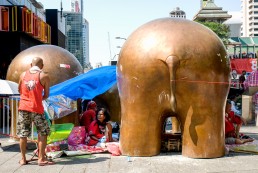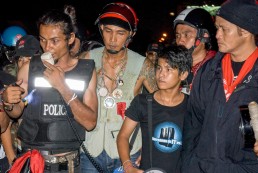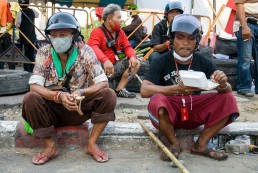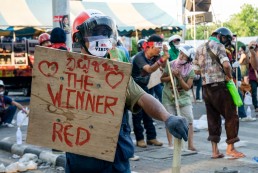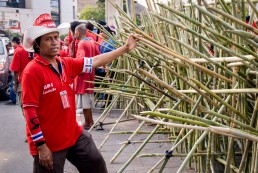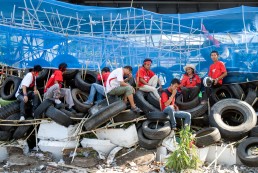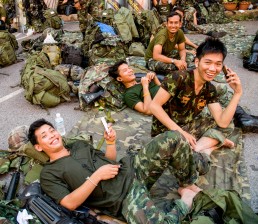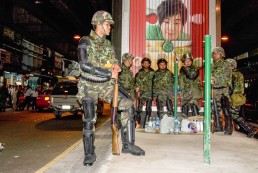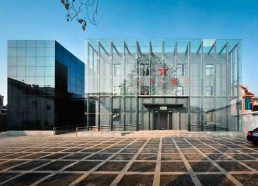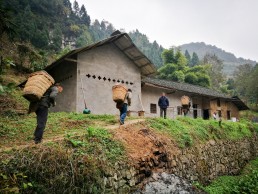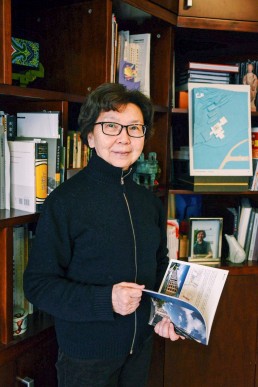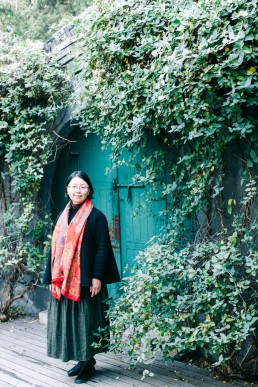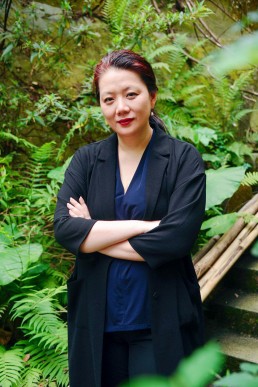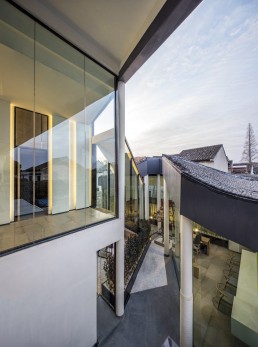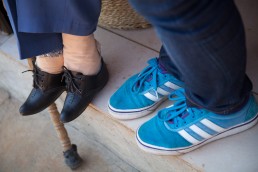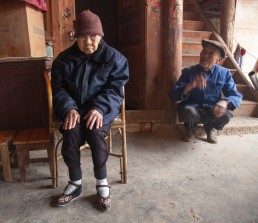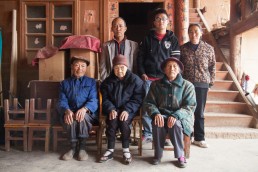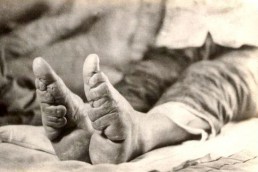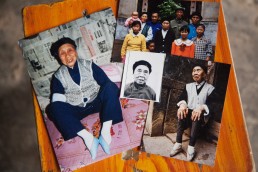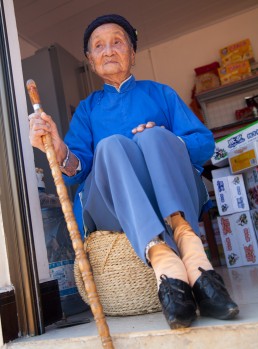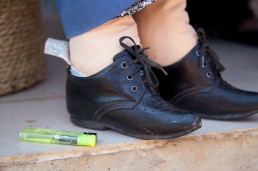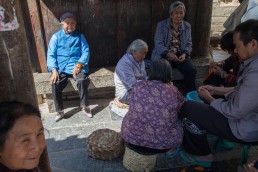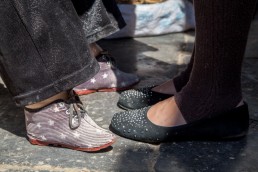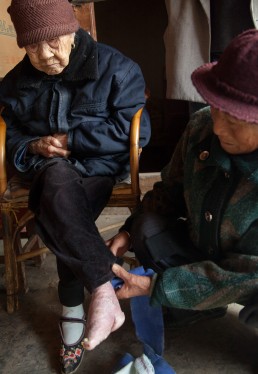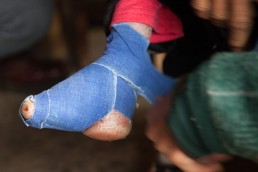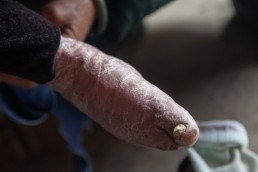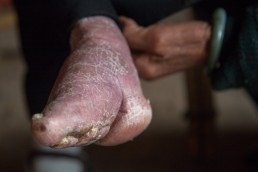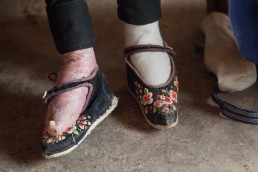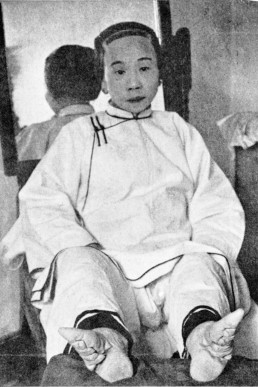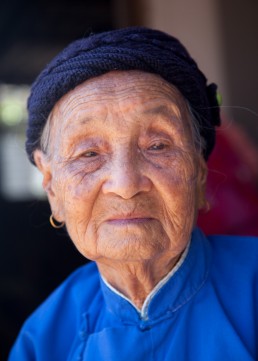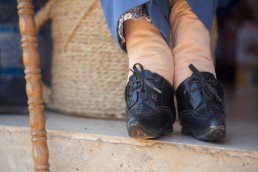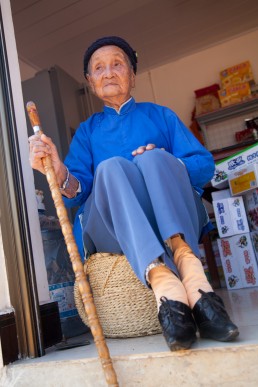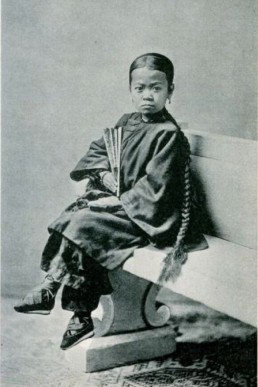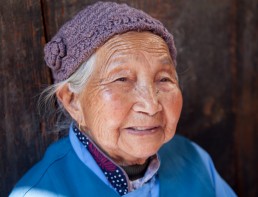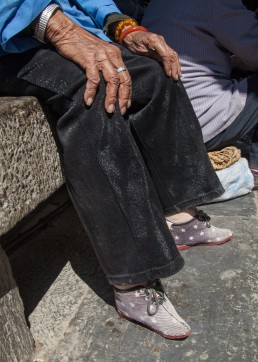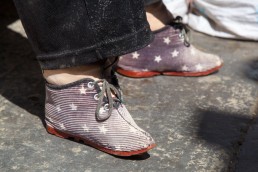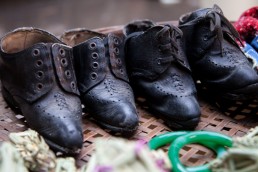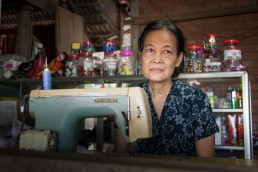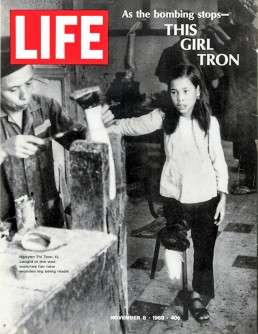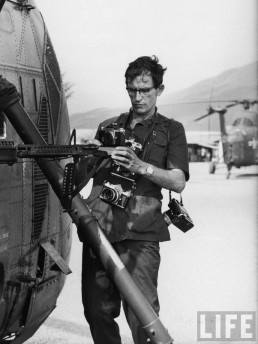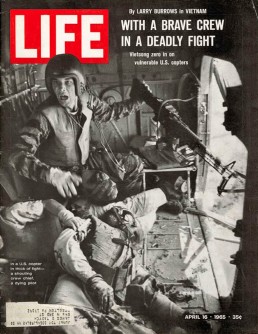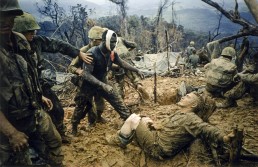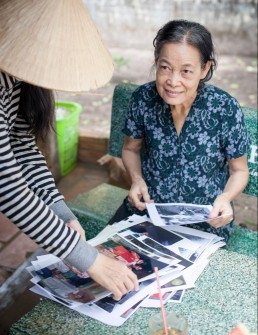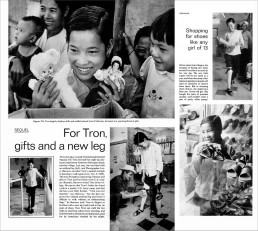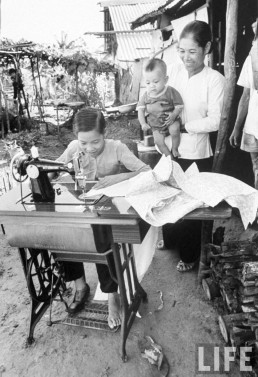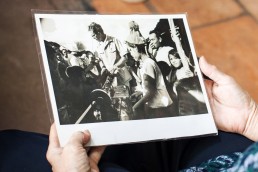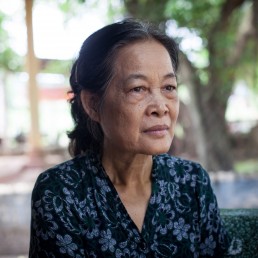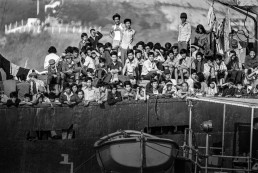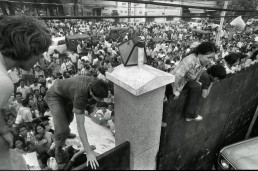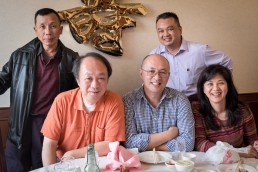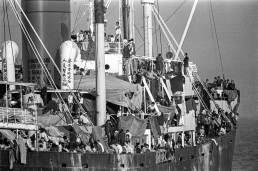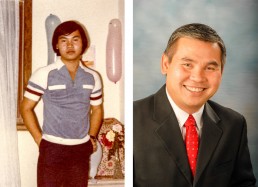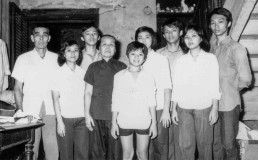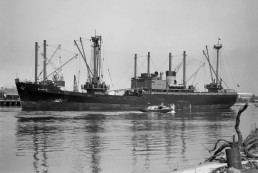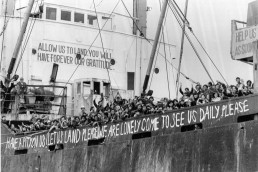Psychic Surgeons of the Philippines
Cult American comedian Andy Kaufman spent his final days seeking a miracle cure for cancer on the operating table of a wealthy Filipino psychic surgeon, hoping that healing hands could succeed where Western medicine had failed. Fifteen years later, with a new Kaufman biopic starring Jim Carrey in cinemas, a question remains: are such faith healers for real, or are they just crooks?
“He was the Neil Armstrong of comedy. He went places no one else had gone”
— Jim Carrey on Andy Kaufman
SLEEVES ROLLED UP and eyes closed in prayer, psychic surgeon Jun Labo summons up the healing powers of the Holy Spirit, plunging both hands into his patient’s stomach. Blood spurts up his arms and across her chest.
Much kneading of grey flesh and the faith healer re-emerges triumphant, a dripping black mass of organic matter in his fist. The caption to the photograph reads, “Labo removes a large tumour from cancer patient with dexterity and care.”
The book Jun Labo — A Philippine Healing Phenomenon is not for the squeamish. Illustrating the work of the world’s most famous psychic surgeon, another caption reads, “Labo lifts eyeball out of its socket and inserts his left index finger under the eyeball to clean it.” And then there’s “a haemorrhoid being pulled out after psychic surgery”.
Readers will cringe as Labo makes “mucus, pus and phlegm ooze out of this Canadian patient’s throat”, squirm as “a worm appears from this patient’s stomach, possibly the victim of witchcraft”.
Believers claim Filipino psychic surgeons have a heaven-sent ability to perform miracles — to reach into the ailing human body without a scalpel or anaesthesia to cure everything from flatulence to cancer.
Sceptics, however, say it is a wicked scam, and that Labo and his paranormal pals have become rich by charging terminally ill American, European and Japanese patients up to US$200 a minute to perform a street-conjurer’s tricks, the tools of their trade being concealed packets of blood and offal from chickens, cows and pigs.
A BETTER READ IS Andy Kaufman Revealed! Best Friend Tells All, Bob Zmuda’s account of the bizarre life and untimely death of the cult American comedian who played bumbling mechanic Latka in the much-loved, early-1980s sitcom Taxi.
The book’s closing chapters describe how, in March 1984, a painfully thin Kaufman, suffering from advanced and inoperable lung cancer, had set out on a quest for a miracle. Given just three months to live by doctors in Los Angeles, he rejected Western medicine and made a 12,000-kilometre pilgrimage to Baguio, a ramshackle town high in the Philippines’ Cordillera mountains.
Believing Kaufman’s end was drawing near, Zmuda followed. In Baguio, he witnessed his friend — now sporting a Mohawk to disguise hair loss from chemotherapy — go under the psychic knife of a certain Jun Roxas twice a day for a month. Stripped to his underwear, Kaufman would wait with other patients for Roxas’s attention, shivering on an international production line of the sick and dying.
Once it was Kaufman’s turn, Roxas would appear to rip open the comic’s chest with his bare hands and remove great gobs of cancerous tissue. He then seemed to reseal the wounds with nothing but the power of prayer. Kaufman passed away on May 16, 1984, at the age of 35, less than a month after returning to the US.
Time and grief may have clouded Zmuda’s memory. Perhaps, as executive producer of one of the most anticipated Hollywood blockbusters of the year — the Kaufman biopic Man on the Moon, directed by Milos Forman (One Flew Over the Cuckoo’s Nest; Amadeus) and starring Jim Carrey — Zmuda has changed the surgeon’s name to avoid legal irritations.
But, the fact is Roxas does not exist. Kaufman’s psychic surgeon was Ramon Labo Junior, better known as Jun Labo.
‘AH, YES, MR KAUFMAN,’ says Labo, squirming on an ornate white-wood and red-velvet throne. Surrounded by gaudy figurines of a bloody Christ and a weeping Madonna, the flamboyant faith healer is uncomfortable recalling a high-profile patient who died in the face of divine intervention.
“Mr Kaufman was very sick when he came to me. He was very skinny, very weak. The cancer had gone too far. I couldn’t help. He is with Jesus now.”
Labo is 65. He looks 45. He is short, lean, self-assured and tanned to peanut butter. His big hair is blow-dried. His small eyes are hidden by 1970s sunglasses. But the most striking thing about him is his jewellery.
On one wrist, a huge diamond and ruby-encrusted gold watch. On the other, a custom-made, gold identity bracelet big enough to scare Puff Daddy. It, too, flashes with diamonds. Labo looks at once daft and sinister. He chain-smokes Marlboro Menthols.
After thousands of dollars of treatment, Zmuda says his friend left Baguio only when his surgeon pronounced him cured. Labo claims he knew he could not help within two days of Kaufman’s arrival. “Mr Kaufman cried and insisted that I keep trying,” says Labo. “After all, he was already here. He had cancer. He was dying. He had nothing to lose.”
Like Hollywood, it seems Baguio might be a place where fact and fiction are blurred for financial gain.
LABO’S OFFICE IS in the basement of the Nagoya Inn, the healer’s surreal, paint-flaking hotel for the sick and wretched that reeks of mould and despair and cockroach killer that doesn’t kill cockroaches.
On a mist-shrouded Baguio hillside, beyond Lourdes Grotto and Holy Ghost Hill, the Nagoya’s garden is slippery with rain and the shit of ducks, chickens, deer and goats that wander listlessly among a frozen freak show of life-sized plaster sculptures — busty mermaids, leaping lions and battling samurai. The Nagoya’s gift shop sells “I Love Jun Labo” T-shirts.
According to the Philippines Medical Association, there are fewer than 50 practising psychic surgeons in the Philippines. The most powerful are in Baguio, where acts of God are common. The town is hit by at least 20 typhoons a year, and accompanying mudslides sweep the corrugated-iron shacks of the poor to the foot of the valley.
In 1990, an earthquake measuring 7.7 on the Richter scale killed 1,600 people in 45 seconds. Life and death revolve around the Immaculate Heart of Mary Cathedral, perched high on a hill in the centre of town like colossal, pink-iced wedding cake.
With his ostentatious lifestyle and cocky manner, Labo is the most controversial of all the healers. Followers call him a misunderstood saint, the Elvis of faith healing, the pope of Baguio. Many more say he is a cynical, dollar-eyed crook with contempt for human suffering.
“I don’t do this for money … I have been chosen by Jesus Christ to heal the people of the world and spread the message of God”
Psychic surgeon Jun Labo
In a nation where the average Catholic family of six barely survives on US$130 a month, he is certainly wealthy. Across the road from the Nagoya, two Mercedes and a 1935 Rolls-Royce sit inside a high-walled compound patrolled by armed guards and snarling dobermans. A Ponderosa-style sign across the tall iron gates declares it to be “Jun Labo’s Residence”. Labo is chauffeured the 100 metres to his office every day in a Space Wagon with tinted windows.
Labo says 80 per cent of the “tens of thousands” of patients he has treated have been cured of afflictions that include cancer, Parkinson’s disease and rheumatoid arthritis. He declines to talk about money. “For tax reasons,” he says. “I don’t do this for money. I am being used by the Holy Spirit. It is not my choice. I have been chosen by Jesus Christ to heal the people of the world and spread the message of God.”
Pushed, and he cannot resist bragging. Since the early 1980s, Labo says he has treated more than 100 foreign patients a week at an average rate of US$50 a session. A quick calculation sees his annual income top US$250,000, not including additional revenue from patients paying to stay at the Nagoya.
In 1984, when Kaufman visited Labo, a critical newspaper reporter said the healer was a peso millionaire. According to his biographer, Labo smiled and said, “The report is wrong. He should have said I’m a billionaire.”
LABO’S FIRST PATIENT of the session arrives. The young, well-dressed Filipina has acute period pain and goitre, a swelling of the neck due to deficiency of iodine in the diet and swelling of the thyroid gland. Labo leads us down a corridor lined with photographs of him healing the multitude. Others show Labo high-kicking in his karate gear and chatting with the late Hollywood actor Burt Lancaster.
We pause for Labo to pray in his spooky chapel, the nerve centre of his Metaphysical Temple of the Universe. The 32 white pews face a metre-high pyramid-like frame that Labo sits under to meditate. The dominant colours are papal white and gold, but the chapel is a confused mish-mash of Catholic, Zen and new-age iconography. To ensure the largest possible market, Labo advertises that he can cure Christians, Muslims, Buddhists, pagans, atheists.
Beyond the chapel, Labo’s surgery is a simple white room dominated by a mournful portrait of Christ and a porcelain statuette of Mary. The patient strips to her underwear and lies on the operating table.
“Watch carefully,” Labo says with a mischievous glint in his eye. What happens next is pure theatre.
LABO SLIPS ON a white surgical gown and rolls up its sleeves. His huge watch and bracelet stay. He closes his eyes to summon up his spirit guide — a native American Indian named Rama, apparently — and he enters a trance.
Labo moves fast and sure. He rests his hands on the woman’s abdomen and a red liquid oozes from his fingertips. Within seconds, he is splashing in a deep crimson pool and a dark stringy discharge appears. He flicks it onto her heaving chest.
Labo’s hands are visible throughout, except when his fingers are sunk deep into the woman’s fleshy midriff. If his performance is sleight of hand, it is extremely well executed.
After rinsing in a bowl of water, Labo keeps his hands in full view and moves to his patient’s neck, where there is no excess flesh in which to hide. Again, blood and matter appear from nowhere. The only logical explanation — divine intervention aside — is that Labo’s assistant, who is constantly replacing soiled towels and shifting fresh ones into position around the patient’s body, is leaving covert props for his master. The entire performance lasts perhaps a minute.
“It was a frame up. They are jealous and they want to destroy me”
Labo, on his recent arrest in Russia for fraudulent practice of medicine
Labo can see I am impressed and he is pleased. But his smile disappears when I bring up Moscow.
According to the Russian and Filipino press reports, Labo was arrested in September last year (1998) for the fraudulent practice of medicine in the Russian capital having treated a nine-year-old boy for a brain tumour.
Labo charged US$1,500 for 10 sessions. When the child’s condition deteriorated, his father went to the police. They raided Labo’s surgery, according to the reports, allegedly to find a stash of cattle blood and entrails in the refrigerator.
“It was a frame up,” Labo says, claiming the boy’s father was in the employ of his political enemies. Labo, who has twice been Baguio’s mayor, also claims the newspapers are being paid to discredit him. “They are jealous and they want to destroy me,” he says.
After six months in Russia, Labo was released in March 1999 thanks to the efforts of Joseph Estrada, the former B-movie actor turned Philippines president, who petitioned Russian Prime Minister Yergeny Primakov for his friend’s release. Estrada also ensured that Labo received VIP treatment while incarcerated in Moscow. “It was like living in a comfortable hotel,” he boasts.
Over the years, Labo has worked hard to maintain good, if morally suspect, political connections. In the early 1980s, he says he rose at 5am each day to board a private plane to Manila, where he would treat the late Philippines dictator Ferdinand Marcos for a kidney ailment. Labo remembers those days fondly. “The president loved me very much,” he says, “because I allowed him to urinate again.”
An appreciative Marcos — who, legend has it, believed the Philippines to be situated under a hole in the universe through which cosmic forces entered — would then rub down a tired Labo with Vick’s Vapour Rub, the healer confides.
Labo also claims he has also treated Libyan strongman Muammar Gadaffi, for heart trouble, as well as the wife of former South Korean president Chun Doo-Hwan, the man responsible for the massacre of 2,000 students protesting his military dictatorship in 1980.
“I will help anybody,” says Labo. “Rich? Poor? It’s all the same to me. I am a simple instrument of the supernatural being we call Jesus Christ.”
THOUGH LABO MIGHT think he is God’s gift, Baguio does not. Rarely leaving his fortified compound, myths have sprung up around the healer like a creepy Filipino Boo Radley. “Labo is number-one quack doctor,” splutters my jeepney driver into town, offering a sarcastic thumbs up and laughing so hard he almost chokes. “He makes good hocus pocus.”
“Nobody in Baguio believes in Jun Labo,” rants Tony, a beefy miner in a “Couples For Christ” T-shirt at the dingy bar of the Swagman Attic Inn, where conversation centres on a recent gunfight between local Baguio gangs keen for the rights to sell fried chicken at the bus station.
A sign above the bar reads, “Alcohol is the greatest enemy of man. But the Bible tells us to love our enemy”. Johnny Cash singing The Beast in Me on the television adds to the frontier atmosphere.
“Only foreigners believe in psychic surgery. It’s voodoo medicine,” adds Tony.
Taxi driver Abe, meanwhile, says he has seen Labo’s men buying cuts of meat in the market that “the poor would not eat”.
Felix, whose business card proclaims him to be a “master butcher”, tells his friends to shut up. “Labo is a very powerful man,” he advises with menace. “Be careful what you say.”
When Labo arrives for dinner with his glamorous, twenty-something Russian girlfriend — a leggy, ice-blond Brigitte Nielson lookalike — on his arm, Felix leaps from his chair to shake Labo’s hand. Abe and Tony sacrifice their San Miguel beers to dart off into the stormy night.
A greasy-haired man in a cheap anorak hugs Labo like a long lost brother. “Thank God that you have come home to us,” he fawns, recalling the healer’s Moscow troubles. The barmaid tells me later that the man is a senior figure at the Bureau of Internal Revenue.
BELIEF IN PSYCHIC surgery is strongest at the extremes of the Philippines’ massive wealth gap. The indigenous poor receive free treatment from the faith healers, who appear to remove tinfoil, coins, stones, bamboo, even dead insects and chickens’ feet from their bodies in line with a belief in witchcraft.
Labo, however, has given up on the destitute. He says they steal watches and wallets from his richer patients, who indulge in psychic surgery simply because they can afford to. But the big money comes from treating foreigners.
The first documented case of psychic surgery was performed in the 1940s, by Eleuterio Terte from Pangasinan province, west of Baguio. It became an international industry in the late 1960s under Tony Agpao, the father of assembly-line psychic surgery whose travel agency flew in charter planes of patients from Europe, North America, Japan, Australia and New Zealand. They slept and dined and spent their money in his wife’s hotel.
In the 1970s, Agpao — who, when he got sick himself, had his appendix removed in a San Francisco hospital — boasted that he was personally responsible for 30 per cent of all the region’s foreign-currency earnings.
Followers of Agpao say the strain of channeling the Holy Spirit resulted in his early death at the age of 42 — in 1982, of a stroke while cruising in his Mercedes. Labo quickly took over the wheel, carving out a healing empire like Baguio had never known.
The son of a psychic dentist (whose magic touch, it was said, could fill cavities, mend rotten teeth and even promote the growth of a new set of gnashers in the elderly), Labo had married a Japanese patient, Yuko Narakawa, in 1980 (they separated in 1998). The glamorous duo became Baguio’s first couple when Labo entered politics in 1984, effortlessly buying the support of the poor with free rice.
Soon Narakawa was also performing psychic surgery under her husband’s guidance, and the couple quickly cornered the lucrative Japanese and Korean markets and played key roles in promotional documentaries on psychic surgery shown across the world. The Marcos connection boosted their money-making potential at home.
Other healers suffered financially from the Labos’ success, including “the Reverend” Placido Palitayan. The Swagman’s barmaid points out one of Palitayan’s patients — a skinny, fifty-something Australian hippy with a shock of curly grey hair and kidney stones — sitting alone in the corner of the restaurant sipping iced water. “No way am I talking to you, man,” he says, more than a little terrified. “You’re giving off an awful lot of negative energy.”
TWO KILOMETRES out of town on the Marcos Highway, Palitayan’s surgery is a small, concrete lock-up opposite Holy Trinity Construction Supplies. He is a stunted, tired-looking 57-year-old in a San Francisco 49ers cap, aviator shades and baggy dad jeans. A patient is waiting, so he yanks open the rusting iron doors to reveal bare walls painted soft pink. Palitayan’s scruffy assistant brushes away the flies and a patient edges onto the blood-stained operating table.
Eyes closed, Palitayan places his right hand an inch above her forehead and concentrates hard for about 20 seconds. What he calls “magnetic healing” complete, he shifts his chipolata fingers to her lower abdomen. Blood appears with an audible “pop” and his hands become flecked with scraps of black tissue. “Infected uterus,” he offers casually, flicking the gunk towards a plastic bucket. He misses and it sticks to the wall with a splat.
In his glory days of the late 1970s and early ’80s, Palitayan says her treated 100 foreigners a day, including tennis player Ivan Lendl for muscle strain and actor Peter Sellers for a heart ailment
Palitayan rinses his hands in a bowl of bloody water and we head next door to his son’s truck-stop cafe. Placido III is preparing pinicpikan, a local dish. The main ingredient is chicken scorched in an open fire. But first, the live foul is tethered and slowly clubbed to death, ensuring that every inch of the chicken’s flesh is saturated with adrenalin-loaded blood when the it finally succumbs to the drawn-out beating and dies. “Compassion is the secret of healing,” says Palitayan. “Not money, big cars and fancy clothes.”
In his glory days of the late 1970s and early ’80s, Palitayan says her treated 100 foreigners a day, including tennis player Ivan Lendl for muscle strain and, in his Manila hotel, actor Peter Sellers for a heart ailment. Sellers died of a heart attack in 1980.
A messy divorce (“she took all my money”) and problems with gambling and booze have succeeded in slashing Palitayan’s business to just five foreigners a month, he says. More than a little bitter, he is frank about the mechanics of the profitable psychic healing industry. Like Labo, Palitayan has had run-ins with the authorities. In 1989, he was arrested in Spokane, Washington, for practising medicine without a licence. After 20 hours of questioning, he says, he was released without charge.
In 1992 he was refused entry to Hong Kong, where he was to hold a week-long healing tour. During his five hours at the airport, he discovered that his sponsor — an American entrepreneur who had promised to split each US$200 fee per patient with the healer — was charging US$400 and ripping him off.
“He was a fool,” Palitayan says. “If he was wise, he would’ve brought patients to me. He would not have advertised. That’s what I need — a partner who is sensible. We could make good money … silently.”
Contrarily, perhaps assuming all publicity is good publicity, Palitayan keeps a cutting of the incident from Hong Kong’s South China Morning Post in his wallet. The headline reads, “Psychic Healer Fails To Soothe Hong Kong Immigration”.
DOWN THE YEARS, most psychic surgeons have been discredited. Back in 1967, Agpao was indicted for fraud in the US, forfeiting a US$25,000 bond when he jumped bail and fled back to the Philippines. In 1986, Manila-based Gary Magno was arrested in Phoenix for the fraudulent practice of medicine after he was found with a plastic pouch of blood and offal in his trouser waistband. He also skipped bail.
These days, Palitayan has a new goal. “To save the world,” he says, with all the excitement of a reluctant retiree anticipating a dotage pottering in his garden. Palitayan will do this through “supernatural consciousness” and his Galacayan Evangelical Mission for World Peace.
His mission statement reads: “There is no exit and no place to hide or escape if nuclear war will broke out, for it is written in the Bible that even though you escape in outerspace, hide in deep bunkers or flee to the bottom of the sea you will still die eventually. This prophecy has been fulfilled thousand years ago, for scientist build mansion in outer space aside from space station. They also establish a city under the bottom of the sea near Japan.”
A Japanese patient told him about the submarine extension of Tokyo. “It’s finished and ready,” Palitayan says, wet lips quivering. “There’s no time to waste.” He adds that another patient, whom he calls a high-ranking US military officer, also shared his secrets about “the button”.
“It’s a big red button,” Palitayan whispers. “And my friend can press it and kill us all. Nobody knows this, not even his own mother.” He winks conspiratorially. “But I know.”
Even so, Palitayan still travels to the US every few months on three-week healing tours to boost his meagre income at home. He treats 20 patients a day, each paying US$75, and avoids the police by performing psychic surgery only “behind closed doors if patients insist”.
Most psychic surgeons in the Philippines, however, prefer their patients to visit them in the Southeast Asian country, where lax laws allow them to practise with impunity. To do this, they utilise the help of overseas agents who promote their work and organise tour groups. These agents normally take the form of new-age stores, alternative healing centres and off-the-wall religious groups.
ROBERT AND MARY Skillman of the Spirit Revisited Seminary in Vallejo, California, first met Labo in March 1990. Since then, the chirpy couple have visited twice a year, introducing 500 paying visitors to the man they call “Godfather”.
“I have so much respect for him,” gushes Mary, whose advertised skills include the “laying on of hands” and teaching Brazilian samba. “Even in the face of so many attacks on his powers, his energy and faith are tremendous.”
She recalls seeing Labo work his magic on a German toddler with deformed legs. “It took Jun Labo just two weeks before she walked for the first time in her life. It was truly a miracle.”
Though Labo was best man at their 1992 wedding in the Philippines, he has never visited the Skillmans in the US. “We want to take him to Disneyland,” says Mary. “He would love it there.”
In the UK, Patrick Hamouy of Alternative Therapies in Gerrards Cross, in Buckinghamshire, uses the Internet to promote “ultimate healing courses” in Baguio under the tutelage of Palitayan’s 59-year-old cousin, “Brother” Laurence Cacteng. According to his website, Hamouy “has studied psychic surgery in depth since May 1997 … His understanding of healing is second to none”.
Priced at £1,950, the two-week courses, according to promotional materials, include therapeutic singing sessions and discussions on the healing powers of angels and archangels, stones, clay, urine and ants.
Hamouy also sponsors Cacteng’s trips to the UK and France. He has introduced more than 100 patients in the past two years, he says, but last year (1998) he had the British health authorities on his back. “I explained, there is no actual surgery in the normal sense,” says Hamouy. “No anaesthesia, no instruments, no cutting. They wrote back and said, ‘Okay, but just make sure his fingernails are clean.'”
A YOUTHFUL 59-YEAR-old with a pudding-bowl haircut and the pliant face of a chuffed pixie, Cacteng lives in a comfortable detached house in a leafy Baguio suburb. The neighbours’ apple-cheeked kids play ball in the garden.
Sitting at his desk under the healer’s all-important print of Christ, he ushers me in with a wide smile, and he immediately disagrees with Palitayan’s patient with the kidney stones — Cacteng says my vibrations are good and I have a “nice aura”.
Against the wall sits a slate-grey sheet-metal transformer box with two steel plates attached by wires. Cacteng sits me down, places my hands on the plates and cranks up the bakelite dial. As he passes his hand over my ear, a low metallic moan is generated. He pokes a screwdriver into my arms, legs, chest and head. The small bulb in the handle lights up every time. “That’s good,” he says. “No problems.”
Cacteng, who has also visited Switzerland, Germany, South Africa and Australia as a healer, has no fixed prices, preferring patients to “pay from the heart”. Rare Japanese patients are the most generous, he says, splashing out US$50 per treatment four times a day. The French and British might fork out US$300 a week. Poor Filipino’s get away with a chicken in lieu.
As well as psychic surgery, Cacteng offers a wide portfolio of healing techniques. He recalls an Italian patient with breast cancer. “I prayed for her and told her to drink her own urine,” he says. “That fixed her very well.” Cacteng will even offer fatherly advise, as he did with Parisian teenager depressed at being dumped by his girlfriend. “I told the boy, if you kill yourself, she will laugh at you. So don’t kill yourself.”
From his desk drawer he pulls out the secret of “water therapy”. It is a rubber hot-water bottle. Cacteng also shows me a photograph of a patient undergoing water therapy. It shows a grinning Frenchman with a hot-water bottle balanced on his head.
WITH HIS HEAD held high, marching across the lobby of the five-star Makati Shangri-la Hotel in Manila’s high-rise financial district, tall and groomed 38-year-old George Nava True II towers above his compatriots. With his slick-backed quiff, tangerine polo shirt and pressed black slacks, the self-styled “Filipino Quackbuster” has made it his life’s mission to expose “alternative healers, psychics and other quacks” as dangerous charlatans. He grabs a table in the non-smoking section.
“Blame Burt Lancaster,” Nava True chuckles, explaining that Kaufman’s pilgrimage to Labo was prompted by Psychic Phenomena: Exploring the Unknown, a 90-minute documentary of sorts narrated by the Hollywood star. First broadcast across the US in October 1977 and viewed by 28 million people, the programme has been repeated on TV many times since.
Born of an English father and Filipina mother, Nava True is the grandson of the late Jose Ma Nava, one of the Philippines’ most revered union leaders and editor of La Prensa Libre, a newspaper sympathetic to the plight of the poor. He is also founder of the Health Frontiers Centre for Quackery Control, established in 1983 to expose useless health products and dangerous alternative therapies.
Health Frontiers’ mission statement kicks off with a humorous line — “We should have our minds open, but not so open that our brains fall out” — but Nava True is angry. “These healers can be killers,” he spits. “Sick people give up good treatment that might save their lives to travel halfway across the world to see these quacks. When they get home, it’s too late. They die.”
So why does the government do nothing to protect such patients? Nava True says authorities might be pleased that dying patients visit the Philippines to spend the last of their money and boost the economy. He also suggests the ghost of Marcos, a believer in all things paranormal, still has some influence on policy. “There is no government agency investigating these people,” he says. “And the health authorities have no authority. They can only act if people complain. And how can patients complain when they are dead.”
“In the US, the Federal Trade Commission has practically banned psychic surgery, but the healers get around the law by establishing their own churches and missions”
George Nava True II, the ‘Filipino Quackbuster’
Dr Gil Fernandez, secretary general of the Philippine Medical Association, agrees. “The laws in the Philippines leave us helpless,” he says, speaking by phone. “We believe many psychic surgeons are tricking people, but patients never complain. Either they are ashamed that they have been made fools of, or they have died. Until they do complain, we can do nothing.”
Nava True adds that healers also enjoy plenty of freedom to dupe patients when on tour. “In the US, the Federal Trade Commission has practically banned psychic surgery, but the healers get around the law by establishing their own churches and missions,” he says. “Once they have assumed titles, like brother and reverend, they claim the right of religious freedom and the authorities can’t touch them.”
Surprisingly, Nava True says faith healers are not necessarily wicked people, and that they might actually believe they are providing a genuine service. “They call it ‘true believer syndrome’,” he says. “Some healers have been practising for so long, they really do believe they have the power of God. Perhaps they are the ones that need help. If any of them are interested, I would recommend a good psychiatrist.”
With much work to do, the Quackbuster says goodbye to rush back to his office, leaving behind several press cuttings from Filipino newspapers. The most bizarre is from the tabloid Tempo. Under the headline, “I Am God — Faith Healer Kills Patient, Then Tries To Resurrect Her”, it tells of how in 1992 spiritualist Natividad Sequito murdered a mentally retarded woman while exorcising an evil spirit. She did this by ramming a 30cm length of wood down the 20-year-old’s throat and smashing her over the head with an iron padlock.
Burt Lancaster appears in 'Psychic Phenomena: Exploring the Unknown', the 1977 television special that Nava True says introduced the Philippines' psychic surgeons to a lucrative audience in the West. Video: Patrick Hamouy/YouTube
NAVA TRUE SAYS he detests the new-age travel agents that “make a living from suffering”. He also berates the makers of sensational infotainment TV programmes and writers of books on the paranormal. He says they perpetuate the “fake healing” industry and reap the secondary financial rewards “like scavenging fish around the jaws of man-eating sharks”.
Speaking on the phone from his Los Angeles office, Alan Neuman, of Alan Neuman Productions, maker of the Lancaster-narrated Psychic Phenomena, snaps back. “Labo is 100 per cent genuine,” he says. “I’ve been filming his work for over 20 years. You must understand, the healers are working in another dimension. Just because it is possible to replicate what they are doing with sleight of hand, does not mean that is what they are doing.”
But Nava True’s number-one nemesis is Labo’s biographer, Jaime Licauco, who is also author of the books Understanding the Psychic Powers of Man; The Truth Behind Faith Healing in the Philippines and The Magicians of God. As president of the Inner Mind Development Institute, Licauco — who holds a masters degree in business management — runs workshops in telepathy, telekinesis, spoon bending and what he calls other “advanced mind dynamics”. His two-day Basic Intuition and ESP Development course costs 4,000 pesos (US$100) per person.
An animated, balding 59-year-old wearing a crystal pyramid pendant, Licauco says Filipinos are descendants of Lemuria, or Mu, a mythical civilisation that supposedly existed long before Atlantis somewhere in the Pacific. To avoid hungry dinosaurs, it is said the Lemurians lived underground, growing crops with the aid of crystal-powered light generators.
“As a result,” Licauco writes in The Truth, “[Filipinos’] vibrations are higher and they are able to reach a heightened state of awareness faster and more easily than other people.”
“We had no intention of catching Labo in the act. We only noticed something irregular with the footage back in the studio. We slowed the tape down, but we never reversed it”
Jessica Soho, producer of TV news magazine programme ‘Brigada Siete’
Licauco’s Manila office is decorated with images of Egypt, a country that, he says, he has visited “not only in this lifetime”.
When visiting the UK, he continues, he was cured of a common cold picked up at Stonehenge by veteran British faith healer Stephen Turoff. This was achieved, Licauco insists, by Turoff pushing a five-inch blade up his nose. A framed photograph of the author meeting Pope John Paul II takes pride of place over his busy desk.
“I’m not defending the healers,” says Licauco, who claims Labo removed cysts from his wife’s breast. “I am defending the truth.” But even he confirms that some healers resort to trickery occasionally, when their powers have been weakened by working too hard. They do this, he adds, to ensure their patients are not disappointed.
But the crux of Licauco’s argument is that psychic surgery is a paranormal phenomenon beyond logic and science. When animal blood is discovered at a scene of psychic surgery, he says the healers cannot explain how or why. In short, he argues, the Lord works in mysterious ways. “The blood doesn’t come from the patient’s body. It is materialised by the Holy Spirit,” he says.
Licauco also insists he is not paid by the faith healers, and they do not sponsor his shameless hagiographies. But they do give him “gifts”, he says.
He argues that Nava True and other sceptics manufacture evidence to discredit psychic surgeons. To illustrate his point, he slips a tape of investigative TV news magazine Brigada Siete into the VCR. During the programme, aired while Labo was incarcerated in Moscow, an allegedly cheating Labo is revealed collecting a large chunk of bloody flesh from beneath his operating table.
“There. Can you see?” Licauco cries. “Labo wasn’t bringing his hand towards the patient. He was taking it away. They reversed the film.”
Jessica Soho, Brigada Siete producer — and a Catholic believer in faith healing — denies Licauco’s “ludicrous” accusation. “We had no intention of catching Labo in the act,” she says, laughing, when called. “We only noticed something irregular with the footage back in the studio. We slowed the tape down, but we never reversed it.”
BACK IN BAGUIO, Labo’s guards have put down their guns and are listening to a religious crusade on the radio.
“Are you happy?” the fire-and-brimstone preacher rants through the static. “Then sing praise, sing praise to God Almighty. Are you sick? Then call, call today on the messenger of the Lord. If you believe, if you believe, then you will be cured. And your sins will be forgiven.”
Labo is praying in his chapel. Lost in a trance in front of a weeping bust of Christ, he is performing paranormal house calls, he tells me later, or “distance healing”. He does this by concentrating his “third eye” on the yellowing photographs that decorate the altar — of a sweet, weak old lady balancing on crutches; of an emaciated grey-haired man in a wheelchair; of a sad-eyed teenager with no hair, no eyebrows.
Labo then astrally projects himself, or so he claims, across the oceans to check on their progress.
Finally, sticking to Journalism 101’s tried-and-tested tactic of saving the most insulting question until last, it is suggested to Labo that his big house, his luxury cars and his expensive jewellery may have been purchased by cruelly ripping off desperate people clinging to a last remaining hope of staying alive.
“The people who criticise me don’t believe in God,” he says, casually lighting another Marlboro Menthol with a disposable lighter. On one side, the lighter features a buxom blonde in a bikini. On the other, the words “Jun Labo for Mayor”.
“But they will believe when they are dying. They will pray too. They will come to me.”
With our meeting over, Labo bids a kindly “God bless”and offers a gift, a promotional Japanese videotape entitled Jun Labo — The Only Choice. Watched later, one scene has Labo demonstrating the need for psychic-surgery patients to have an open mind. He does this by twirling a small square of cotton into a thin strand, which he then carefully threads into a middle-aged woman’s left ear. Abracadabra … and he pulls it out of her right ear.
CLEAN-LIVING KAUFMAN also had an unusual way of flossing. After a few days submerged in his depraved comic creation and alter-ego Tony Clifton — a hard-drinking, chain-smoking, whore-hopping Vegas lounge singer — Kaufman would attempt to cleanse his system by swallowing 15 metres of damp cheesecloth. Through a process of controlled peristalsis, he would then pass the fabric through his alimentary canal and out of his backside.
Kaufman’s short life was full of bizarre behaviour and practical jokes. He grappled with women in inter-gender wrestling matches. He took his entire audience at Carnegie Hall out for milk and cookies. He was Elvis’s favourite Elvis impersonator.
Today, die-hard fans hope — even pray — that Kaufman faked his death, that his last-gasp trek to Baguio was just an elaborate twist in a great if morbid hoax. Though a sign at the Nagoya Inn’s exit reads, “Thank You, Come Again”, Labo has not seen Kaufman — or any more of his cash — in 15 years. Not since the comic left the Philippines mountain town thousands of dollars lighter, still dying of lung cancer. ◉
This long-form feature is a little long in the tooth. It was timed for the release of Man on the Moon in 1999, and ran over seven pages in the British edition of GQ, as well as in Max in Spain and Post Magazine in Hong Kong.
SHARE
Remains of the Day
With the toppling of colonial-era statues suddenly de rigueur across the globe, why has Hong Kong kept so many souvenirs of the British empire some 24 years after its return of its sovereignty to China?
IN 1996, ONE YEAR BEFORE Hong Kong’s return of sovereignty to China, Pun Sing-lui set about the bronze statue of Queen Victoria that sits in the city’s leafy Victoria Park, beside magnificent Victoria Harbour, with a hammer.
As well as caving in the royal nose, he poured red paint over the British monarch whose reign embraced both Opium Wars. Pun’s “art performance”, the recent arrival from mainland China said, was to protest Hong Kong’s “dull, colonial culture”. He demanded “cultural reunification” with the motherland.
Pun’s attack on the statue was almost universally condemned in Hong Kong, with the 26-year-old slammed as nothing more than a publicity-seeking vandal. Four months later — after a nose job requiring a hydraulic jack, acrylic resin and about £12,000 — the screens hiding Queen Vic were removed. She has serenely watched over the public park ever since.
But for how much longer?
IN THE WAKE OF STATUE toppling around the world and noisy calls to “decolonise” public spaces, on top of the Chinese Communist Party (CCP) decrying the colonial era as a shameful “century of humiliation”, how can it be that Hong Kong maintains many souvenirs of empire some 24 years after Her Majesty’s Yacht Britannia sailed into the sunset?
After all, in other cases where Blighty bid cheerio to its colonies, new rulers often removed statues to reflect changed political realities without much fuss.
“When the post-colonial administration took over, I think they would have quite liked to have got rid of some things,” says Steven Gallagher, a professor at the Chinese University of Hong Kong’s faculty of law, with special interest in cultural heritage, adding that Pun’s desecration of Victoria had “focused people’s attention on their heritage” and made them fearful of a threat to their unique cultural identity.
Gallagher recalls recent words of one of his students: “She said, ‘Even though we were young then, we remember what happened with that statue. We just thought, that’s wrong. That’s part of our heritage.’ The colonial identity is part of Hong Kong for Hongkongers … I think if the government did try to remove [statues] now, there would be a reaction.”
Even British drug dealers are immortalised at Jardine Terrace and Matheson Street — named for the Scottish merchants who founded the company Jardine Matheson in the 19th century to traffic in opium, tea and anything else other that would make a buck
And we’re not just talking statues. Many streets, districts and landmarks in what the tourism authority calls “Asia’s World City” celebrate British royalty. Victoria is honoured everywhere, from the harbour to Victoria Peak. Then there’s Upper Albert Road, Princess Margaret Road, Jubilee Street, Queen Elizabeth and Prince of Wales hospitals, Prince Philip Dental Hospital, Queen Elizabeth Stadium, Prince Edward metro station …
Dozens of locations carry the names of former governors, colonial administrators and military officers, including Nathan, Arbuthnot and Stubbs roads, and Wellington, Gough and Elgin streets. Even British drug dealers are immortalised at Jardine Terrace and Matheson Street — named for the Scottish merchants who founded the company Jardine Matheson in the 19th century to traffic in opium, tea and anything else other that would make a buck.
IN THE RUN-UP TO the handover, there was some apprehension in the uber-capitalistic crown colony for what the future might bring, but talk of dread for authoritarian new overlords marching into town was often exaggerated.
China was loosening up, if gradually, its economy kicking into overdrive. The Basic Law, the post-1997 charter hammered out between Britain and China, promised “one country, two systems”, with Hong Kongers governing themselves for 50 years — which they had not once enjoyed in 156 years under the Union Jack.
Since the change of sovereignty, worries about Hong Kong whitewashing its history have, on the whole, proven unfounded, and its Beijing-beholden government has taken a softly-softly approach to heritage.
When attempts have been made to remove British-introduced landmarks, they have largely been to meet infrastructure needs, as with the removal of Queen’s Pier — the original, long gone, named for Victoria — on the harbour front in 2008 to permit land reclamation.
Gallagher says Hong Kong governments — both the colonial and post-colonial administrations — “have never cared very much for what the people think”, tending to act first and deal with any backlash later. Heritage, he says, is one area where they have learned this roughshod approach does not work, with embarrassing U-turns made to quell popular displeasure when authorities have acted without public consultation.
Though the pier was little more than a utilitarian, concrete canopy thrown up in 1954, conservation-minded protests ensued, and the chastened powers that be committed to store the dismantled structure to reassemble it in another location. Gallagher calls the move a “gesture” not requiring significant investment while “appeasing the people”.
And while there is no special designation for Hong Kong’s colonial statues under the law, he says, with only the British-built Cenotaph protected under the Antiquities and Monuments ordinance, they have been left in peace.
Alongside Queen Victoria — unveiled in 1896 to celebrate her 77th birthday — these include bronzes of King George VI, in Hong Kong’s Zoological & Botanical Gardens, and colony financier Sir Thomas Jackson, made chief manager of the Hongkong and Shanghai Banking Corporation, forerunner of HSBC, in 1876.
Jackson’s is the only statue in Statue Square today, in the heart of what once was the city of Victoria and now the business district of Central. The square had been home to many statues, mostly of royalty, but they were removed during occupation in the Second World War, and shipped to Japan to be melted down. Jackson and Victoria were recovered with the end of hostilities and made it home safe and sound.
THERE HAVE BEEN occasional calls for Hong Kong to exorcise the ghosts of its past, most recently in 2018, when businessman Shie Tak-chung — a local delegate to Beijing’s top advisory body, the Chinese Political People’s Consultative Conference — suggested changing street names as part of a patriotic education drive aimed at youth.
Local commentators spluttered in print that Shie’s call to anti-colonial action was just a self-serving publicity stunt — thus giving him publicity — but it was soon forgotten.
Robert Bickers, a professor of history at the University of Bristol specialising in the British Empire and its relationship with China, says there could be many reasons for streets being left alone since 1997, with practicality perhaps trumping ideology. Changing street names, he says, is “really expensive” and disruptive to everyday life. “All the businesses have to change their cards, their stationary,” he says.
Bickers also believes that when such a changeover of sovereignty has come about peacefully, new powers that be have generally been less excited about ripping down symbols of the old regime.
“It’s not as if there has been a bloody insurgency, and the victors arrive and say we’re pulling down him and getting rid of her. It’s not as if the British, for example, are panicking and thinking, ‘We’re withdrawing now, leaving a puppet government behind that we’re pretty certain is going to fall, so let’s take Queen Victoria with us, or at least move her to safety.’”
If such a handover has been “more bureaucratic and negotiated”, he says, ripping down statues is not a top priority for the incomer. “Top priority is showing that you’re a rational, modern government.”
IN TRUTH, SOME symbols of empire have disappeared over the last quarter century, often in acts of self-censorship. In the immediate run-up to the handover, most institutions holding the Royal Charter voluntarily removed the problematic “R word” from their names, including what are now the SPCA, the Hong Kong Golf Club and the Hong Kong Jockey Club. The notable exception was the Royal Hong Kong Yacht Club, established in 1893.
The club’s early members were British only, later extending to other Europeans, with Chinese not permitted to join until the 1950s. Women, whom Mao Tse-tung proclaimed in 1968, “hold up half the sky”, could not be full members until 1977. Surely the stain of such discrimination would make breaking with the past a sensible move.
But there is nothing in the Basic Law requiring private organisations to change colonial-era names. The government’s attitude appears to be that it’s none of their business, and for a club’s members to decide. (In fact, back in 1996, a majority of the yacht club’s members did support a motion to remove “Royal”, but this fell short by just two votes of reaching the 75 per cent majority required.)
“Our colonial history is still part of our history. Even if we remove all our colonial-style heritage, we cannot make that part of history disappear forever in Hong Kong”
Roy Ng, of the Hong Kong Conservancy Association, speaking to the BBC in 2015
And soon after the handover, Hong Kong’s bright-red post-boxes were not replaced but simply painted green to match those over the border. Fifty-nine of the old cast-iron boxes, however, were embossed with royal cyphers highlighting the reigns of George V, George VI or Elizabeth II.
In 2015, Hongkong Post deemed them “inappropriate”, promising to cover up the royal cyphers with its modern hummingbird logo. Again, there was a backlash.
“Our colonial history is still part of our history,” Roy Ng of the Hong Kong Conservancy Association complained to the BBC at the time. “Even if we remove all our colonial-style heritage, we cannot make that part of history disappear forever in Hong Kong.”
“How many people noticed [the cyphers] before? But as soon as Hongkong Post said we’re going to do this, people got angry,” says South London-born Gallagher.
To its credit, Hongkong Post listened to the dissenting voices. “There was strong public objection,” Ng says today. “So Hongkong Post said they would collect opinions from stakeholders and heritage groups and make a decision.”
That decision, made in 2018, was to leave the royal cyphers visible, as they remain to this day.
AFTER SHIE’S CALL to change street signs in 2018, Gallagher’s understanding is that the government’s attitude was that “everything’s quiet [in Hong Kong], why have you raised this?” And while Shie was accused by some of brown-nosing CCP bigwigs in Beijing, Gallagher says China has maintained its colonial legacy at times because “they use it as part of their narrative” of the exploitation the country suffered in the past. “There’s much more joined-up thinking about the use of heritage in China,” he says.
That said, recent events in Hong Kong — notably the pro-democracy protests that engulfed the city in 2019, and Beijing’s introduction of the new national security law last year, cracking down on separatism and collusion with foreign governments — make it unlikely we will see much more waving of the Union Jack on Hong Kong streets.
“Things are very different now, so we might see a different attitude [to colonial heritage], but I wonder how important it is for them,” says Gallagher, adding that it remains key to Hong Kong people’s sense of identity, and so removal of statues and changing of street names would perhaps be unwise. “It could be the silly thing that tips them over the edge. I would like to think there’s some common-sense there.”
Ultimately, one wonders what item of Hong Kong’s colonial baggage the next publicity-seeker will attempt to steal away.
Will barristers be stripped of their gowns and horsehair wigs? Will the Noonday Gun — celebrated in Noel Coward’s ditty Mad Dogs and Englishmen, and still fired every day by a staffer from Jardine Matheson — be silenced? Will coins adorned with Elizabeth II’s head, occasionally to be found down the back of Hong Kong sofas, cease to be legal tender?
Or, with Mayor Sadiq Khan’s new Commission for Diversity in the Public Realm set to “review” London’s statues, street names and landmarks, could we soon have a bizarre situation where reminders of empire in the British capital are scrapped or hidden, while the same or similar in a Chinese city 6,000 miles away go unmolested? ◉
These words ran in The Critic magazine in the UK in June 2021.
SHARE
Children of the Damned
Rejected by both the state and their families, the children of serious criminals in China can also be victims of their parents' wrongdoing. The luckiest get a chance to thrive thanks to charitable NGO Morning Tears.
NIU NIU SCURRIES by as fast as her little legs will carry her, and she chews on a strawberry and chuckles as she is chased around the table. The toddler’s guardian, Kou Wei, also giggles as she shoos the three-year-old outside and into the afternoon sunshine. Kou’s job is to care for Niu Niu and youngsters like her — to watch over the sons and daughters of murderers, gangsters, rapists, drug smugglers and other criminals who have been executed or imprisoned for decades in China.
Methodically, one after another, Kou tells the stories of some of the 44 waifs in her care. They are heartbreaking tales of shattered young lives — of violence, trauma and tragedy.
Kou begins with nine-year-old Huan Huan, whose mother killed her father after suffering years of domestic abuse. Huan Huan’s grandfather, in revenge for the death of his son, sold her two sisters.
Xiao Lu, at the age of seven, witnessed her parents beat a man to death. Xiao Yi saw her father slaughter her mother, and Niu Niu is the daughter of a pimp who was jailed when she was just one year old. With the family’s only source of income gone, Niu Niu’s mother abandoned her and her brother.
“We tried to send Niu Niu to kindergarten, but she refused to go, so we keep her here,” says bespectacled Kou, who is the director of the Ai Tong Yuan Coming Home Project, one of only a handful of such specialised childcare facilities in the world’s most populous nation. Despite the harrowing nature of her work, 34-year-old Kou laughs and smiles easily. “The other kids complain because when they are at school, Niu Niu goes through their things and takes whatever she needs.”
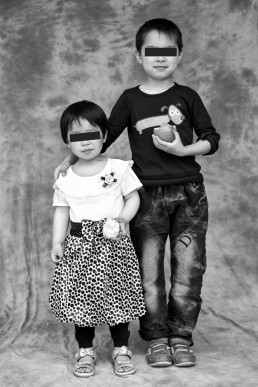
Niu Niu (left), aged three, and Tong Hao (right), nine, are sister and brother. Their father is in prison for 10 years, says Kou Wei of the Ai Tong Yuan Coming Home Project, for forcing ‘many’ women into prostitution. Their mother abandoned them. Photo and opening montage: Palani Mohan
THE AI TONG YUAN facility is located an hour’s drive east of Zhengzhou, capital city of central China’s Henan province. The discreet compound comprises four buildings painted in a peppy apricot-yellow, a basketball court and a playground. The children sheltered here, supervised by adult caregivers, live in five “family units” — essentially self-contained apartments — in the largest of the buildings. No-frills interiors are scuffed and grubby at child height. Cardboard boxes of second-hand toys are anything but overflowing.
“The kids have been through extremely traumatising events,” says Koen Sevenants, Belgium-born founder of Morning Tears, a non-governmental organisation supporting the welfare of such youngsters in China. “In many cases there has been domestic violence. Many have been subject to physical abuse, and sexual abuse in some cases.
“Children who have seen a mother brutally beaten … that can be more traumatising to a child than being beaten themselves. That is a parent they love and they want to protect that parent, but at that age they cannot.”
The children at Ai Tong Yuan clearly adore “Uncle Koen” and the older lads leap onto his broad shoulders, pleading noisily with Sevenants to arm-wrestle or play rock-paper-scissors. In his work uniform of scruffy jeans and baggy T-shirt, and with his mop of unruly blond hair and ginger beard, the 1.8-metre and burly European must appear, in their youthful eyes, like a bear — a teddy bear of seemingly inexhaustible playfulness and patience. Sevenants, 41, holds a doctorate in psychology. He has worked for aid groups all of his adult life.
“These are the children nobody wants,” he says, explaining that the offspring of convicts — still having grandparents, perhaps uncles and aunties — are not recognised as orphans by the Chinese state. “Very often relatives don’t want them. In cases of murder resulting from domestic abuse, the father’s family don’t want them because they see the mother in the children. The mother’s family see the father.”
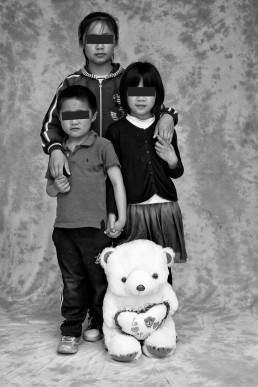
Pan Pan (left), aged 6, Xiao Lu (centre), 13, and Lu Lu (right), 8, are siblings. Their father was one of China’s army of migrant workers, leaving the countryside to make a living in the city.
With her husband away, their mother suffered the repeated attentions of the son of a local village chief. She fought back, but the man persisted, even continuing his harassment once her husband had returned. A fight between the three resulted in the man being beaten to death. The couple received life sentences. Photo: Palani Mohan
Huan Huan is nine years old, comes from a rural family and has two younger sisters (China’s one-child policy is not enforced as rigorously in the countryside, especially when offspring are girls). Their father was violent towards their mother, who — with the help of her own father — one day fought back. The brawl resulted in the husband’s death. Huan Huan’s mother was sentenced to life in prison, her maternal grandfather to 10 years.
Huan Huan’s paternal grandparents held a grudge and yet took custody of the three girls. Two years ago, they sold Huan Huan’s sisters, then aged five and three. ‘The grandparents will not tell us, or even the police, where they are,’ says Kou. ‘They want to punish Huan Huan’s mother.’ Photo: Palani Mohan
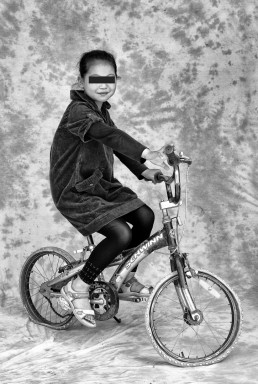
LESS THAN THREE hours west of Zhengzhou by air-conditioned express train, Xian, the provincial capital of Shaanxi, is one of China’s most ancient cities and home to the Terracotta Warriors. The Morning Tears-supported Sanyuan Children’s Village is a 90-minute drive to the north.
Unlike tranquil Ai Tong Yuan, the Sanyuan sanctuary, home to 47 children, rests beside a busy road. Articulated trucks roar by at speed, thrashing up dust and blasting their horns, and the main building is an austere construction that has been pleasingly overwhelmed by bottle-green ivy on the side of its shaded playground.
The playground has a climbing frame, a bench swing and canary-yellow exercise machines. While lunch is being prepared, children scrub their faces and hands from stainless-steel kitchen bowls at the ping-pong table.
Pictures torn from glossy magazines, of boy bands and coquettish movie starlets, add splashes of personality to the paint-flaking dormitories in which the children sleep
Sanyuan director Yang Biao, 50, is welcoming but cautious of strangers. When asked for details of children in his care, he initially and protectively sidesteps the request. Yang relents over two days, conceding that he can be wary of outsiders’ motives.
Like Kou before him, Yang produces brown-paper A4 envelopes containing individual human stories. Yang tells of one crime-orphaned youngster who arrived at Sanyuan when she was 13. Her family had lived in a mountainous area and the child’s father had been a roaming carpenter who became romantically involved with a woman in another village.
The lovers decided to kill the carpenter’s wife. Poison failed but a nail hammered into the woman’s head, Yang says, proved effective. The carpenter was executed.
“We have a boy, he is 13 now, who came to live with us last year,” says Yang. “His mother had been a teacher in Xian city. She and members of her family beat his father to death after a quarrel over gambling, and [the father’s] drug taking and drug dealing. The mother just couldn’t take it. She was jailed for 20 years.”
A portrait of Mao Zedong — the same airbrushed image that looks out across Tiananmen Square in the capital Beijing — is fastened high on the wall at the front of the Sanyuan operation’s basic classroom. Pictures torn from glossy magazines, of boy bands and coquettish movie starlets, add splashes of personality to the paint-flaking dormitories in which the children sleep, perhaps hugging the threadbare stuffed toys that are now scattered across their beds.
Occasionally, Yang reveals, children arrive at Sanyuan as babies. One child, now aged four, was newly born. “When her parents were arrested for drug dealing, her mother was ready to give birth,” Yang says. “The father was locked up, but the woman was taken to a hospital. Within a week of the baby’s delivery, the mother fled.”
Yang says the infant had not been given a name, and light drizzle was falling when police officers brought her to Sanyuan, where staff christened her. Xiao Yu means “Little Rain”.
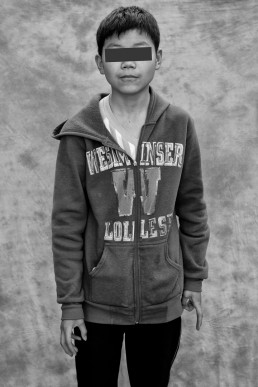
Yu Kun, 14, comes from a poor family and, according to Yang Biao, director of the Sanyuan Children’s Village, his early years were plagued by domestic conflict. When Yu Kun was three years old, his father beat him so badly that his mother killed her husband with rat poison, cutting his throat to ensure he was dead. Having pleaded mitigating circumstances, Yu Kun’s mother has been imprisoned for life. The boy has been cared for since 2004. Photo: Palani Mohan
Xiao Ze (left), aged 10, and Xiao Wei (right), 12, are brothers. Following a disagreement, their father shot and killed a local villager with his hunting rifle in 1995. The father was captured and executed in 2005 after 10 years on the run.
The boys lived with their grandfather after their father fled and were taken in at Sanyuan in 2009, when their ageing guardian could no longer cope. One hour after this photo was taken, the boys’ grandfather took them home for the May Day holidays. Photo: Palani Mohan

THE ORIGINS OF Morning Tears can be traced back to 1996, when four Chinese judges — obliged by law to hand out death sentences and lengthy jail terms — recognised the plight of the children left behind and decided to act, financing from their own pockets three facilities in and around Xian.
The judges’ cash drained away quickly, however. Their first facility closed after just two years. Three years in, and the second space wound up. The third was about to expire when Sevenants, based in Beijing at that time and employed by Handicap International as country manager for China and North Korea, discovered it. “[A colleague and I] started out as volunteers,” Sevenants says, shrugging at the memory of their naivety. “And then everything spun totally out of control.
“One day, you realise that you are thinking a lot about the children. You can’t sleep when they have problems. Anyway, after a while, we said, ‘This has gone much too far.’ We decided to source the money [required] to keep the kids going for two years and hand everything over to local people. For us, it would end, we could get on with our lives. And that’s what we did. And that went well for … about two weeks. We couldn’t walk away, we just couldn’t, and so we decided to do things properly.”
Today, Morning Tears has 100 or so staff in China, with about 40 of those being volunteers. It shores up four core projects: Ai Tong Yuan, Sanyuan and one other facility near Xian, and another close to Beijing. There are smaller operations in the cities of Chengdu and Wuhan. Morning Tears supports — at various levels, from full-care to individual assistance with schooling — about 580 children. More than 1,000 youngsters have benefitted since Morning Tears was founded. Its earliest wards are now adults.
Those numbers are just drops in an ocean of juvenile despair, however. According to the Chinese Ministry of Justice, there are 600,000 children of convicts in the country. Many are without guardians and the youngsters beg, hustle and thieve on the streets to survive. Childhood trauma manifests itself in self-harm, anti-social behaviour and nightmares, says Sevenants, and many young sufferers will also become convicts in a pan-generational cycle of misery.
The number of people executed each year in China, meanwhile, is a state secret. International watchdogs claim the country kills thousands of its citizens annually — more than the rest of the planet combined (the United States put 46 people to death in 2010). Capital punishment is employed for more than 50 crimes in China, ranging from tax evasion to murder (mitigating circumstances are considered in individual cases). Executions have traditionally been carried out by a single gunshot to the head. Lethal injection has come to the fore in the last decade.
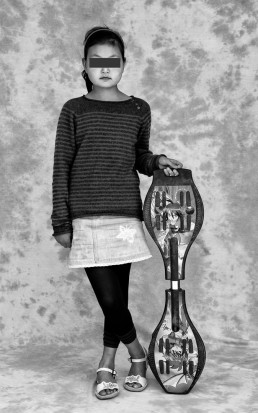
Nine-year-old Ming Ming arrived at the Ai Tong Yuan facility at the age of six. Her parents are in prison for 11 years for stealing cable to sell as scrap. ‘She finds it difficult to visit her parents [who are in different prisons] because her father always complains about her mother, and her mother complains about her father,’ says Kou. ‘The parents can’t see each other, so they argue through the child. Ming Ming doesn’t like prison visits.’ Photo: Palani Mohan
Liu Fei, aged eight, arrived at Sanyuan in March. His parents had been jailed for 20 years for being members of an organised gang of car thieves. The gang had been operating for at least five years, and for much of that time — since Liu Fei was three — the boy had been kept with the family’s sheep. ‘He lived with the sheep, he ate with the sheep,’ says Yang. ‘When he came here he could not walk properly. He has problems communicating.’ Photo: Palani Mohan
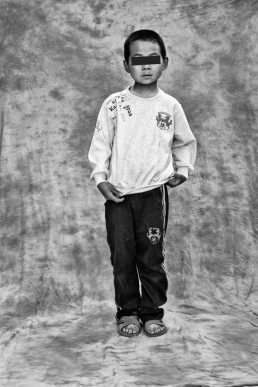
BACK AT THE AI Tong Yuan Coming Home Project, the children have finished a simple lunch of noodle soup and steamed buns. Some take naps. Some bend over exercise books with colouring pencils, sketching houses, apple trees and rainbows. Huan Huan watches television and Sevenants is reading a story to cross-legged children in one of the dormitories. Niu Niu plays with a discarded mineral-water bottle.
Inside the two-metre-high wrought-iron fence and wall that surround the compound, the young residents of the project are safe amongst their own. Life can be less secure beyond the perimeter, with the children of convicts spurned for bringing bad luck and for carrying criminal tendencies in their DNA.
Kou cites the case of Meng Meng, who is now 12. Meng Meng’s father was incarcerated when she was four, and her mother deserted her. Meng Meng then lived with her grandfather, but his neighbours refused to accept the girl into their community. Through those neighbours, Meng Meng discovered that her father was a rapist. “She refuses to visit her father in prison,” says Kou.
Kou tells of Xiao Yan, another 12-year-old, who arrived when he was eight. The boy’s father is in prison for life for theft. Xiao Yan’s mother rejected him and he was sent to live with his uncle. Neighbours in his uncle’s village shunned Xiao Yan as the offspring of a felon. “He became a troublemaker,” Kou says. “[Xiao Yan] told me that he didn’t want to be that way, but he couldn’t make people understand that he was not a bad kid. In his mind, he was left by his father, by his mother, then by his uncle. Nobody wanted him.”
“Girls, maybe 14 or 15 years old, have been taken away because relatives want to marry them off. I worry when a girl of that age is taken from us”
Morning Tears founder Koen Sevenants
Sevenants believes it is preferable for children to be cared for by family members, and there have been instances of children being taken away after years in Morning Tears’ care by relatives. Blood ties, however, can prove less than ideal.
“A child might go to an aunt or a grandparent, but their education could stop,” Sevenants says. “They will have to earn their keep, they might be beaten and then, after a time, they can be cast aside and traumatised for a second time. We’ve had kids arrive back here with [bruises] and cuts. They are underweight, they haven’t been to school for years …”
There are many reasons, Sevenants believes, why relatives might collect children. “We had one case of pure child torture — a brother and a sister, 13 and 10 years old,” Sevenants says. “Their parents had been executed for drug smuggling and an uncle was convinced that money had been hidden away. The uncle tied [the children] to chairs and beat them for information. When he failed to find money, he just returned them to us.”
Also troubling is the fact then when a young woman marries in rural China, tradition dictates that the groom’s family must pay the bride’s kin. “Girls, maybe 14 or 15 years old, have been taken away because relatives want to marry them off,” says Sevenants. “I worry when a girl of that age is taken from us.”
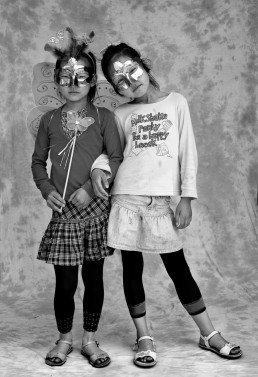
The father of Yi Li (left), aged nine, is in prison for stealing. Her mother divorced him, remarried and left. Yi Li has been cared for at Ai Tong Yuan for three years. ‘Yi Li is an angel,’ says Kou. ‘She’s patient, she helps the caregivers and she’s very smart, top of her class … everyone loves her.’
The parents of Dan Dan (right), also nine years old, are in jail for poisoning a man who regularly made unwelcome advances towards her mother. They were sentenced to death for murder with a two-year reprieve, meaning their sentences could be commuted to life imprisonment. ‘Dan Dan is a very pretty girl and she knows it,’ says Kou. ‘She’s not a great student. Every day her caregivers complain because she will spend an hour or more on her hair.’ Photo: Palani Mohan
Siblings Xiao Wan (left) and Xiao Yi (right) are aged nine and six respectively. Their father received the death sentence for murdering their mother. His sentence has been deferred for behaviour appraisal and may be commuted to life. ‘They have visited their father in prison, but they think he is the devil,’ says Kou. ‘They have a lot of nightmares.’
Kou has found the case difficult to handle. ‘Xiao Wan told me that his father had often been abusive to his mother and there was always violence at home,’ she says. Photo: Palani Mohan
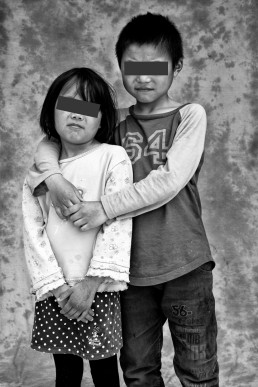
OCCASIONALLY, EMOTIONALLY damaged children will reject protection, as was the case with Xiao Sheng, whose mother stabbed and killed his father when the boy was just five. She was executed and Xiao Sheng was cared for until he was 14. “He was eaten up by anger,” says Sevenants. “He would not calm down. He was convinced his mother had been innocent. He wanted revenge and he left us at too young an age.” With nowhere else to turn, Xiao Sheng took a job in a coalmine. He died in a mining accident at the age of 15.
In the same way that communities have scorned individual children, Morning Tears projects have also come under attack. “In 2000 we had a security problem and had to move one of our facilities,” Sevenants says. “Our children were being beaten.”
A public-relations exercise was put into place, to reposition the home as a community project where all would be welcome. The walls would come down. “We wanted to hold film showings in the evenings, invite local children to join us,” says Sevenants. “We had to give it up, build a wall again, lock the gates — not to keep our kids in but to keep local people out; to stop them from stealing things and treating our children badly.”
And the psychologically exhausting headaches do not stop there, with the pain of the children transferring to their adult protectors. Kou, especially, has confronted demons.
Kou’s mother killed her violent father in 1996, while she was studying English at university in Xian. “I am one of [these children]. I feel how they feel, and I can show them something, but I’m not always sure what it is,” Kou says. “They feel safe with me. It’s difficult to put into the words, but I strongly believe that the children understand me.”

Jia Yu is 11 years old. His father is incarcerated for stealing and his mother abandoned the boy. ‘Many of these families are very poor and depend totally on the father,’ says Kou. ‘When a father goes to prison, there is no income at all, so mothers often leave and start again.’ Photo: Palani Mohan
Xiao Yan, 12, arrived at Ai Tong Yuan when he was eight. His father is in prison for life for robbery. His mother abandoned him. ‘He was a very troubled boy [on arrival], having fights with caregivers and other kids,’ says Kou. ‘Now he’s a sweetheart.’
Kou says Xiao Yan suffers from abandonment issues. ‘We were holding a drawing exercise, helping the kids to express their feelings, and he drew a black heart,’ she says. ‘I asked him why the dark colour and he said, ‘This is the feeling I have for my mother.’’ Photo: Palani Mohan
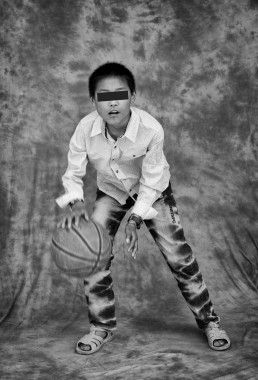
SEVENANTS HAS ALSO struggled with emotional fall-out. He no longer attends when children visit parents in prison. “There’s a lot of pain involved and it gets into your system,” the Belgian says through a sigh. “They say things become easier with time, but I find it more difficult now than in the past. I try to keep distance, to limit involvement. I had to seek personal assistance at one point, to help me cope with things, to digest things.”
Caregiver Hong Li, 30, has a five-year-old son of her own. “The first year, when new children arrived and I heard their stories, I would find it so heartbreaking,” Hong says. “I couldn’t control myself. I cried a lot.”
These days, Sevenants focuses on the fundraising side of Morning Tears, which now has presence in the United States, Belgium, the Netherlands, Denmark, France, Italy, Germany and Spain, as well as mainland China and Cambodia. Basic care for each Chinese child costs around Rmb350 (then about US$6) a month.
“That not only includes food, clothes, housing, but also a meaningful life with school and hobbies, with psychological and personality development assistance,” he says. “But prices are going up and inflation is a problem. Last year the price of pork [in China] rose fourfold.”
Companies and corporations … when they hear ‘death penalty’ and ‘criminals’, they worry that we might be a human-rights organisation that opposes the Chinese government
Sevenants on drumming up funding
The global economic crisis has curtailed donations, but Sevenants has a more fear-led than finance-driven challenge to overcome. “People are afraid by what we do,” he says. “Companies and corporations, of course, donate money to community causes. When they hear ‘death penalty’ and ‘criminals’, they worry that we might be a human-rights organisation that opposes the Chinese government. They don’t want to be associated with us. They are scared of us.”
That ill-informed attitude is frustrating, especially considering that Morning Tears and the Chinese authorities collaborate. The Ai Tong Yuan Coming Home Project is jointly operated by Morning Tears and the state-run Zhengzhou Children Protection Centre. Sevenants is a consultant to the Chinese government in the upgrade of child-protection laws and procedures. Morning Tears is legally registered as an NGO in China, enabling it to issue state-approved receipts so that donations are tax deductible.
In 2010, in fact, China’s central government rewarded Morning Tears with its ultimate stamp of approval, presenting the NGO with the China Charity Award — the nation’s most prestigious honour in that field. “Actually, I think they may have given the award to help us,” says Sevenants. “To show that it’s okay to support what we do.”
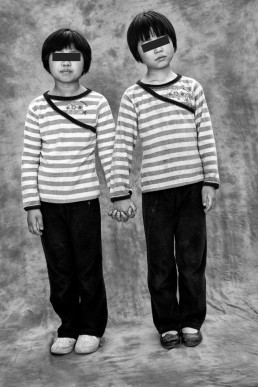
Coming from a poor rural family, Li Wei (left), aged eight, has been cared for at Sanyuan for two years. Her father was a migrant worker making a meagre living as a labourer in Xian. When his employer held back his wages, Li Wei’s father attacked the man and received seven years for assault. Her mother suffers from schizophrenia.
The mother of Wang Yi (right), also eight, suffers mental-health problems and left the family in 2006. Her father died in 2009 of pneumonia. She has been cared for at Sanyuan since 2010. Photo: Palani Mohan
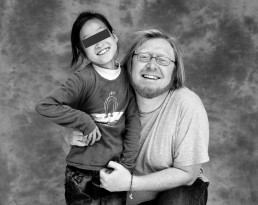
‘In the past, 90 per cent of the children we supported were from rural, financially disadvantaged backgrounds,’ says Koen Sevenants, the general director of Morning Tears. ‘That has changed and there is more diversity these days. Urban drugs have played a large part, and we are increasingly taking in kids originally from quite well-off families.’ Photo: Palani Mohan
WITH THE SUN SETTING behind a neighboruing factory, the oppressive heat of the day subsides and the children of the Ai Tong Yuan Coming Home Project have finished classes. Dan Dan, aged nine, claps and slaps and grins through a lively session of patter-cake with Kou. Eight-year-old Lu Lu slaloms by on the single skateboard shared by all of the 44 children. Dan Dan and Lu Lu are daughters of convicted murderers.
Two studious children attack their homework, standing at the outdoor ping-pong table. Faded sweatshirts and battered canvas sneakers drip-dry on a railing and weary caregivers, who have been digging an allotment and planting peanuts, wipe sweat from sun-darkened brows. If the peanuts flourish, sweet potatoes and melons, perhaps even Niu Niu’s favourite strawberries, might follow.
Despite the myriad problems they confront every day, Kou, Sevenants and their colleagues agree: the rewards of their cause outweigh the heartache. “Relearning how to play, to trust and make attachments, is very important,” Sevenants says. “We give children a safe environment in which to do that. It’s a glorious moment, it feels fantastic, when you see a child, who was terribly traumatised on arrival, start to play again.”
Caregiver Hong, who has been with the facility of three years, concurs. “I’ve had many chances to take jobs with better salaries, better conditions, but then I start to feel upset,” Hong says. “I end up saying no. The children and I have become so close.”
Hong’s friend and colleague Dandan, 22, has also been a caregiver for three years. “I’ve seen many positive changes,” she says. “Little Fanfan [believed to be aged seven] arrived two years ago. She wouldn’t speak — not a single word — for two or three months. She would cry all the time. She would kick and hit out at anyone who came close. Now she’s happy and polite. She loves to share time with the other children.”
For Kou, the experience has been especially life-affirming, assisting her in dealing with her own distressing past. “The way the kids express their inner anger … I can see that, well, maybe that is not always the right way,” Kou says. “Sometimes [in the past], when I have reacted to things, I have not always been able to control myself, to see the right way and the wrong way. The children have taught me a lot.”
AN HOUR PASSES and stars are appearing in the clear evening sky. Caregivers are rounding up the children to clean their teeth before bed.
Niu Niu drops the day’s last strawberry into the dirt and one of the project’s two pet dogs — strays taken in from the neighbourhood — sniffs at the discarded fruit. Niu Niu fashions her chubby fingers into a V and raises them towards the photographer’s camera. She looks directly into the lens, her dark eyes sparkle and she smiles an innocent’s smile. ◉
Children’s names have been changed. Their stories and censored portraits have been approved for publication by their guardians at the Ai Tong Yuan Coming Home Project and Sanyuan Children’s Village.
This long-form feature ran in Hong Kong's Post Magazine and now-defunct Australian website The Global Mail in early 2013. They are no longer online. Morning Tears' Facebook page is here.
SHARE
Soldiers Waging Peace
A veteran civil rights activist says GIs were on the frontline of the anti-Vietnam-war movement, organising protests, publishing underground newspapers and serving jail time to end the fighting in Southeast Asia.
THE STEREOTYPICAL IMAGE of the Vietnam war veteran, returning to the United States after an arduous tour of duty, only to be spat upon and cursed as a murderer by sneering, long-haired peace protestors, is seared into the American psyche like a scar from a white-hot burst of napalm. The accepted belief is that weary veterans trudged home to be condemned, cold-shouldered, even physically assaulted — simply for doing their duty.
In popular culture, the phenomenon was memorably depicted in 1982 movie First Blood, which unleashed Sylvester Stallone’s traumatised John Rambo on the world. “I did what I had to do to win, but somebody wouldn’t let us win,” the grudge-holding former Green Beret howls at the film’s climax. “Then I come back to the world and I see all those maggots at the airport. Protesting me. Spitting. Calling me baby killer …”
Veteran American activist Ron Carver insists that GIs returning from Southeast Asia to be spat upon at home is a “myth”, arguing that soldiers — even soldiers on active duty — were at the heart of the 1960s and ’70s peace movement in the US. Returning servicemen and women were so appalled, he says, by what they had seen some 14,000 kilometres away from Washington DC — by what they had done, in some cases — that they became the most motivated and powerful voices against the war.
“Anti-war GIs led every major peace march in America from 1968 on,” claims 71-year-old Carver, an associate fellow at Washington-based progressive think tank Institute for Policy Studies. “They were leaders of the anti-war movement. The movement was not in conflict with the soldiers. The anti-war cry was supportive of the soldiers. It was, ‘Bring the troops home’. It was, ‘Bring them home alive.’”
IT’S A BLUE-SKY Saturday morning in March in Ho Chi Minh City, capital of South Vietnam during the war and then called Saigon. Carver is guiding me through an exhibition at the War Remnants Museum. The facility remembers the drawn-out conflict that Vietnamese today call the Resistance War Against America and which, in one form or another, lasted from November 1, 1955, to the fall of Saigon to the communist North on April 30, 1975. The city was renamed in honour of the victor’s late revolutionary leader a year later.
Captured or discarded US tanks, Chinook helicopters, armoured personnel carriers and F-111 tactical bombers and other attack aircraft are parked at the museum’s entrance. The new exhibition, which took Carver more than a year to curate, is called Waging Peace and being held in a dedicated room adjacent to the bustling lobby.
Through 80 or so exhibits — photographs, case studies, official documents, letters, newspaper articles and underground newspapers produced by GIs — the exhibition salutes the American troops from the anti-war movement who, Carver says, were crucial to bringing the conflict to an end.
“I wanted to cover all the different types of resistance, so we include GIs who refused to deploy and went to jail, we have those who went to Vietnam but refused to go into combat, or went into combat and then stopped fighting. We have soldiers who led marches for peace in the US and elsewhere, and we have people who deserted and went into exile.”
The exhibition appears popular, attracting a curious brew of singlet-wearing backpackers, Vietnamese families and, one suspects, the occasional American vet footslogging over old stamping grounds. Just days earlier, in fact, more than a dozen veterans featured in Waging Peace flew in for the opening.
Among them was Susan Schnall, and a group has gathered around a dramatic photograph of her heading up an anti-war march in San Francisco in 1968 (opening picture), when she was a 25-year-old navy nurse. Schnall, originally from northern California and whose father was killed on a beachhead while serving in Guam in the Second World War, when she was just 14 months old, worked at Oak Knoll Naval Hospital in Oakland, California.
“I took care mostly of young men who came back from Vietnam wounded, and heard their terrible screams of pain during the night,” Schnall says by phone from her home in New York. “It wasn’t just their distress. I heard the terrible racist epithets they used towards the Vietnamese, the hatred they had, and I thought, ‘This war is 8,000 miles away, against people we don’t know, who have never been in the United States, never came here to harm anybody.’ I didn’t understand what we were doing so far away.”
Schnall was an organiser of the march, which she needed to promote and so printed 20,000 flyers. “I had a friend who was a pilot, so we took them up in a plane we rented and dropped them on military bases in the Bay Area,” says the 75-year-old, who wears her uniform in the photograph. “We also went to the Alameda Naval Air Station and dropped them on the USS Ranger.”
Schnall was arrested, charged with conduct unbecoming an officer and undermining the military. She was sentenced to six months hard labour.
WAGING PEACE OPENED on March 19, just three days after the 50th anniversary of the My Lai massacre, when a company of American soldiers killed hundreds of unarmed Vietnamese civilians — men beyond fighting age, women, children and infants — in the hamlet of My Lai in southern Vietnam’s Quảng Ngãi province. A number of women and girls were raped, including some not yet teenagers. Though army officers covered up the slaughter for more than a year, the truth was revealed in November 1969 to global outrage.
It was a brutal turning point for Mike Wong, whose portrait hangs in the Waging Peace exhibition. In the black-and-white photograph, the Chinese-American holds up the official notification of his “Undesirable Discharge from the Armed Forces of the United States of America”.
Wong, who also attended the exhibition opening in Vietnam, was born in San Francisco in 1947. His mother was also born in the city, to immigrants from China’s Guangdong province. His father was from Guangdong too, but died when Wong was a young child. He was brought up by his mother to see himself as a patriotic American.
“While in high school, I was in the JROTC, the Junior Reserve Officers’ Training Corps in the United States, that is used to provide basic military training and indoctrination into the military mind-set and as a recruiting tool,” Wong, now 70, says from his home in San Francisco. “I was really gung ho. I believed everything that my government said — that the United States was always the good guy. I wanted to join the military right out of high school but my mother said, ‘No, you need to go to college,’ and being a good Chinese kid, I did what my parent told me to do.”
Wong was exposed to the growing counterculture while at college in San Francisco and in 1968, still a student, he received his draft notice, joining the army in January 1969. “I enlisted to get in the medics, so I wouldn’t have to kill anybody,” he says. “Then, once I was in the army, more and more soldiers were coming back, they might have been sergeants or instructors, and they were telling us about what was really going on over there. I heard stories about murdering civilians, about torture.”
Then came the nauseating gut punch of My Lai.
“Then, once I was in the army, more and more soldiers were coming back … and they were telling us about what was really going on over there. I heard stories about murdering civilians, about torture”
Deserter Mike Wong
“My Lai hit the front pages and had a profound effect on me,” Wong says. “Most of my unit then turned against the war. We almost had a riot at one point. Soldiers were saying, ‘They can’t make us do this — go to Vietnam and kill women and children.’”
In December 1969, Wong, while assigned to a hospital in Texas, received his orders for Vietnam. “I took two weeks leave, came home to San Francisco, got a lawyer and went Awol, a crime in the military,” he says. “Then I turned myself in to the Presidio stockade, an army jail at a base in San Francisco. I refused my orders for Vietnam. They had 15 years of charges hanging over me.”
Wong says there were so many soldiers trying to avoid Vietnam at that time that locking up everyone was not an option.
“So they released me from the stockade and put me back on Vietnam orders. I hid out for a while. While I was hiding out in San Francisco, I was going through a lot of mental turmoil, trying to decide what to do,” Wong says. “At one point, I decided I needed to stop thinking about this for a little while, so I went to Chinatown, to see a Chinese movie. I’m American-born, so I speak only a few words of Chinese, but you can tell what’s going on from the action. So I paid and went in. I didn’t even pay attention to what movie was showing.”
The film was about the Chinese struggle against the Japanese in the Second World War. “The Japanese were using the same tactics that we had been taught in the US military, and the Chinese were using guerrilla tactics like the North Vietnamese,” Wong says. “I realised that if I went to Vietnam, I would be doing to the Vietnamese exactly what the Japanese did to the Chinese in World War II.”
His decision was made. “I’m not going to Vietnam,” Wong told himself. “With the help of the underground railroad, I deserted to Canada.”
IT IS EARLY AFTERNOON when Carver and I quit the museum. The day’s temperature is peaking at 36 degrees Celsius, so we retire to the air-conditioned coffee shop across from the museum’s entrance. The cafe is next door to Carver’s two-star, US$25-a-night hotel, where the 20-something receptionist refers to him with a fond smile as “Mr Ron”. He orders a “to die for” pineapple smoothie.
In his loose-fitting, short-sleeved blue shirt, beige slacks and sensible shoes, with bald pate above his remaining white hair, Carver has the demeanour of a twinkle-eyed great uncle. A simple tattoo of a dove nests where thumb meets index finger on his right hand.
Carver’s career as an activist began in 1964, “the day I got out of high school in Boston”, when he headed south as a volunteer in the civil rights movement, working for the summer in the Atlanta headquarters of the Student Nonviolent Coordinated Committee.
Eighteen years old and just two weeks out of school, Carver was on duty when three civil rights workers, investigating the burning of a church in Mississippi, went missing on June 21, 1964. “I was given a list of all the jails and hospitals, state police and the FBI, and I called them all. I actually called the jail where [the three] were being held and the jailer’s wife told me they were not there, but later we found out that they were. Out of frustration, I called the FBI and they refused to do anything.”
The trio had been arrested for speeding, held in jail before being released and then followed. Their car was pulled over. They were abducted, driven to another location, shot at close range and buried. The case became known as the Mississippi Burning murders, and the direction of Carver’s life had been decided.
He attended his first anti-Vietnam war march in April 1965, in Washington DC. “By then, after my experience with the FBI, I’d become very sceptical about our government,” he says. “And when I began reading about the war and the two sides, pro and against, I was hesitant to believe them.”
After a year working in Mississippi, Carver went to Columbia University in New York to study American history. His time there further cemented his anti-authority beliefs. “In 1968, students at my university and others shut down and took over five buildings, including the main administration building,” he says. “We were arrested. I was severely beaten. I was 22.”
THE FACT THAT WE are discussing the anti-war movement in a coffee shop is apt because, Carver says, countless cups of Joe fuelled the GI resistance to Vietnam.
In the late 1960s, he explains, a network of coffee houses began to spring up near army bases in the US. “They became magnets for the anti-war soldiers. They could find each other and realise they were not alone. There they could plan protests, marches, demonstrations on base or off base.”
The first such cafe opened near Fort Jackson in Columbia, South Carolina, in January 1968. It was called UFO, Carver says, “as if it had dropped from outer space — it was so different from everything else culturally in Columbia”.
“There was an anti-war activist, a civilian from San Francisco, named Fred Gardner. He came up with the idea,” he continues. “He realised that most army bases are in remote areas and little army towns grow up next to them, but those towns are horrible, exploitative places.
“So when GIs get leave, what are their choices? Bars, jewellery stores with staff outside hawking, saying, ‘Hey GI, come buy something for your mother, buy something for your girlfriend,’ because they know people have just been paid. Or whorehouses. And he said, what if we open a San Francisco-style cabaret, he called it, a counter-culture location with rock and roll and posters on the walls.”
After graduation, Carver worked in such a coffee house close to Fort Dix in New Jersey, and later at another near Fort McClellan in Alabama. “We were all volunteers, no one got paid,” he says.
GI coffee houses soon proliferated across the country, drawing disaffected servicemen and also attracting interest — welcome and unwelcome — from elsewhere. Oleo Strut coffee house (named for a vertical shock absorber on a helicopter) was outside Fort Hood. When anti-war actress Jane Fonda visited to help out at Oleo Strut for a week — doing chores, listening to soldiers stories and speaking at a peace rally — a headline in a local newspaper, referencing Fonda’s role in a 1960s sci-fi flick, read: “Barbarella comes to Killeen, Texas.”
The coffee shops were also the unofficial newsrooms of underground newspapers produced by anti-war GIs, and they feature heavily in the Waging Peace exhibition. “They were the social media of their time,” enthuses Carver, adding that there were thousands of such DIY publications at the height of the war, packed with first-hand accounts from the frontline and damning information that military brass tried to suppress.
Titles included Aboveground (published at Fort Carson, Colorado), Gigline (“By GI’s for GI’s”; Fort Bliss, Texas), RAP! (Fort Benning, Georgia), Shakedown (Fort Dix) and Attitude Check (Camp Pendleton, California). Another portrait in the exhibition shows Skip Delano, who was assigned to Fort McClellan for training in the use of Agent Orange and other poisonous chemicals used in America’s herbicidal warfare programme. Delano published the newspaper Left Face while still on active duty.
Many such publications were free to GIs and carried on their front pages a statement that they were a soldier’s personal property and could not be confiscated. The phenomenon even spread overseas: The Whig was distributed at Clark Air Force Base in the Philippines; ACT was for US deserters hiding out in France.
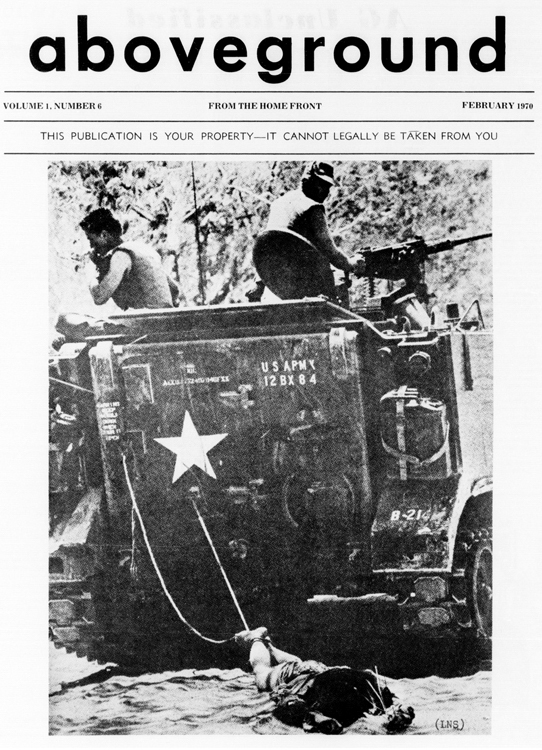
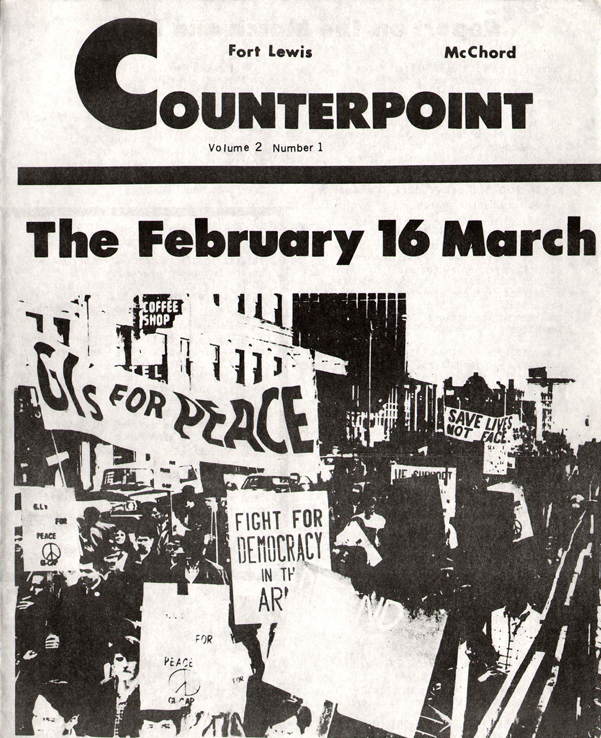
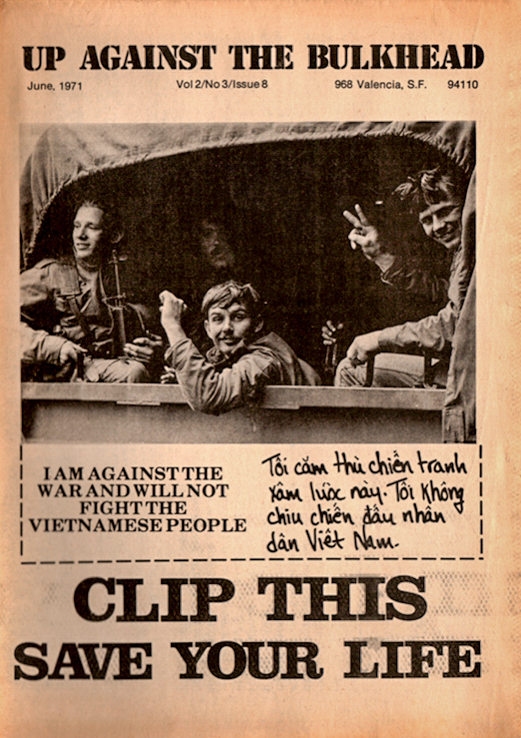
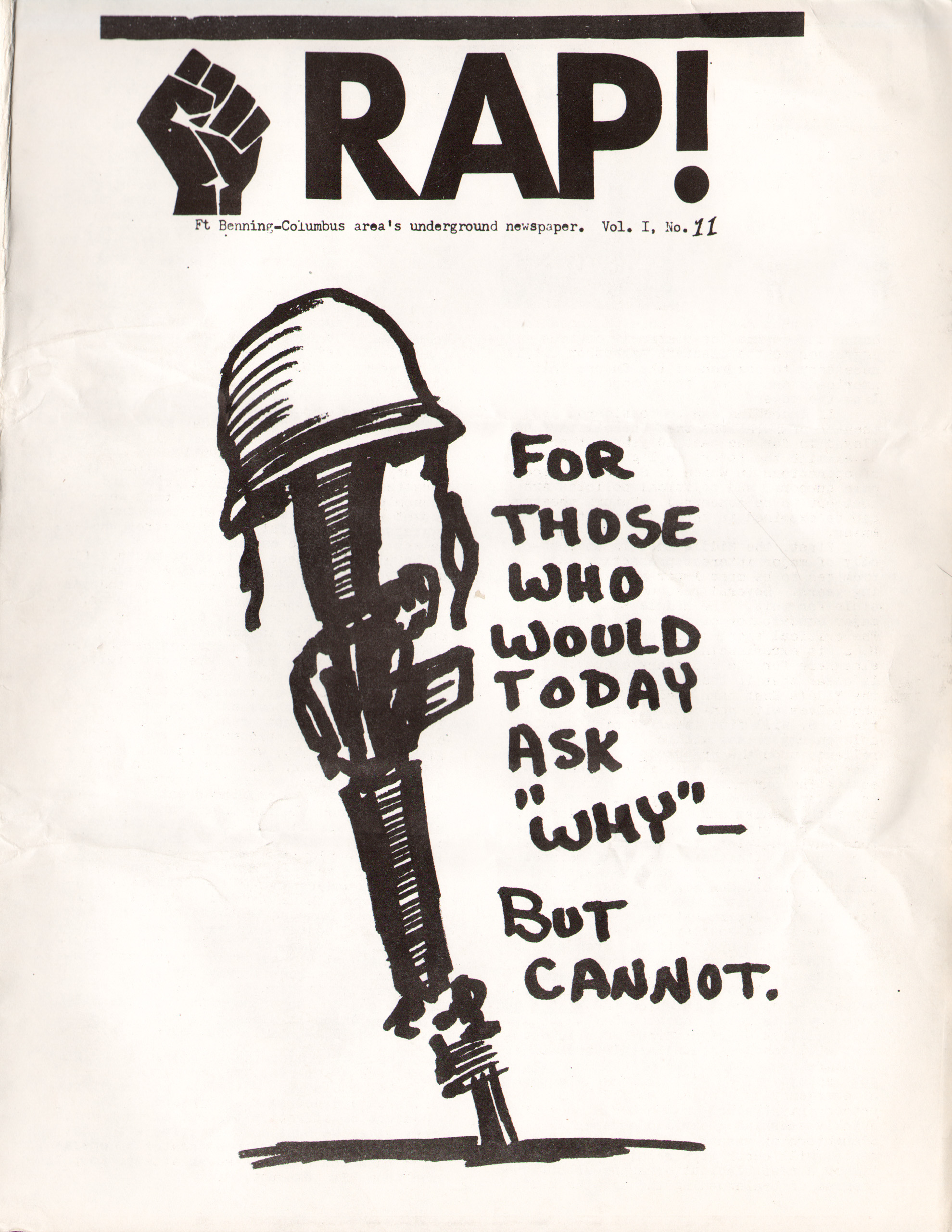

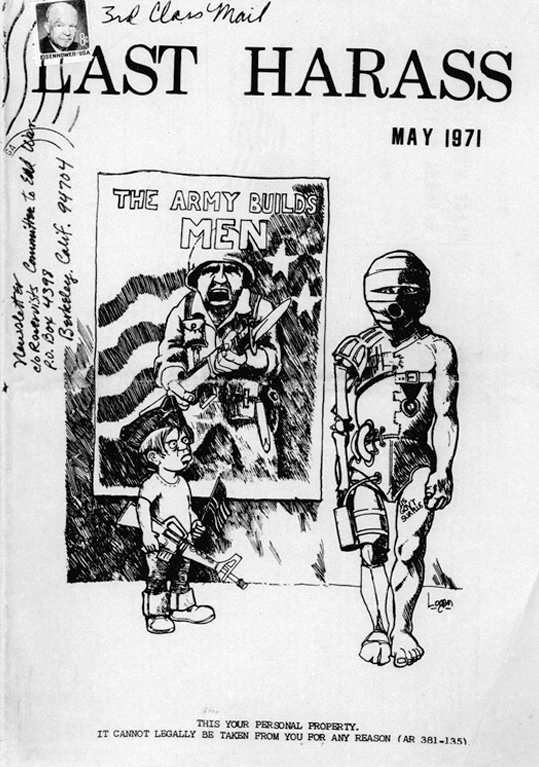

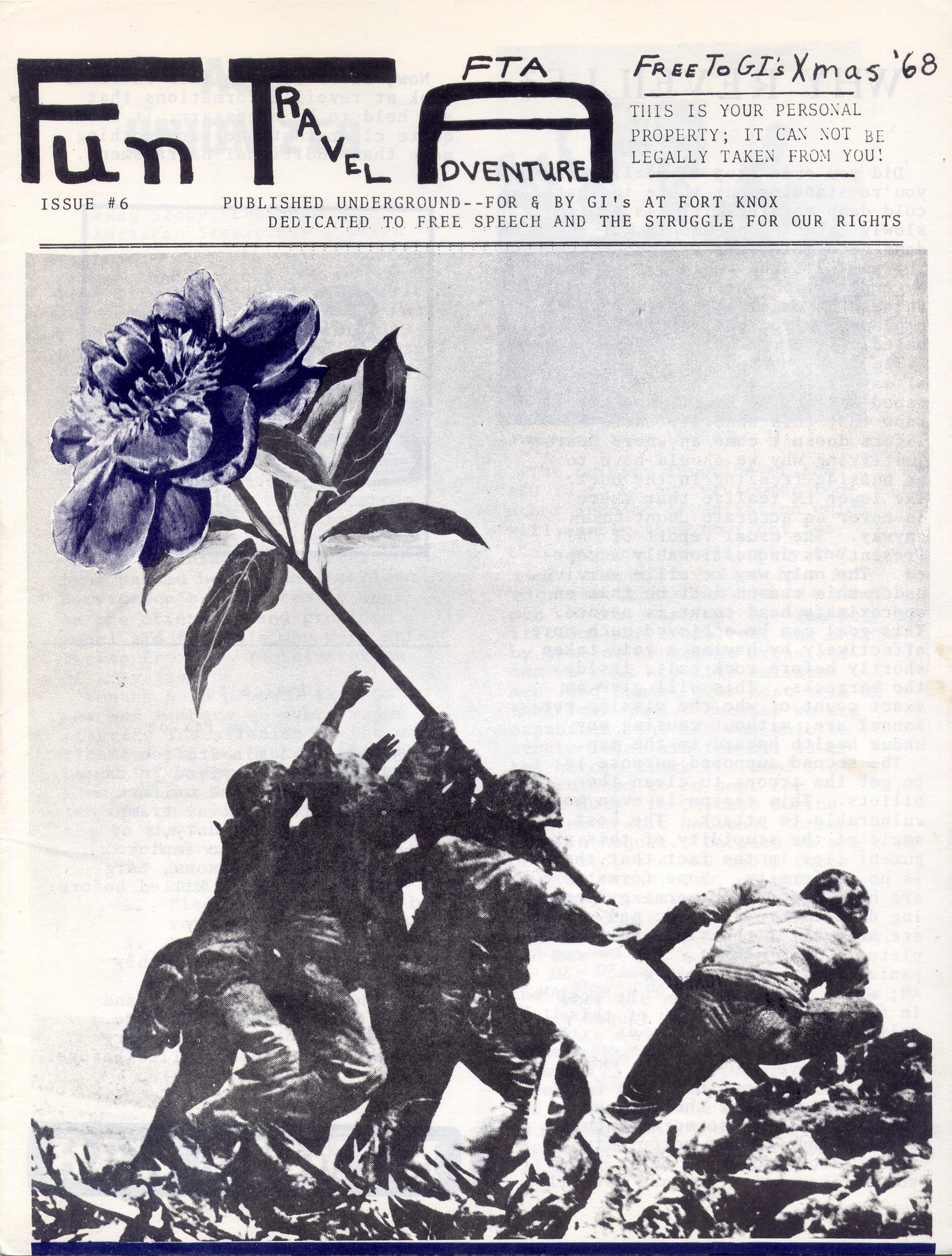
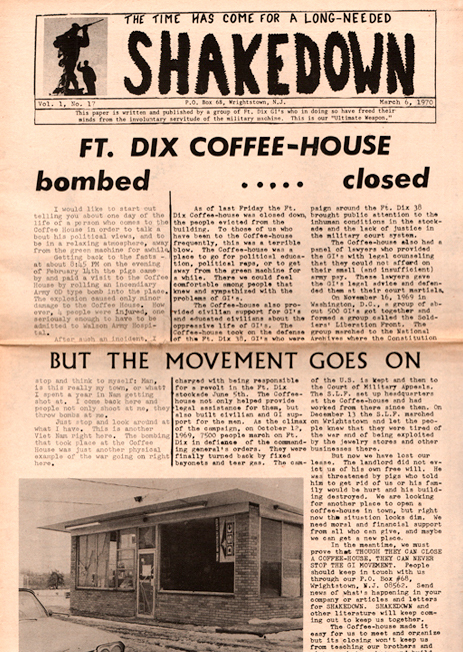
Underground newspapers proliferated on US military bases in the 1960s and '70s. Photos: Waging Peace
The military hit back against the coffee houses and the underground newspapers, using police to shut them down. Some were even bombed by vigilantes, including the coffee house where Carver worked at near Fort Dix. “The first time, somebody opened the door and threw in a concussion hand grenade,” he claims. “It did not do as much damage as a fragmentation grenade, but still injured one soldier.”
Others coffee houses burned to the ground, Carver says, adding that one near Camp Pendleton was shot into, wounding marine Jesse Woodward.
But Carver also admits that the GI resistance was not always peaceful, highlighting increasing instances of “fragging” in Vietnam as the war dragged on. The term describes the deliberate killing or attempted killing by a soldier of his or her superiors, usually using a fragmentation grenade. According to US army veteran and historian George Lepre, who has written extensively on the subject, the total number of known and suspected fragging cases by explosives in Vietnam from 1969 to 1972 was close to 900, with 99 deaths and many injuries.
“There were many recorded instance of soldiers killing their own officers,” says Carver. “If their lieutenant was too gung ho, asking them to do crazy things, at night they would throw a grenade into his tent and kill him …There’s nothing comparable in US military history.”
A NUMBER OF THE most anti-war GIs rebelled as a direct response to their own actions. One was William Short, a platoon sergeant in Vietnam who, alongside two colleagues, went on strike against the war, refusing to go on combat operations in April 1969.
“I was charged with leading a conspiracy, a mutiny against the US, later reduced to refusing a direct order, primarily because of pressure coming from the anti-war movement in the states,” Short, now 70, says from Los Angeles.
Ambivalent about the war from the beginning, “about the truthfulness of the government and whether the war was righteous”, Short was assigned to the first infantry division, operating out of Lai Ke about 60 kilometres northwest of Saigon. “Our job was to stop infiltration from the North coming down through the Ho Chi Minh Trail,” he says. “We would typically work out of small base camps in the middle of the jungle … and we would spend maybe three to five days patrolling the jungle on search and destroy missions, and ambush missions.”
Short says that it was a more senior-ranking sergeant, “somebody I looked up to for guidance”, who “got me started booby-trapping the bodies” of enemy killed in battle.
“I thought of the Second World War and Nazi soldiers involved in atrocities, the extermination camps, saying they were just following orders. I thought, I’ve gotta do something”
William Short, who in 1969 refused to go on combat operations
“We would pull the safety pin and put a grenade under the rib cage, just beneath the breast, so that it would hold pressure on the lever,” he says. “Then, when somebody would come along, maybe a friend of that soldier, and roll the body over to identify them, or in grief, the grenade would go off in his face.”
One night, having booby-trapped a body and moved on, Short heard a grenade go off.
“When you are in a platoon-size ambush, you are firing along with 20 other guys and you can wash yourself a little bit clean of what you are doing by saying, ‘I don’t know if my bullets actually killed that person, I’m just shooting with everybody else’ … But when that grenade went off that night, I started thinking, well, I have to face the fact that I really am doing what I’m doing. How can I justify it?
“I thought of the Second World War and Nazi soldiers involved in atrocities, the extermination camps, saying they were just following orders. I thought, I’ve gotta do something.”
AS MANY AS THREE million Americans served in uniform in Vietnam. While Carver does not claim anything like the majority were actively anti-war, and his claim that spitting on soldiers was a myth continues to be hotly debated, he insists that those who did fight back made a huge difference to public opinion.
Asked to name somebody he most admires from the movement, Carver appears reticent to answer, but he recalls Captain Howard Levy, a US army doctor who was court-martialled in 1967 for refusing to provide medical training to Special Forces heading for Vietnam. Levy, 30, a dermatologist, was convicted at Fort Jackson, South Carolina, for disobedience and seeking to promote disloyalty. He served 26 months in prison before becoming active in coffee house-organised protests in army towns across the US.
“He came to this conclusion three months before his [time in the military] was due to be over,” Carver says of Levy. “He never went to Vietnam. He wasn’t going to be sent to Vietnam. He could have played out those next three months and gone home, but as a matter of conscience, he couldn’t do it.”
“A lot of the early resistors,” Carver continues, “from 1965, ’66, ’67, before the movement grew larger, they had no idea that they were going to be inspiring other people to join, to take risks and stand for conscience,” Carver says. “They were much more alone.”
Over time, the peace movement grew to be so substantial that sentences were sometimes reduced or discarded in the face of popular opposition.
Schnall, who dropped the anti-war flyers from a plane over San Francisco, was not required to do her six months hard labour but to go back to duties. Now retired, she worked for 31 years in administration of public hospitals and is now active in supporting those suffering the poisonous legacy of Agent Orange. She is also president of the New York City chapter of Veterans for Peace.
Short was court-martialled twice for refusing to deploy, sentenced to two six-month prison sentences, busted from sergeant to private and imprisoned in Long Binh jail in South Vietnam. He was held for 64 days before being released.
On his return from Vietnam, Short joined the GI resistance movement, attended art school and today still runs his own photography business in Los Angeles. He took the portraits of Wong, Delano and others included in Waging Peace in the early 90s, while producing with his journalist wife a book called A Matter of Conscience, about anti-war troops and their individual experiences.
“By 1968, ’69, half were for the war and half were against, so it was clear to me that if I were to go to Vietnam and fight, half the country would say I was a hero, half would say I was a villain, a child killer”
Mike Wong
Wong remained in Canada for five years, completing a bachelor’s degree in social science at York University in Toronto. He returned to the US when the war ended. “They had a deal going that if you were an Awol soldier and turned yourself in at Fort Dix, New Jersey, and accepted a court martial and pleaded guilty to long-term Awol, they would give you an undesirable discharge and let it go at that,” he says.
He eventually took a master’s degree in social work and spent his working life in that field before retirement, the last 17 years providing care to elderly patients. Today he is active in highlighting the plight of and fighting for reparations for Asia’s comfort women during the Second World War.
Wong has no regrets about his decision to desert. “There was a strong feeling in the Chinese community that the Vietnam War was a rerun of China,” he says. “The Saigon government was corrupt and did not represent the majority of the people; [it was] the same kind of corruption that undermined the Chinese nationalists during their war.”
Wong also says that he, like many other soldiers, was forced into a no-win situation. “The country at the time was very divided,” he says. “By 1968, ’69, half were for the war and half were against, so it was clear to me that if I were to go to Vietnam and fight, half the country would say I was a hero, half would say I was a villain, a child killer.
“On the other hand, should I refuse to fight, either by going to jail or desertion or anything else, half would say I was a hero and half would say I was a coward. That was the struggle I went through, deciding where I stood with that. Finally I decided that having to choose between being called a murderer or a coward, I choose a coward.”
BACK IN HO CHI MINH City, Carver lists his reasons for creating the Waging Peace exhibition: “To honour the soldiers who led these revolts within the army,” he says. “To correct history; to inspire the younger generation that is now fighting for social justice, fighting for gun control, fighting against US militarism; to say that even though the odds look overwhelmingly in favour of this unmoored, right-wing government of ours, it’s worth fighting for what you believe in, and to organise.
“These guys organised within the army, carefully talking one on one, handed out their underground newspapers one to one, held discussions at the coffee houses, in the barracks, in Vietnam. There was an amazing level of organisation.
“I don’t want people to think this exhibition is just a nostalgic exercise, just one old crony honouring fellow old cronies. That’s not what it’s about.”
Just hours after Carver says those words, those 14,000km away in Washington DC, the student-led March for Our Lives will draw an estimated 800,0000 people onto the streets to demand greater gun control in the US.
With hundreds of supporting marches and other events held across the nation, total turnout will be estimated at between 1.2 million and two million people, making the action one of the largest protests ever held on American soil. ◉
The Waging Peace exhibition was held in Ho Chi Minh City in the spring of 2018, before moving to Notre Dame University in the US.
Cambodia's Floating Doctors
With the emergence of Covid-19, the world applauds its frontline medical staff, whose life-saving struggles usually go unseen. On Cambodia's massive Tonlé Sap Lake, a team of 'floating doctors' quietly cares for some of the most vulnerable people in Asia.
THE TONLÉ SAP LAKE in northern Cambodia is the largest body of freshwater in Southeast Asia. During rainy season from May to October, the lake swells to about six times its dry-season size, extending over 16,000 square kilometres — an area 20 times the size of New York City.
The Tonlé Sap is also one of the planet’s most productive inland fisheries. More than a million people are dependent on the lake for their livelihood, and about 100,000 live in its immediate vicinity.
While many dwell in stilted villages on the lake’s flood plain, the poorest huddle in floating communities on the lake itself, sometimes hours from dry land. Their homes are often fragile, rain-leaking shacks cobbled together from woven reeds, scraps of plywood, tin sheet and tarpaulin, all lashed to wooden or bamboo rafts kept afloat on air-filled oil drums.
They are among the most isolated communities in Cambodia, the majority relying on subsistence fishing for their survival.
According to the World Health Organization, Cambodia has just 1.7 doctors for every 10,000 people (both the US and the UK have about 26; Norway has 46). For floating communities on the lake, the number of accessible doctors had long been zero.
American Jon Morgan first became troubled by the lack of healthcare on Tonlé Sap in the 1990s, having recently completed his masters in public health at the University of Hawaii.
Morgan, who went on to co-found the Angkor Hospital for Children in the nearby Cambodian city of Siem Reap, noted that lake dwellers’ poverty, poor nutrition and hygiene, and the high fees for medical treatment only available far from home all combined to whip up a perfect storm of preventable diseases and treatable injuries that could ruin or end lives.
“I thought, my God, this is a nightmare,” says Morgan, 67. “Somebody has to do something.”
His solution was The Lake Clinic – Cambodia (going, rather neatly, by the acronym TLC), which became a reality in 2007, growing in scope and ambition ever since. Through the years, TLC has provided more than 240,000 individual medical services to those living on the Tonlé Sap.
Today, TLC operates five “floating clinics” — four on the lake and one on the adjoining Stung Sen River — catering to more than 10,000 people in nine of the most under-served floating communities.
With five doctors, two nurses, four midwives, a dental nurse and support staff, and funded purely by private donations, TLC’s two homegrown medical teams each make a three-day trip into the field every week. They live and work in the offshore facilities to provide free medical care and health education to the most forgotten people in one of the Asia’s poorest countries. ◉
Shorter versions of this photo essay ran in Hong Kong's Post Magazine (download PDF) and in The Providence Journal (in colour) in the US in 2020. Learn more about The Lake Clinic's work here.
SHARE

TLC FOUNDER JON MORGAN says there are at least 50 floating communities on the lake, jointly home to tens of thousands of people. Most eke out a living through fishing. The average family income is about 10,000 Riel (US$2.5) a day. Photos: Gary Jones

Midwives Ky Kolyan, Chan Soda and Chhuom Sary and a medical team cast off from TLC’s home port at Kampong Khleang. Their wooden boat heads for the floating clinic at Peam Bang, 50km to the south and home to about 200 families. The team’s journey to work will take more than four hours. They stay on the lake for three days each week, sleeping under mosquito nets on foldout camp beds in the floating clinics.
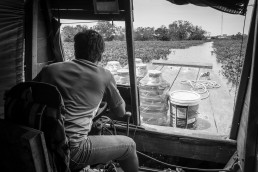
The boat, one of TLC’s fleet of six, navigates a channel through dense beds of water hyacinth. In high-water season, the lake has an average depth of about 10m. During dry season, that falls to less than a metre, and smaller, shallow-draft boats must be deployed.
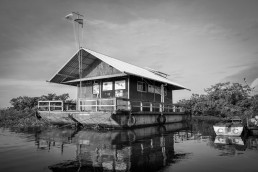
TLC’s Peam Bang clinic sits on a pontoon anchored to the lake floor. Water depth at this location rises to about eight metres in wet season, the ‘bushes’ here actually being the tops of submerged trees.

TLC medical director Dr Hun Thourida unloads the boat. She has worked with TLC since 2012, after graduating from the respected St Petersburg II Mechnikov State Medical Academy in Russia. ‘Doctor Rida’ chose to return to her home country to help the needy. She is fluent in Khmer, English and Russian.
Chhuon Sary, supported by Doctor Rida and clinical coordinator Uk Savann, gets the Peam Bang clinic scrubbed and ready for action. TLC currently operates five floating clinics serving nine of the most isolated lake communities. The most accessible is 30km from port; the furthest is more than 100km away.
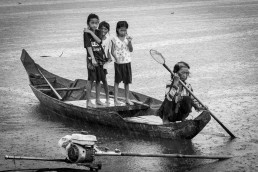
Three girls and their grandmother are caught in a shower while heading for the clinic.

On a busy day, a TLC clinic might welcome 100 patients. Most are women — mothers and grandmothers — with children in tow, and a smattering of older men. Unless seriously ill or injured, men of working age will be too busy fishing and tending nets to see a doctor. ‘These people live by the day,’ says Dr Hun Thourida. ‘What they catch is all they have.’
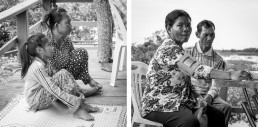
Common ailments on the lake include malnutrition and measles in the young, diarrhoea caused by drinking dirty water (a major cause of childhood death), infected wounds (often from the propellers of outboard motors), tuberculosis, fungal conditions, malaria, dengue fever, complications from diabetes, respiratory infections, severe tooth decay and burns, as well as hypertension and arthritis in older patients.
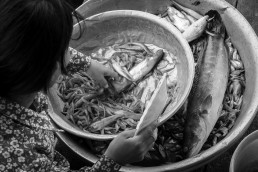
A woman sorts through her catch while waiting to see a doctor. Catches have fallen drastically on the Tonlé Sap over the past decade due to overfishing, pollution and hydropower-dam building upstream — most notably in Laos and China, on the Mekong that feeds the lake via its tributary the Tonlé Sap River.
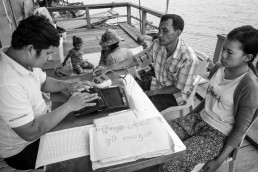
Nurse Suon Piseth checks the blood pressure of all patients on their arrival at the clinic.

TLC measures and weighs lake children under the age of five every six months, charting their growth. Cambodia as a whole has a 32 per cent malnutrition rate, according to TLC data, rising to 59 per cent on the lake. Malnutrition is especially common among youngsters, with fish caught or farmed by their families usually being sold.

Diets therefore revolve around rice, chilli and salt, lacking in protein, fat and micronutrients. ‘Two-thirds of the kids on the lake are stunted due to chronic malnutrition,’ says Jon Morgan. ‘To their families, fish has more value as a commodity to sell than as nutrition.’
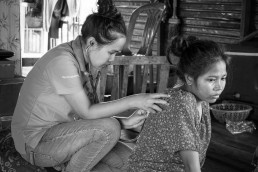
Doctor Rida pays a house call by boat to a woman unable to reach the clinic. The doctor has been treating the 28-year-old for Pott’s disease — tuberculosis of the spine — that could have resulted in paralysis. The woman lives with her small daughter, her mother, who has Parkinson’s disease, her father, who lost a leg to gangrene, her sister, who also has TB, and her sister’s husband — the family’s sole breadwinner. The woman’s husband disappeared when she became unwell.


A mother takes her sick daughter’s temperature with a digital thermometer; Chhuom Sary vaccinates a toddler against diphtheria, tetanus and whooping cough.
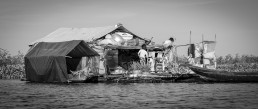
Children play outside a family’s floating home. According to the most recent Cambodia Demographic and Health Survey, one in every 29 Cambodian children dies before his or her fifth birthday, with the mortality rate ‘markedly higher in rural areas’, or one in every 19 under-fives. On the lake, young death comes even more readily. Dr Hun Thourida says lake families often have as many as 10 children, with many not surviving to adulthood. ‘Some drown between the age when they start to crawl and when they learn to swim,’ she says.
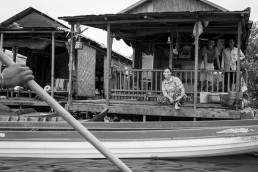
Dr Hun Thourida says many lake dwellers have no opportunity to live on land, with many effectively stateless, their births never having been registered. Such people cannot own property, get a job and pay tax, obtain a driver’s licence or open a bank account. ‘Fishing is all they know. Because of poverty they are stuck,’ she says. ‘They were born on water and they will die on water.’

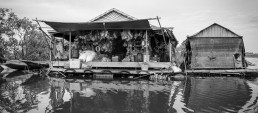
Everything is designed to float at Peam Bang — including homes, mechanics’ workshops, livestock pens and chicken coops. Some lake communities have floating schools and churches, while convenience stores sell instant noodles, potato chips, candy and sugary drinks to those who can afford them. Tooth decay is increasingly a problem due to poor oral hygiene.
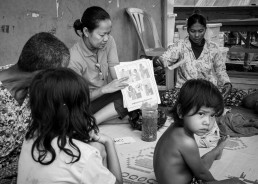
Ky Kolyan explains the dangers of consuming lake water. TLC encourages the use of bio-sand filters. ‘We have to tell them, the water might look clear, but you poop in the water and you pee in the water, so it’s not good to drink,’ says clinical coordinator Uk Savann.

TLC has established a ‘Mother’s Club’ in each community, with counselling on antenatal care, hygiene, birth spacing and contraception. The goal is to decrease maternal and infant mortality rates.
A poster at the Peam Bang clinic instructs on how to build and maintain floating vegetable gardens. Crops include water spinach, cabbage, lemongrass, spring onions, tomatoes and eggplant. Families can sell any surplus.

Patients paddle for home. Though many fishing families have access to boats with outboard motors, for those living farthest from land, travel for a medical emergency could cost up to 200,000 Cambodian Riel (US$50) in diesel fuel, an amount that is prohibitive to many families. The Lake Clinic, therefore, travels to those most in need, also providing transportation to faraway hospitals in urgent cases.
After three days on water, it is time for the TLC team to lock up the clinic and return to land. ◉
Angkor's Secrets Revealed
John McDermott’s otherworldly pictures of Cambodia's mysterious temple complex capture not only what the eye sees, but what the heart feels.
LIKE THE PHOTOGRAPHY of the late Ansel Adams, whose black-and-white landscapes of Yosemite are the defining images of that Californian national park, John McDermott’s work is strongly tied to one place.
The 61-year-old’s pictures of Cambodia’s wonder-of-the-world Angkor Wat are dreamlike and otherworldly, and yet also realistic representations of what one feels when visiting.
With ghostly monks climbing sandstone steps towards the heavens, 20-metre-high gates looming from primeval jungle, mysterious structures (lairs of the gods, perhaps) floating on seas of clouds, and tentacle-like tree roots consuming temples lost in time, McDermott’s images are arguably the most iconic ever made of the temples, with the New York Times dubbing him “the unofficial court photographer of Angkor”.
HAILING FROM LITTLE Rock, Arkansas, McDermott lives in Siem Reap, the bustling entry-point city for tourists visiting the sprawling Angkor complex. He discovered his 12th-century muse back in 1995, when working for a Bangkok-based magazine. That year, McDermott visited Angkor Wat for the first time to experience a total solar eclipse. “A magical place for a magical event,” he says.
The photographer had been experimenting with specialist film sensitive to infrared light, which is invisible to the human eye. Images captured with infrared film have an ethereal quality: leaves on trees appear luminous, skies darken moodily, the orange robes of monks fluoresce tungsten white, and light sometimes bleeds to give objects supernatural-looking auras.
“It’s hard to work with, not very stable, and a lot of photographers gave it a try but didn’t really get into it,” McDermott says. “I wanted to see what would happen to the film before, during and after the eclipse.”
Having taken up position on the right side of the causeway leading towards Angkor Wat, McDermott waited for the moon to pass across the sun. “As [an eclipse] gets closer and closer, colour diminishes and everything becomes monochromatic,” he says, “and just a few seconds before totality hits, the light flutters.”
Already impressed by what he had witnessed, once back in his darkroom McDermott had his “eureka moment”.
‘WHEN I LOOKED at all the pictures, the infrared were the ones that had a sort of spirit or soul to them,” he says of the specialist film, manufacture of which has long since been discontinued (McDermott has about 200 rolls left, stored in his freezer). “They had a surreality that spoke to me, that captured the place as it looked to me at the time — the feeling, the experience.
“I always envision places like Angkor, like Pagan [in Myanmar] and some other historical places in Asia as remnants of an ancient civilisation, or even of an alien civilisation — like Star Trek backgrounds — and I really wanted to capitalise on that idea and make the pictures as surreal as possible. Angkor and the infrared film proved a good match.”
Five years later, McDermott returned to Siem Reap for an exhibition of his work at the newly re-opened Raffles Grand Hotel d’Angkor.
“I needed to photograph the temples soon, before the invasion happened and things would never look the same again”
Photographer John McDermott
“It was a little exhibition, just for fun, but it ended up selling out,” he recalls. “I’d been looking for a project to get my teeth into, and I realised then that interest in Angkor was building, and that there was going to be a tourism boom. I needed to photograph the temples soon, before the invasion happened and things would never look the same again.”
McDermott spent much of 2000 and 2001 flitting back and forth from the US to shoot Angkor Wat, the Bayon, Ta Prohm and other temples, gradually developing his characteristic style, and financing his project with further exhibitions. “By 2004, tourism had really grown,” he says. “By then I had a big collection of pictures and was having regular exhibitions around town.”
The upmarket FCC Angkor restaurant and bar on the banks of the Siem Reap River, he continues, had opened some shops on the ground level. “I got offered one, so I called [my wife] Narisara, who was then about to leave grad school in the US, and said, ‘Do you wanna go into the gallery business?’”
TODAY THE COUPLE and their two young children, Mars and Rose, are comfortably settled in Siem Reap. They have two galleries — that original space at the FCC and another in the Raffles.
McDermott admits that he shoots Angkor less often these days due to the sheer number of visitors to the temples and the ongoing restoration work. Even so, the second edition of his exquisite Angkor-photography book Elegy — funded by a Kickstarter campaign that generated more than US$100,000 — includes pictures taken as recently as 2014.
“The aesthetic has certainly changed,” McDermott says of Angkor. “Is it a fantastic place to visit as a tourist? Yes, sure, but some of the charm, some of the mystery, has gone.”
As well as the galleries, McDermott runs photography excursions for individuals and group workshops open to the public. “In the workshops me might focus on how to build a story or a portfolio,” he says. “The one-on-one excursions are more informal. I take them to places where I know they are going to get good photographs, so they don’t have to do days of research to find them. We don’t get too technical, and they get to see Angkor in a different way.”
Ultimately, it could be argued that McDermott’s own quest to see things in “a different way” has been central to his success, and his Angkor portfolio is a “window in time” that lets in mood and emotion as well as light.
“I wanted to capture more than what I could see — I wanted the gut feeling, the atmosphere and sense of wonder,” he says. “That was my intention from the beginning: to capture the spirit of Angkor as I felt it. I saw it back when it was just ruins and jungle, and it had that mysterious, otherworldly appearance. I wanted that.” ◉
Continued: John McDermott explains his most striking pictures of Angkor
This story ran in Post Magazine in 2017 (see PDF). John McDermott's fine-art and commercial photography can be viewed here.
SHARE
Fighting for His Life
Bangkok-based American lawyer Craig Wilson is also an amateur boxer who routinely fights opponents half his age. Dubbed Farang Ba — or 'Crazy White Foreigner' — by his Thai fans, his greatest challenge was fought outside the ring.
THE SUN HAS SET over the Buddhist temple fair in Prathai, a rural village in the northeast of Thailand. Cinnamon-cloaked monks have chanted their blessings. Water buffalo rest beside rice paddies and children hunch over their textbooks, barely illuminated under the naked but low-watt bulbs of street stalls selling dried-squid snacks and sugarcane juice.
Now comes the highlight of the day’s festivities: an open-air boxing match to be fought by Queensbury rules. In the blue corner, proud and sculpted Thai fighter Pumin Sorjaturong. In the red, conspicuous and ill-at-ease American Craig Wilson.
Tension is palpable; betting feverish. The bell rings for round one and cheers overwhelm the electric hum of the tropical night’s cicadas.
A flurry of jabs, a lightning hook and Sorjaturong stumbles to whoops and jeers. The 26-year-old knows the American is capable of the unexpected. He met Wilson in the ring at the Thai king’s birthday celebrations in December. On that auspicious day in Bangkok, 5,000 revellers witnessed Sorjaturong’s humiliating knockout at the end of a short right to the jaw in the third round.
As the fighters square up once more, spotlights catch Thai script printed in gold across the American’s trunks. It proclaims him to be “Farang Ba”, the “Crazy White Foreigner”. Those trunks hide the 48-year-old’s colostomy bag.
WILSON IS A MAN of startling contradictions. As the only foreigner on Thailand’s amateur boxing circuit, he relishes going toe-to-toe with peak-fitness fighters half his age, and yet he offers cash incentives to Bangkok motorbike-taxi drivers to be especially careful when transporting him to his plush office in a high-rise tower.
As general counsel with Bangkok-based merchant bank Finansa, he arrives to work in regulation pinstripes, spectacles and Gordon Gekko suspenders, and yet the balding, near-sighted lawyer can greet a Monday morning with a black eye, a fat lip or facial stitches.
“I’m an in-house lawyer,” laughs Wilson, who smiles readily but takes his obsession seriously. “I rarely meet clients myself so the bruises and cuts are not a problem. Some of the staff roll their eyes and probably think I’m insane. But they know how important boxing is to me. They respect what I do.”
And Wilson surely deserves respect, for his is an inspirational tale of a man who has rolled with life’s cruellest punches. Though he had his entire colon surgically removed in 1996 after a bout with cancer, Wilson has refused to go down.
“I began to react to these unsettling intrusions on my well-ordered existence. Within a few weeks, I knew that I had escaped from my rut”
Lawyer and boxer Craig Wilson
THE SUBJECT OF a feature-length documentary by New York-based filmmaker and fellow boxer John Sullivan, Wilson was raised in suburban Washington DC in a comfortable middle-class family. He was, he says, an academic whizz-kid but also “a wimp”.
“I was an okay sprinter,” he shrugs, “but contact sports? Forget it. I wasn’t really into exercising or getting hurt. My head was deep into books.”
Majoring in history at Yale, Wilson progressed to law school at Harvard, graduating in 1981 and taking the first steps on a lucrative — and what should have been run-of-the-mill — legal career. He became a law clerk for a federal judge on the US court of appeals in Houston, Texas, before moving into corporate law with international legal giant White & Case in DC. What Wilson gleefully describes as his “slow but steady slide into pugilism” began in 1987.
Frustrated that the far-flung corners of globe and their potential for adventures were eluding him, Wilson snapped up a posting with the Asian Development Bank in the Philippines’ capital of Manila. His unavoidable exposure to that nation’s poverty, and its good-natured people’s resilience, quickly opened Wilson’s eyes.
“I began to react to these unsettling intrusions on my well-ordered existence,” he says. “Within a few weeks, I knew that I had escaped from my rut.”
An out-of-shape 85kg “with very little muscle” at the time, Wilson resolved to maintain a healthy distance from other well-heeled expatriates in Manila, their sheltered existence revolving around guarded living compounds, chauffeured commutes to work and poolside buffets on weekends at private recreational clubs. The death of his father, just months after his overseas posting, added to his conviction.
“My dad died of a heart attack, and being overweight was certainly part of the problem. I did some soul searching. I was 31. My life was sedentary, too comfortable. I looked in the mirror and said to myself, ‘It could happen to you, too, so easily.’”
TWO MONTHS LATER, Wilson discovered an unlikely saviour in the down-and-dirty Elorde Sports Centre in a ramshackle Manila suburb. The rundown gym had been a labour of love for the late Gabriel “Flash” Elorde, who collected bantamweight, featherweight and lightweight world titles during an illustrious career spanning the 1950s and ’60s. There, he met Flash’s son, Gabriel “Bebot” Elorde Junior.
“That guy could sell rice to a farmer,” laughs Wilson. “I told him, ‘Hey, I’m a lawyer, I wear glasses.’ But I looked around and saw all these guys with incredible physiques and I said, ‘That’s what I want to look like.'”
Wilson immediately started training. Weights, ropes and sit-ups came first. Soon he was punching bag and the excess pounds fell away. The workouts continued for several months until it was time to try his hand at sparring. “I still remember the first time,” Wilson says, recalling how he sheepishly pulled on the tattered, 16-ounce sparring gloves. “I’d never been in a fight in my life, but I didn’t want the guys to think I was chicken.”
The lawyer’s lack of technique showed and his opponents toyed with him. As he progressed, however, one or two friendly punches made their way to his gut. More weeks passed and Wilson found himself being taken — and hit — more seriously until, after one especially fierce sparring round, his trainer wiped his face with a white towel, which was then stained with crimson.
“‘You have a bloody nose,’ he said. ‘Do you want to stop?’ I was genuinely angry. ‘No way,’ I replied, ‘I want to give him a bloody nose.'”
Wilson had become a fighter.
IN APRIL 1988, at an age when most would be hanging up their gloves, 75kg Wilson began to fight as an amateur in the middleweight class, winning his first bout in the Manila slum known as Tondo. He was hooked. “I think it may have been the happiest moment of my life,” he says. “I felt I’d proved something to myself, something that all the academic achievements had never given me.”
During his four years in the Philippines, the lawyer fought 22 bouts, including two in the Philippine National Games — “the officials conveniently looking the other way when the subject of my nationality arose” — and once at Araneta Coliseum, venue of 1975’s “Thrilla in Manila” between Joe Frazier and Muhammad Ali.
A local sportswriter informed Wilson that he had been the first American to fight at Araneta since that legendary bout, making it a highlight in the lawyer’s boxing career. When he returned to the US in the early 1990s, however, the most exhausting and brutal fight of his life was just seconds out.
Trailer for John Sullivan's documentary 'Farang Ba'. Video: Naked Emperor Film/YouTube
IN 1993, WILSON was diagnosed with ulcerative colitis, an incurable bowel condition characterised by inflammation and ulcers in the lining of the colon. Though not fighting at the time, he kept his condition in check and continued to train before being assigned to Bangkok in his new role with a New York City law the following year.
“I was living out of a hotel room, not eating regularly, too much spicy food,” says Wilson. “Things started to get out of control.”
The problem peaked in November 1995 when Wilson was forced to visit the washroom 24 times in a day. On his hurried return to Washington it was discovered he was suffering from cancer. It would be necessary for his entire colon to be removed. Wilson underwent surgery on January 31, 1996, followed by chemotherapy and radiation treatments.
An ileostomy (a surgical procedure bringing the ileum — the last portion of the small intestine — to the abdominal surface) means he will carry a colostomy pouch for the rest of his life.
“As long as there are no below-belt punches, I’m fine. I wear a foul protector beneath my trunks and that fits over and holds the colostomy pouch in place”
Wilson
After the trauma of the surgery, Wilson set himself the goal of running a marathon. The following year he finished the New York City race in under five hours. But he missed the camaraderie of boxing and soon began training. “As long as there are no below-belt punches, I’m fine,” he says. “I wear a foul protector beneath my trunks and that fits over and holds the colostomy pouch in place.”
With Asia in his veins, Wilson returned to Bangkok as general counsel for Coca-Cola in the region in 1998, only to see his job downsized months later. “I was at my lowest ebb,” he says. To keep his protégé from sinking into despair, Wilson’s burly Thai trainer Decha Boonkamnerd — a former boxer in the Thai national team — organised his first post-cancer bout. Wilson won.
“This may sound corny,” says Wilson, “but the excitement and elation kept me going while things were so tough in my professional life.”
Since then, Farang Ba has fought more than 35 times in Thailand. Last year he sparred with Olympic light-middleweight bronze medallist Pornchai Thongburan. Wilson took the eight count three times. “I was way out of my league,” he laughs.
“That’s the thing about Craig,” says Sullivan, whose documentary takes its title from the words adorning Wilson’s boxing trunks. Farang Ba: Crazy White Foreigner has been shown at 15 film festivals around the world. “He’s such a lovely, humble man. Boxers and boxing are frequently portrayed in such an unflattering light, and yet here you have this kind and dedicated guy … He is the perfect ambassador.”
WILSON GUZZLES DIET-Pepsi (“Never Coke,” he says, holding a grudge) by the caseload when training. The only dietary side effect of the ileostomy is that he can no longer eat popcorn. The kernels cannot be digested and will block the tiny opening in his intestinal wall that links his digestive system to the colostomy pouch.
“I’m not a health-food fanatic but since the surgery I’ve made an effort to eat well. That means lots of fruit and fish, and relatively little meat.”
For days before a fight, Wilson avoids fried foods and concentrates on protein. The day before a bout, he overloads on carbs.
Bangkok’s heat and humidity are extreme so Wilson runs no more than five kilometres every other day in the Thai capital’s landmark Lumphini Park. His 90-minute daily boxing workout routinely involves stretching, slow and fast rope jumping, three rounds of shadow boxing, three to five rounds on punch mitts, two or three at the heavy bag, and six sets of 50 sit-ups. Additional focus practice picks a standard punch or movement — perhaps the uppercut or the hook — and dwells on that for a couple of rounds.
When a fight is approaching, two additional exercises are added to the programme: defence practice, in which Boonkamnerd throws punches that Wilson has to avoid or block, and “punishment”, whereby his trainer wears a glove and slugs the boxer three sets of 20 times in the stomach to strengthen abdominal muscles.
Once or twice before a fight, Wilson endures “sprints”: a workout Boonkamnerd picked up from the Thailand national team’s Cuban coaches.
“I stretch and jump rope before going 30 rounds, each round of 30 seconds, with only 10 seconds between each round, of full, fast, all-out, nonstop workout: five rounds of shadow, 10 rounds on the punch mitts, 10 rounds on the heavy bag, and five rounds of fast jumping rope,” Wilson says.
“By the time that workout is over, I feel like a limp and soaking-wet rag-doll.”
ON THE MORNING of the fight in Prathai, Wilson woke early to jump rope. In the afternoon, he slow jogged for five minutes to get the blood pumping and then indulged in some relaxed shadow boxing.
But while his knowing opponent Sorjaturong saved his energy by hiding in the shade during the hot afternoon, Wilson embraced the boisterous temple-fair festivities with an ear-to-ear smile. To the joy of the villagers, he shamelessly danced with them through the dusty streets, among the scrabbling chickens and scrawny goats. He warmly shook every outstretched hand under the blazing tropical sunshine for more than two hours.
And that may have been his downfall.
Driving back to Bangkok after the fight, trainer Boonkamnerd is behind the wheel of Wilson’s silver BMW and Sorjaturong is asleep in the back. A soothing Mozart sonata plays on the CD player while Wilson fusses with an icepack, holding it to the gaping gash above his left eye that stopped the fight in the third. He will need eight stitches.
The American is quiet and contemplative. Perhaps work is a worry: it’s already 3am and gregarious Farang Ba needs to transform into a mild-mannered lawyer Craig by 8am, when he must be at his desk.
Maybe he is fondly recalling the sonic Mexican wave of surprised “ooohs” and “ahhhhs” that greeted the climax to the night’s bout, when Wilson pulled off his headgear to reveal his sweating pate — and that Farang Ba is only young at heart.
Or is he thinking about the responsibilities that come with the Sports and Martial Arts Center (SMAC), a Bangkok initiative co-owned by Wilson that gives disadvantaged Thai youngsters the opportunity to boost their self-esteem through boxing? It’s impossible to believe he might be down about the fight’s result.
“I was a great day,” bloodied but unbowed Wilson says with a sigh, as the twinkling lights of the city hove into view. “Sure, I’m disappointed. But the way I look at it, every time I climb in the ring, win or lose, it’s another nail in cancer’s coffin.” ◉
This story was commissioned in 2004 by a new US mag called Drill (an FHM/Maxim-like title aimed at the military and described as being "for men who just happen to jump out of planes or hide in foxholes for a living").
Drill was soon cancelled and the editor took my story with him to Men's Fitness. But then he left that mag, too. The disappointing outcome was that while I was paid two kill fees for the text (good), it never ran anywhere (bad).
SHARE
Sailing to Freedom, Part II
The 3,500-tonne freighter Skyluck arrived in Hong Kong in February 1979 with a cargo of 2,600 Vietnamese 'boat people', who were then forbidden from coming ashore. The second instalment in a two-part story recalls the months the refugees endured as prisoners on the ship, and how they finally escaped to start new lives.
THE STORY SO FAR … With the fall of Saigon on April 30, 1975, the Vietnam War came to an end and the Southeast Asian country was unified under the Communist Party of Vietnam. Subsequent economic hardship and the threat of forced labour in re-education camps resulted in increasing numbers of people fleeing the country, risking shipwreck, drowning, starvation and pirate attacks by taking to the South China Sea in overcrowded fishing boats.
By 1978, the initial trickle of “boat people” had become a flood, largely due to the Vietnam regime’s persecution of its ethnic-Chinese population — and desire to profit from their wealth by charging the equivalent of US$10,000 today in gold for passage out of the country.
Colluding with international syndicates, Vietnamese authorities were now complicit in people smuggling on a massive scale, with colossal freighters sometimes employed to make the exodus as economically efficient as possible.
One such ship was a rusting, 3,500-tonne vessel called the Skyluck, which set sail from the Mekong Delta in January 1979 crammed with thousands of refugees. After an attempt to offload its human cargo in the Philippines had been thwarted, the angry passengers demanded that the captain take them to Hong Kong. The Skyluck slipped quietly into Victoria Harbour in the early hours of February 7, 1979.
Part I of the Skyluck story can be found here.
BY THE TIME the Skyluck had arrived in Hong Kong, its cargo of more than 2,600 refugees had been at sea for two weeks, surviving on little more than watery rice soup and hope. Getting food and medical care to them was a priority, and doctors were despatched to what the South China Morning Post newspaper described as the “battered and shabby” ship now moored in the West Lamma Channel between Hong Kong’s outlying islands of Lamma and Cheung Chau.
Soon, the refugees on board had decorated the 105-metre-long Skyluck with signs, banners and painted messages proclaiming, “Life is precious, but freedom is more valuable”; “SOS. Please help us refugees from Vietnam. Thanks a lot”; “We are extremely hungry, but we need freedom more”; and “Food and Medicine save refugee lives”.
A pontoon was lashed to the ship to facilitate food delivery. Supplies were chiefly canned and included sardines, pork luncheon meat, baked beans and condensed milk, as well as oranges, dry crackers and sliced bread. By the end of the day after the Skyluck’s arrival, some 2.4 tonnes of provisions had been reported as delivered (by February 12, total supplies would top 13 tonnes and be estimated to be costing Hong Kong HK$5 — then about US$1 — per refugee per day).
After that initial burst of activity, provisions were delivered to the pontoon every two days, to be distributed by the refugees themselves. Skyluck passenger Mai Tran, now aged 55, speaking from his home in Fort Collins, in the US state of Colorado, remembers a typical share: “Four people share a can of beans, four people share a can of ham, four share a can of condensed milk, two people share an orange, two or three pieces of bread per person, some crackers …”
The Skyluck passengers expected to be held on the ship for some days: it was standard procedure for boat people arriving in Hong Kong to be kept at anchorage for a week, effectively quarantined at sea. Due to the ship having entered the harbour illegally and covertly, thereby embarrassing those charged with keeping track of such arrivals (the approach of the refugee-crammed Huey Fong had been closely monitored), the refugees were informed, on February 9, that they would not be allowed to land any time soon.
While day-to-day essentials would continue to be delivered, and their medical needs met, the Skyluck would be guarded around the clock by at least one police launch. And so began a standoff that would last for the best part of five months — until, in late June, the frustrated refugees, their tempers fraying and patience stretched, would take matters into their own hands in the most swashbuckling fashion.
‘IT WAS A TERRIBLE life,” Quan Tran, a 71-year-old survivor of the Skyluck’s journey who eventually resettled in Maryland, says of their months held in maritime purgatory, adding that for months he, his wife and their four-year-old daughter and two-year-old son would be squeezed into an area “like a king bed; it was so small”.
An instructor at Saigon’s mechanical engineering school before being drafted into in the South Vietnamese army for two years of the Vietnam war, serving as a lieutenant, Quan Tran had been sent to a re-education camp after the fall of Saigon, but laboured there for less than five months because his teaching skills were needed. Married with a four-year-old daughter and one-year-old son, he chose to escape Vietnam to provide a better future for his family.
“We were like a big sardine can, with each one of us a sardine,” he says of life on board the Skyluck.
One highlight in each day was what Mai Tran — who was 16 while on the Skyluck, and travelling with his 14-year-old sister (his parents and four other siblings were to escape from Vietnam later) — describes as “a kind of flea market” that sprang up on the deck of the ship, testament to the Vietnamese and Chinese instincts for commercial enterprise, both of which had been repressed under the totalitarian regime at home.
“A system of pricing was established — for one can of milk, pay maybe half a loaf of bread — because currency doesn’t mean anything on the ship”
Skyluck survivor Andy Tran, on how a barter economy functioned on the ship
“After we landed in Hong Kong, the food supply was pretty good. Bread, canned beans, milk, but some families would not need milk while kids would need more milk, so we started exchanging food,” recalls Andy Tran, now aged 60 (and 20 when he fled his homeland in 1979). Andy Tran resettled in San Jose, in California’s Silicon Valley, with siblings and cousins also making new lives in the San Francisco Bay Area.
“‘Hey, I’ll give you my bread. How about you give me your milk.’ A system of pricing was established — for one can of milk, pay maybe half a loaf of bread — because currency doesn’t mean anything on the ship.”
“It was quite good compared to what we had been used to,” Quan Tran says of the food provided, “but eat one thing over again and you get sick of it. For many years after, I could not eat beans or luncheon meat or sardines. I was sick of them.”
“After a while we asked for freshly prepared food, and then they would bring it three times a week,” adds Quan Tran, who, having been in the South Vietnam military, soon found himself among the de facto refugee leadership on the Skyluck. “But the food was not enough for the young people. Older people, we were okay, but the young people, especially if alone, they did not know how to save food.
“When they got it, they would eat it in one day, and the next day they would be hungry.”
Asked today what she remembers most about the months marooned off Hong Kong’s Lamma island, Andy Tran’s sister JoAnn Pham, who was 13 while on the ship, and now aged 53, laughs and says, “Hungry, hungry, hungry, hungry, hungry.”
From February 19, cooked rice and some hot food were provided. Later, in April, it would be increased to two hot meals a day.
Clockwise from top left: Skyluck survivors Quan Tran and his son, Thuan 'Tom' Tran, in Washington DC; Mai Tran, who is now based in Colorado; and California-based siblings Andy Tran, Bryan Chan and JoAnn Pham (seated, from left), and their cousin Bill Quach (standing). Photos: Gary Jones and courtesy Mai Tran
WHILE THE SKYLUCK was guarded to ensure refugees did not abscond, police presence also kept journalists and the simply curious away from the ship. This lack of communication with the outside world led to a belief among refugees that they were being deliberately pushed from the headlines.
Indeed, updates from the Skyluck all but disappeared from the Post after February 20, with stories focusing instead on the daily arrival of other refugee boats, and into the slow-moving investigation into the ship’s journey to Hong Kong, with its Taiwanese captain and pan-Asian crew facing charges for involvement in a people-smuggling racket.
All that changed on March 11, more than a month after the Skyluck’s arrival, when, starting from early morning, new signs began to appear on the ship. Messages read: “We plead for freedom not isolation”; “Don’t let us be forgotten. Let us land!”; “Run for life. Run for freedom”; “Have pity on us. Let us land please!”; and, “Help us land as soon as possible”.
Then, at about 10am, 100 or so young male refugees began leaping overboard to swim the 1,500 or so metres to shore, some using tin containers — in which foodstuffs had been delivered — as improvised flotation devices. Half of the swimmers were quickly picked up by police launches, but about 50 reached Lamma’s Hung Shing Yeh beach, most to be quickly rounded up and taken to the nearby police post, where two were treated for exhaustion. Through the post’s chain-link fence, others handed pre-prepared written pleas to land to journalists.
One 15-year-old swimmer was at liberty for 12 hours, smuggled off Lamma on a public ferry by a group of European picnickers, taken to a Mong Kok hotel where he was briefly reunited with his 17-year-old sister, possibly from an earlier refugee boat, and was even interviewed on local TV before turning himself in.
Mai Tran was one of the volunteer swimmers, but quickly realised he was out of his depth, in more ways than one. “I swam a bit, but it was so cold that I turned back,” he says. “It was lucky I did. I don’t think I could have handled it.”
“We just wanted the public to know we were there and not be forgotten. We know we cannot escape. How can we escape?” says Quan Tran.
“We’d been there, isolated, for more than a month. We wanted our families to know where we were, and that we were safe. We cannot do this while stuck on the ship, so we decided to try and get inland, to tell people, to tell the press, that we were there. If people in Vietnam listened to [radio stations like] the BBC or VOA, they would know that we had got to Hong Kong. That’s all we wanted.”
When the Hong Kong representative of the United Nations High Commissioner for Refugees (UNHCR), Angelo Rasanayagam, sent a letter to the Post, decrying the lack of press coverage of the Skyluck refugees’ plight, veteran Vietnam war photographer and Hong Kong-based journalist Derek Maitland used the newspaper’s pages to slam what he called a “total information blackout on refugees” by the government that had “denied the public any personal contact with these people and effectively reduced them to dehumanised newspaper statistics”.
AFTER THE SWIMMING action, the Skyluck was hauled further from Lamma’s shore (“We thought they were going to pull us in, but they pulled us out,” recalls Andy Tran) and a police launch was moored to the pontoon alongside the ship. An air of despondency settled over the refugees, who struggled to fill their days.
Music lover Andy Tran had books of music theory in the minimal possessions he had brought from home, which he studied. “I like to read but there wasn’t much reading material,” he says. “There was a reverend [on the ship] and so I also read the Bible three or four times, to kill the days. Some of us would gather on the deck, just sit around and talk, watch the sunrise or sunset.”
His sister JoAnn Pham “read the labels on [food] cans, over and over and over again”. Their cousin Bill Quach, who was just nine years old then, and 49 today, says the months “felt like years”.
Teenager Mai Tran struggled with a feeling of helplessness. “Just the waiting, not knowing what was going to happen, seeing no light at the end of the tunnel,” he says. “We had no contact with our family at all for about six months. Hunger we could manage, and we would exercise by jumping in the ocean and swimming against the current. We had friends so we could socialise, but not knowing about our family, not knowing our future, those were the hardest things.”
“There were 2,600 people there, and we had 2,600 heads with lice”
Refugee Quan Tran
When the Skyluck had arrived in Hong Kong in February, doctors found that just three people were suffering from only minor ailments: two men and a four-year-old boy, who were taken to hospital to be treated, and then returned to the ship. In the months that followed, there were cases of pneumonia, internal bleeding, skin conditions, tuberculosis, sciatica, diarrhoea, haemorrhoids, measles and mumps, and even a suspected instance of leprosy.
With two very young children to watch over, Quan Tran was tormented by the thought that disease could spread quickly on the ship. “We were lucky that it didn’t happen but I was very scared about that,” he says, adding that there were a number of doctors among the refugees. They would cater to everyday complaints, with medications provided by Hong Kong authorities.
“People who got badly sick, or who were pregnant or needed some special care, would be transferred to hospital,” says Quan Tran. “They were lucky because they got lots of food, lots of meat. Some people wanted to get sick.”
While the ship’s deck was usually awash with young men, the elderly, women and children tended to stay inside the holds, where — with so many unwashed bodies in close quarters — the air was stale and nauseating, permeated with the stench of diesel, grease, rust, sweat and worse.
Maintaining hygiene was a struggle, Quan Tran remembers, especially as months dragged on and the mercury soared. “We had only two litres of water for each person a day, so could not have a proper wash. We had to save it to have a proper shower,” he says. “There were 2,600 people there, and we had 2,600 heads with lice. I think there were three people who did not have lice, because my friend shaved his head and shaved his daughters’ heads.”
ON APRIL 18, 1979, 52-year-old Talbot Bashall was appointed controller of the Hong Kong government’s new Refugee Control Centre, headquartered at Victoria Barracks, then in Admiralty (and roughly where Hong Kong Park and the Pacific Place shopping mall sit today). The Skyluck had by now been isolated off Lamma for the best part of 10 weeks.
Born in the English county of Surrey, Bashall had served with the British Army in Italy and Palestine in years that followed the Second World War. He arrived in Hong Kong in 1953, carving out a career in correctional services. Starting out as an officer in Stanley Prison, he later ran a prison-staff training school and an institution for young offenders. None of this, however, had prepared him for the life-changing challenge that lie ahead.
“People tend to think of the boat people as coming in smaller vessels, and that had been the case in previous years. Everything changed from late 1978; this was industrial scale,” says Bashall, speaking by telephone from his home in suburban Perth, in Western Australia, where the 92-year-old lives in retirement.
With boats streaming across the South China Sea, sometimes arriving in the dozens every day, Bashall and his team struggled to feed, process and provide shelter for tens of thousands of men, women and children, all the while liaising and negotiating with the UNHCR and foreign consulates in the hope of finding countries willing to take them in.
Bashall’s diary entry for May 11, 1979, reads: “The storm hit me as the magnitude of the influx became evident. Boats queuing up to get in choking up the approaches. Really a horrific situation”. And on May 21 he wrote: “HK is really being clobbered these days, and daily they are coming in.”
On May 26, a decaying freighter — smaller than the Skyluck, at 800 tonnes — carrying more than 1,400 refugees had entered Hong Kong. The captain and crew of the Sen On (really the Seng Cheong, with the painted name on its hull changed) had jumped ship somewhere near Macau for a fishing junk, advising former members of the South Vietnamese military among their human cargo to steer for the bright lights of Hong Kong. The refugees were advised not to engage with Hong Kong authorities and immediately to beach the vessel, which they did, on Lantau island, then to be transferred to refugee camps.
Despite denials from Vietnam, it was now widely accepted that the communist government there, supported by smuggling gangs, was encouraging the exodus of Chinese-Vietnamese citizens, exploiting their financial resources and trading in human misery.
On June 7, Hong Kong’s information secretary David Ford estimated that Vietnam would earn US$3 billion through the on-going expulsion of refugees. “We know that the Vietnamese government regards this trade in human lives as a major source of foreign exchange,” Ford said. “Indeed, it is now said to have overtaken their largest export earner, their coal industry.”
Five days later, in a lengthy dispatch from Hong Kong headlined “Hanoi Regime Reported Resolved To Oust Nearly All Ethnic Chinese”, The New York Times stated: “Vietnam appears determined to expel virtually all the members of its ethnic Chinese minority and is exacting hundreds of millions of dollars from them before their departure.”
The report continued: “To encourage the Chinese to depart, they have been subjected to harassment, including loss of jobs, closure of schools, curfews, intimidation by the police and the creation of detention camps.”
ON JUNE 13, refugee leaders on the Skyluck refused to collect food delivered to the pontoon tied beside the ship. “The police kept promising, saying we could land soon,” says Quan Tran. “We lost patience, so we tried a hunger strike.”
Bashall was dismayed by what he regarded as a lack of gratitude, writing on June 13: “Skyluck refugees on hunger strike […] What a liberty. All uninvited and making demands!”
The following day, Bashall continued: “Two letters, petitions, appeared on my desk [from the Skyluck]. One pleading and the other uglier. Refusing food and saying they will starve to death. With the hardening mood of the [Hong Kong] people and Government I suspect they will get short shrift.”
Indeed, the Hong Kong public was turning against those washing up on its shores from Vietnam, mainly due to their sheer numbers but also because the territory was paying for their upkeep. “The best way to describe the situation in Hong Kong was that we suffered from compassion fatigue,” Bashall says. “It was a deluge.”
On top of that, many felt that there was an unjust double standard at play: those fleeing Vietnam were permitted to stay, while mainland Chinese furtively entering Hong Kong from neighbouring Guangdong province were being hastily repatriated. In the first three months of 1979 alone, more than 8,000 illegal immigrants from mainland China were apprehended in Hong Kong. Though many of those people would have had family in the colony, they were sent back across the border.
On June 18, after five days, the Skyluck began accepting food once more. The hunger strike had failed — Hong Kong authorities had not budged, even though the refugees had stressed that their patience was now stretched to breaking point.
Believing they had been abandoned by Hong Kong and the international community, and with a lesson having been learned from the deliberate beaching of a freighter on Lantau in May, drastic action, it seemed, was needed if the increasingly restive refugees were ever going to get ashore. On the night of June 28, they took it.
“AFTER THE HUNGER strike, we thought there was nothing more we could do, so that’s when they decided to cut the anchor chains,” says Quan Tran. The refugee leaders, he adds, approached the beaching of the Skyluck like a military campaign.
Young male volunteers were organised into teams, each with strict orders. There was a team for cutting the chains and a security detail to protect the cutters from other refugees (in case there was physical opposition to the action). A group was charged with repelling police once the Skyluck was free of its moorings, and a team would oversee evacuation of the ship in case of any accident.
According to Quan Tran, a heavy-duty hacksaw and 10 blades were obtained from one of the ship’s crew, and there were about 10 refugees in the cutting team, working in shifts and pairs (one man wielding the hacksaw, one pouring water to cool the blade). “I think we started cutting at about 7pm, and [it took] until about four or five in the morning to cut both chains.”
Before they were severed, the anchor chains were secured with ropes, so the ship would remain fastened, if temporarily, to the seabed. Cut the ropes and the Skyluck would be free in an instant. The job had taken longer than expected, however, and by the time the cutting team was done, the tide was going out rather than in. The refugees would bide their time.
By about 9am on June 29, however, baleful clouds were gathering. “I could see the sky getting dark and that a storm was coming,” says Quan Tran. “One of my friends, who had been a navy officer, looked at the sky and said that in 10 minutes the storm would arrive. I went back to the group and told them we should cut the rope in 10 minutes. And that’s what we did.”
“Not everyone knew about cutting the anchors,” says Andy Tran. “They didn’t want to announce it properly because of leaks. We were not involved but we heard about it. They were worried that if the police found out, they’d never be able to pull it off.”
“The tugboats tried to get in and push us out, and so Molotov cocktails were thrown around them, to protect the ship”
Quan Tran
Quan Tran says that when frantic police realised what was happening, they “put the sirens on and tried to stop us”.
Though it was expected that the Skyluck would be pushed into Lamma, initially the ship drifted outward and towards Cheung Chau island as police reinforcements rushed to the scene. “There were many more police boats and they got two tugboats out,” says Quan Tran. “The tugboats tried to get in and push us out, and so Molotov cocktails were thrown around them, to protect the ship.”
“I was up top. I was 16, not afraid of anything. It was exciting, things were happening, ‘I’m going in,’” recalls Mai Tran, who has no recollection of a storm or even whether it was raining, “I remember it as a nice day,” he adds, amused by the thought. “It was a good day for me. I was taking the next step: to get off that ship.”
“They were very well prepared with gasoline bombs: they used baby-food bottles filled with fuel from the ship’s tank,” Andy Tran says of those protecting the Skyluck. “They started throwing them at the police boats, so the police kept their distance.”
Eventually, compelled by strong currents, the Skyluck looped eastward and back towards Lamma, its portside flank colliding with the rocky headland at Shek Kok Tsui, north of Yung Shue Wan village. “The plan was to damage the ship once it had hit the shore, so that tugboats could not pull us back out to sea again,” says Quan Tran. “But when the ship hit, I went down to the machine room and I heard the mechanics say that water was coming in, so we didn’t have to.”
Cargo nets and ropes were thrown down the side of the ship, with many of the younger men, caught up in the excitement of the moment, made for land, some running for the hills. But quickly they realised there was nowhere to go, and were rounded up by police and reinforcements from the British army, who had arrived on the island in numbers via landing craft and helicopters.
During the course of the day, the refugees were shuttled on boats from Yung Shue Wan on Lamma to a temporary detention centre — formerly an open prison — on Lantau island’s Chi Ma Wan peninsula.
That evening, Hong Kong’s secretary for security Lewis Davies gave a press conference. “Some persons on board either sawed through or slipped the anchor cables,” he said. “This was an irresponsible action since it placed those on board in considerable peril in the weather conditions then prevailing. The ship also posed a potential threat to other shipping.”
Under the Shipping and Port Control Ordinance at the time, anyone who scuttled or beached a ship in Hong Kong could be jailed for up to four years and fined HK$200,000 (about US$40,000). In their barracks-like accommodation at Chi Ma Wan, Quan Tran and his friends kept their heads down.
On June 30, with the refugees all safely ensconced on Lantau, Bashall wrote in his diary: “Thank goodness Skyluck is out of the way! What a relief!” The following day, he appeared less stressed than usual in his diary entry, and almost to be enjoying his demanding role. “Towing of boats from DBA [Discovery Bay Anchorage, used as a refugee holding area] to Dockyard the main item today but with Skyluck drama, over who cares! Nice to be in the thick of things.”
Speaking today from his retirement in Perth, Western Australia, Bashall says that while he does not condone the refugees’ action, it did remove what had been a major headache. “When they cut that anchor chain, in a whisper I can tell you they did us a favour because they solved the problem which had been the bane of my life,” he says. “I knew they had to come ashore sooner or later, and this resolved everything.”
BASHALL’S RELIEF IN seeing the Skyluck refugees finally housed in a refugee detention centre begs the question, why had they not been allowed to land for so long?
A plan to get them ashore was well underway, says Bashall, and the facility at Chi Ma Wan was all but ready for their arrival when the ship ran aground. “Amazingly enough, I arranged an exit plan for the people on the Skyluck — I must have been psychic — 24 hours before they cut the anchor chain,” he says.
This claim is backed up by Bashall’s diary, the entry for June 23 stating, “Next week contingency plans for Skyluck are to be finalised.” His entry for June 27, the day before the anchor chains were attacked, reads, “I then photocopied the Skyluck evacuation plan. Meeting followed on this plan.”
According to Bashall, the refugees were kept in floating limbo simply because there was no space for them. “Every time we were preparing to relocate them, other batches of refugees arrived and we had to put it on hold. Refugees were pouring into Hong Kong, 1,000 a day at that time, and we were overwhelmed. In fact, on one day [June 10, 1979], 4,516 arrived in a 24-hour period.”
Those on board the Skyluck complained that other refugees who arrived after them had been allowed to land. When their ship had entered Victoria Harbour on February 7, the territory was already accommodating 10,360 refugees, according to a Post report. During the months the Skyluck was kept at sea, almost 50,000 more were brought ashore.
“I saw a lot of small boats and other ships pass by, and when they got to Hong Kong they were landing,” says Quan Tran of their months of maritime purgatory. “Only we were kept on the sea.”
Supporting this, a Post editorial of March 24 claimed that, not including those aboard the Skyluck, “there are now 15,792 refugees here”. And Bashall’s diary entry for May 2 states that “a staggering 978 refugees poured [in] with a grand total of 23,801. It was a hectic day as they all are these days, with Skyluck hovering always, as we know that the 2,661 [sic] have got to be brought ashore sooner or later. At the moment there’s simply no space for them.”
The diary entry for May 11 reads: “Over 25,000 refugees here now.” May 21: “A long day with over 30,000 in Hong Kong, and 9,000 odd in dockyard.” June 1: “Over 41,000 in Hong Kong now.” June 10: “We approach the 50,000 mark with great rapidity”. June 21: “We now top the 51,000 mark.”
On June 30, the day after the Skyluck was beached on Lamma, the Post reported that Hong Kong camps were home to 58,667 Vietnamese refugees.
Bashall argues that many small boats were barely seaworthy on arrival and so they took priority. He recalls the case of the Ha Lung, which arrived on April 15 (just days before he took on his role with the Refugee Control Centre). As a rule, such smaller vessels carrying refugees were first kept at anchorage, before being towed to a government dockyard transit centre at Yau Ma Tei, for processing and health checks, therefore effectively quarantined at sea for a week.
The 35-metre Ha Lung carried 571 people — more than 200 being children — in what Bashall describes as “deplorable” conditions. “They were jammed in,” he says. “‘Sardine ship’ was the term used by the South China Morning Post. I went on that particular boat and don’t know how I found room to stand. It was packed to the gunnels; men, women and children in the most ghastly situation you can imagine.”
Bashall had the Ha Lung fast-tracked and towed in by April 20.
“We didn’t turn a single boat away during my posting, and I was there for three and a half years, day in and day out … I am very, very proud of that fact”
Talbot Bashall, controller of Hong Kong’s Refugee Control Centre, 1979-1982
Those confined on the Skyluck were and remain sceptical of such reasoning, partly due to a rumour that spread aboard the ship: Hong Kong authorities, it was said, were looking for the gold paid by the refugees for their journey. “In the first week and second week, they came every day to search for gold,” says Quan Tran. “They brought divers and kept diving around the ship.”
Police had told Quan Tran that they had found about 4,000 ounces of gold — then worth close to US$1 million — hidden on the Huey Fong, a massive freighter carrying some 3,200 refugees that had arrived in Hong Kong from Vietnam just weeks before the Skyluck.
“They searched all the sailors’ cabins, of course, and captain’s quarters,” says Andy Tran of the Skyluck. “They did not find anything. They suspected that they might have hidden it underneath the Skyluck, so they even had divers. We saw them jump in off the police ship to search underneath. Obviously, they suspected we had gold, but they couldn’t find any, so they kept us there.”
And while those fleeing Vietnam in the years immediately after 1975 were soon accepted as legitimate refugees and resettled in other countries, most notably the US, their increasing numbers from 1978 onward resulted in reluctance to take in refugees from Hong Kong. In May 1979, 18,688 boat people arrived in the city, while only about 500 left Hong Kong camps to be resettled in other countries; in June, 19,651 arrived and just 1,600 or so departed for new lives overseas.
ACCORDING TO THE UNHCR, by mid-1979 there were 350,000 refugees in camps across the region, with tiny Hong Kong holding a disproportionately large share. At this point, the countries of Southeast Asia announced that they would not accept new arrivals and would even push boats back out to sea. Hong Kong did not join them.
“We didn’t turn a single boat away during my posting,” Bashall says, “and I was there for three and a half years, day in and day out … I am very, very proud of that fact. There were one or two voices in Hong Kong who suggested that perhaps we turn the odd boat away, but I wouldn’t have a bar of it. I saw too much misery first hand.”
According to government figures, Hong Kong took in 68,784 boat people in 1979 alone.
Today, four decades later, Bashall is still angered by the ruthless stance of some regional leaders of the time, saying he has “nothing but scorn” for Malaysia’s current Prime Minister Mahathir Mohamad, who was deputy prime minister in 1979. Bashall recalls an article that ran in the Post (on June 15, 1979).
The report stated: “Malaysia announced today that it would ship immediately more than 70,000 Vietnamese refugees in camps in Malaysia back into international waters and shoot on sight any boatpeople entering Malaysian waters. ‘If they try sinking their boats, they will not be rescued, they will drown,’ Deputy Prime Minister, Datuk Mahathir Mohamad, said. ‘Their drowning will be because they sank their own boats, not anything else.’”
Following a meeting convened by the United Nations in Geneva, Switzerland, in July 1979, however, Vietnam agreed to institute an Orderly Departure Program that would smooth the way for those wishing to immigrate to other countries, and Western nations committed to accelerate resettlement. Though the worst of the crisis was over, boat people would continue to leave Vietnam for more than another decade.
By the early 1990s, Hong Kong had taken in more than 230,000 and would only close its last refugee camp in June 2000. In total, the boat people crisis cost the city HK$8.7 billion. To this day, the UNHCR owes the territory in excess of HK$1.1 billion for what the government describes as “outstanding advances”.
IMMEDIATELY AFTER THE Skyluck ran aground on Lamma, its crew was taken into custody. The captain and five sailors were eventually charged with conspiring to defraud the Hong Kong government by making false representation as to the circumstances in which the passengers boarded the Skyluck. In January 1980, they were acquitted of all charges.
Though the captain and crew members had elected not to give evidence in court, their defence had argued that proof of conspiracy existed only in the context of a plot to take the refugees to the Philippines, not to Hong Kong, and that the captain had been forced by the refugees to enter the colony under duress. The judge said he believed the defendants to be “evil” men who trafficked in human cargo, but that the evidence before him was insufficient to support the charges.
Also immediately after the beaching, 12 refugees were taken into custody. Subsequently, 10 of them, males ranging in age from 18 to 34, were charged with rioting, four to be convicted.
Law Chang, 24, was sentenced for two years imprisonment for throwing Molotov cocktails at police launches, while Lac Thanh, 22, who wielded an axe to keep police from boarding the ship, received two and a half years. Two other refugees, identified by police for throwing bottles and cans, were each sentenced to a year. The sentences of Lac and Law were later reduced by six months on appeal.
With Chi Ma Wan being only a temporary solution for passengers from the Skyluck, within weeks they were moved to more-established refugees camps, with many heading to the Jubilee Transit Centre in Sham Shui Po, which was an open camp — run in collaboration with the UNHCR — that refugees were permitted to leave to find paying work in the community (from July 2, 1982, to deter further arrivals, the Hong Kong government introduced a closed-camp policy, with refugees effectively imprisoned like criminals).
Mai Tran found employment at a company making sweaters, inspecting garments for faults and being paid HK$5 (US$1) a day. Later, he increased his income with a job injecting plastic into moulds to make leaves for fake flowers, for HK$15 a day. Quan Tran found work in a watch factory, making metal watch-straps, and then in the printing section at a fabric mill.
Andy Tran’s immediate family were also housed in Sham Shui Po, the adults finding work as assemblers of electronic components. They worked for less than a month, however, before they were on a plane heading for California, having been sponsored by a relative who had worked with the US military in Vietnam and left in 1975. “Because we left so quickly, we never got paid for our work,” Andy Tran says, laughing.
IN INVESTIGATING THE story of the Skyluck, and wading through newspaper and magazine cuttings, accounts from boat people and journalists, and TV news footage from the time, the number of refugees aboard the ship while it was in Hong Kong appeared to change with every report. Stories in the Post alone gave figures ranging with the day from 2,600 to 3,000. A total of 2,665 was provided by the Post once the refugees had been rounded up on Lamma, later to be revised to 2,651.
It was, of course, difficult to count so many people while they milled about in the ship’s maze of holds, stairwells and corridors. John D Slimming, the Hong Kong government’s director of information services, suggested another reason for the fluctuating number when, in May 1979, he told the media, “They keep having babies.”
While moored off Lamma, the Skyluck had ceased being a means of transportation and become a functioning community like any other, with all the associated births and deaths, dalliances and dust-ups, and instances of happiness and heartbreak. The first Skyluck birth recorded while the ship was in Hong Kong occurred on February 10, when a 6lb, 11oz baby boy was delivered. There would be a total of 16 newborns before the ship ran aground in June.
On-board deaths were far fewer. According to refugee accounts, the first occurred before arrival in Hong Kong, on January 30, 1979, when a sick baby died as the ship approached the Philippines. The family performed a burial at sea.
When 100 or so refugees had leaped overboard on March 11, to swim to Lamma in an attempt to publicise their plight to the media, one 20-year-old (the Tran family in San Jose remember his name as being Tang On) was later found to have drowned. He was cremated at Cape Collinson, with 30 people from the Skyluck given special permission to attend the Buddhist service.
Bashall also recalls that a woman, aged 78, died while held in limbo off Lamma.
“Her name was Giang Vinh, she was the matriarch of her family,” Bashall says. “I pulled out all the stops to move her body from the Skyluck to the morgue in Kowloon. No easy job — it took a week of to-ing and fro-ing. Her family got in touch, asking if, as a matter of compassion, they could visit her in the morgue to ‘close her eyes’, which I assume is an old Vietnamese custom. I arranged for half a dozen of her family to leave the Skyluck and do that, and then they returned.”
Romances also blossomed on board. “I was 16 years old, so I looked for girls to talk to,” says Andy Tran’s brother Bryan Chan, 56, in California. “I found my wife, now my ex-wife, on the ship. I would talk to different ladies at night, and I found one. That was the best thing about the Skyluck.”
One love affair that began on the Skyluck ended less happily, however: on August 22, 1979, the freighter’s assistant engineer, Nguyen Van Hai, 50, and his 22-year-old refugee lover, Doan Ngoc-can, tied their hands to each other with rope and threw themselves from the top deck of the Cheung Chau ferry in a suicide pact. Their bodies were found the next day.
A note in Doan’s pocket revealed how the pair had met on the Skyluck and they had become close while the ship was held in Hong Kong. At the time of their deaths, Doan was an inmate at Chi Ma Wan; Nguyen — who was already married — was on bail alongside other crew charged for transporting the refugees to the city.
IN EARLY 2019, although the windswept tip of the headland at Shek Kok Tsui on Lamma, where the Skyluck ran aground, looks much the same today as it did in 1979, old photographs reveal the land has become significantly more forested in the intervening 40 years, and getting there today requires worming through densely packed trees and clothes-snagging brambles, following faint trails used by weekend fishermen.
Having been seized by authorities but abandoned for months on Lamma, in December 1979 the ship was sold for scrap, for a reported HK$500,000. With the holes in its hull roughly patched, on May 14, 1980, the battered vessel was towed to a ship-breaking company at Junk Bay, where it was dismantled.
There are no signs at Shek Kok Tsui today that this was where the Skyluck came to the end of its working life, and where the lives 2,651 refugees began anew.
Among the first to head on from Hong Kong were Andy Tran and members of his extended family, who flew to California in September 1979. Today, Andy Tran is a musician and music teacher, his brother Bryan Chan, with a master’s degree in technology management, is engineering director with a vehicle-fleet tracking company, while their sister JoAnn Pham, a graduate in business marketing, forged her career in customer service and product control.
Their cousin Richard Quach was 17 when they left Vietnam. Having obtained his degree in civil engineering in the US, he has worked in that field and as a respiratory therapist. Richard’s brother Bill Quach graduated in electrical engineering, and is pursuing a master’s in psychology while working as director of security with a technology company.
The five have eight children between them, variously studying in high school or at university, or employed in fields ranging from retail and credit services to software engineering and biotech research.
Quan Tran and his family reached the US in May 1980. A younger brother sponsored their resettlement. He had fled Vietnam earlier via Thailand, and been sponsored himself by a cousin who worked with the US military during the Vietnam war. Aged 30 and with significant responsibilities, returning to education proved unrealistic for Quan Tran. “I tried to get back to school, to become a professional engineer,” he says, “but I was so busy working to support the family.”
Immediately after arrival in the US, Quan Tran started lessons to improve his English, but had to quit after less than two months. “I needed a job. I got work as a truck mechanic and, with the skills I had, within a couple of months I was promoted to be a trainer. My wife did not work at first because of the children, but two years later, we sponsored our parents to come here, and they could look after them, so my wife trained to become a beautician.”
Quan Tran is now retired. His daughter, Thao, 44, is a doctor — an allergy specialist — in Seattle. His son, Tom, 42, works in IT in Washington DC. Tom has the Chinese character tiān (天) — meaning sky, or the heavens, and which decorated the Skyluck’s funnel — tattooed on his upper arm.
Mai Tran and his sister, meanwhile, made it to the US on January 9, 1980, exactly one year after they had set off from their family home in Vietnam. The entire family was only fully reunited, in the US, in 1990, a full decade later. Mai Tran and his brother went on to build a successful IT company in Colorado, with close to 200 employees, before selling the business in 2009.
CONSIDERING THAT THEY had to give up so much to leave their country, calling the Skyluck survivors fortunate would be less than accurate.
According to the UNHCR, however, while 800,000 people fled Vietnam by boat and made it safely to foreign countries or territories between 1975 and 1995 (with the largest share resettled in the US, and the majority of the rest taken in by Australia, Britain, Canada and France), it has been estimated that a further 200,000 to 400,000 were lost at sea.
And although he accepts that life aboard the Skyluck was no easy ride, and he is grateful for the life afforded to him and other refugees in affluent, easy-going California, Richard Quach says he recalls the months spent trapped on a rusty, overcrowded freighter off Lamma island with perplexing nostalgia.
“I look back on those days, and see that they were perfect days, they were like vacation days; we were really and truly purified, with no burdens,” Quach says. “You can have a nice house and a lot of money, but with that there is a burden, you carry baggage. In those days, we had no baggage. We were free.” ◉
This feature ran over two consecutive Sundays in Post Magazine in April 2019. Part I can be read here. Download the entire story as a PDF.
Talbot Bashall passed away in September 2020 at the age of 94. Read his obituary in The Times.
SHARE
Vientiane Rescue
The streets of the Laos capital are among the most dangerous in Asia, with road accidents responsible for a disproportionate death rate. But a volunteer emergency service — manned largely by young people and students — offers a lifeline.
THE MAN IS UNCONSCIOUS as the whooping ambulance races towards the hospital. A rectangle of surgical gauze covers the gash in his cheek as we nag and bully our way through Saturday-night traffic, and gobs of dark blood ooze from his right ear, suggesting cranial trauma, possibly a fractured skull. A boyish paramedic presses at the man’s abdomen, searching for signs of internal bleeding.
A second youngster has clipped a pulse oximeter to the man’s finger. The cheap-looking plastic device signals that the oxygenated haemoglobin level in his blood is falling, and Sébastien Perret clambers from the front to administer emergency oxygen.
Just minutes earlier, the unconscious passenger had crashed his motorcycle into a parked people carrier in the Laotian capital of Vientiane. A quick-thinking bystander called Vientiane Rescue, and French native Perret and his youthful first-responder team sprang into action.
The motorcyclist, perhaps in his early 30s, at least now has a chance of survival. Just a few years earlier he would still be crumpled in the gutter, dying slowly in the rain.
LAOS IS ONE OF the poorest countries in Asia. Its capital city, however, is booming and Vientiane’s newfound prosperity has resulted in a torrent of shiny sedans and muscular SUVs, even the occasional luxury Bentley, cruising streets, as well as tens of thousands, possibly hundreds of thousands, of new motorbikes and scooters.
The gore-spilling, bone-crunching downside to the city’s success is a perfect storm of drink driving, endemic speeding, rare use of crash helmets, poor vehicle and road maintenance, and virtually no traffic-safety education or enforcement of road-traffic law. With a population of just 760,000, Vientiane in 2016 has one of the most appalling road-fatality rates in Asia.
Fighting back against the carnage, the 200 or so unpaid volunteers of Vientiane Rescue are increasingly praised as the city’s miracle-working “saviours of the streets”
Making matters worse is the country’s tragically inadequate healthcare system, with no public ambulance service affordable to most pockets. Fighting back against the carnage, the 200 or so unpaid volunteers of Vientiane Rescue are increasingly praised as the city’s miracle-working “saviours of the streets”.
In just a few years, the independent emergency service — which is free of charge and operates 24/7 — has grown from a handful of dedicated individuals (who once slept by roadsides, praying that when emergency calls came they would have enough cash to put petrol into their sorry excuse for an ambulance).
Today, on a budget of just US$6,000 a month, Vientiane Rescue operates eight ambulances, a fire truck, a scuba-rescue team and hydraulic “jaws of life” equipment for cutting trapped passengers from mangled vehicles.
In 2015 alone, Vientiane Rescue responded to 5,760 emergencies. Perret expects the number to rise to 10,000 in 2016.
Most astonishingly of all, the majority of Vientiane Rescue volunteers are students and young people aged 16 to 25. The youngest is just 12 years old. “Some are on standby 24 hours a day for weeks, with just one day off a month to see their families,” says Perret, 38. “That’s 700 hours on standby a month!”
According to the Laos Ministry of Public Security’s Traffic Police Department, from January to October this year there were 1,275 road accidents in the capital, with 215 people killed. Perret knows of 272 road fatalities in Vientiane in 2015.
By comparison, official figures for Hong Kong (an Asian city of 7.2 million people — a population almost 10 times that of Vientiane) show that 122 people died in such accidents in 2015, suggesting that residents of the Laos capital are at least 20 times more likely to be killed on roads than people in Hong Kong.
SATURDAY IS ALWAYS busy for Vientiane Rescue and its four emergency response stations are on alert. The evening starts calmly at the Nong Hai village station, a repurposed 14-metre shipping container positioned beside Boulevard Khamphenmeuang, a major road that’s notorious for speeding, and now slippery following an afternoon of angry thunderstorms. The station is 12 kilometres from Vientiane’s centre and halfway to the landmark Friendship Bridge that spans the Mekong river to connect Laos with neighbouring Thailand.
Dozens of cheap flip-flops are already jumbled at the entrance to the ramshackle station when Perret arrives at 6pm for the evening shift. A floor-to-ceiling curtain hanging halfway down the sea-green container’s length conceals a musty dormitory of bunks catering for up to 10 volunteers on standby.
Outside, plastic spine-board stretchers are stored against the perimeter wall of the adjacent Buddhist temple, its grounds a dark and forbidding tangle of gnarled trees, jungle creepers and graves.
Three young men — minus crash helmets — speed back and forth in front of the station, pulling wheelies on their bikes. “Future customers,” groans Vientiane Rescue founder Sébastien Perret
Previously a primary-school teacher and part-time firefighter in Paris, Perret arrived in Vientiane in 2008. Slight in build and with thinning hair razored into a military-style crop, he has the placid demeanour of an ascetic, though a word he uses often is “passion”. A white banner above the station announces the Vientiane Rescue hotline number 1623 in red. It flaps noisily with every truck that bundles by.
Three young men — minus crash helmets — speed back and forth in front of the station, pulling wheelies on their bikes. “Future customers,” groans Perret, who speaks English and Lao with an unmistakable French accent. Motorbikes and scooters are involved in 95 per cent of all Laos road accidents, according to the Traffic Police Department, with nine out of 10 of the dead being male. It is also estimated that only one in five road users in Vientiane has a driving licence.
“People don’t wear helmets, so most motorbike accidents are very serious,” Perret explains over the din. “They end up dead, in a wheelchair or with severe head-trauma complications. It is illegal to ride without a helmet but there are few police about, especially at night. The problem is huge.”
THE EVENING’S DRAMAS begin when the motorcyclist cannons into the people carrier at about 7.40pm. Once he has been collected from the accident scene, the Vientiane Rescue ambulance arrives at Setthatirath Hospital — four kilometres north of the Nong Hai station — within minutes.
With the four stations and 40 volunteers active at any time during days, and 70 on most nights, Vientiane Rescue has the entire city covered. “Vientiane is small, so we can get to any accident in three to six minutes,” Perret says. “That’s good. The international standard is around 10 minutes.”
The advantages of such efficiency, however, can be thrown away at the hospital. The World Bank reports that in the 10 years to 2015, the the GDP of Laos grew by 257 per cent, reaching US$12.33 billion last year. But the country has one of the world’s most woeful spends on healthcare, averaging just 0.5 per cent of GDP in recent years. Laotians who can afford it rarely use local hospitals but cross the Friendship Bridge to be treated in Thailand.
Those who cannot, however, must stay closer to home, where treatment is cheaper. The Communist Lao People’s Democratic Party, which has ruled the one-party state since 1975, gave up on free healthcare in the 1990s, and Vientiane’s hospitals are poorly equipped and manned by insufficiently trained staff. Setthatirath has just two doctors on duty for emergencies. The city’s Mittaphab Hospital has the only dedicated trauma centre for the entire country.
Surprisingly, Vientiane hospitals do have their own ambulances but they charge for their use and so they largely sit idle. Before Vientiane Rescue came along, bystanders might have heaved a road-accident casualty into a tuk-tuk (an extremely dangerous move in the case of spine or neck injuries). And without sufficient cash for treatment, it would not be uncommon for a seriously hurt person to be left bleeding or screaming in a hospital corridor until necessary funds were found.
Perret sympathises with doctors and nurses working under such grim conditions. Ensuring Vientiane Rescue’s survival has, after all, been a constant struggle, the team often having to make do with second-hand and out-of-date equipment, even having to wash bloodied bandages to be used multiple times.
“When we take an accident victim to the hospital, once there we must remove our cervical collar because we can’t leave it behind and waste money,” Perret says. “Sometimes they have no collars of their own at the hospital as replacement.”
Ultimately, Vientiane Rescue’s success lies with its volunteers, whom Perret praises for their dedication and resilience. “They are very special,” the Frenchman says. “The most amazing people I have ever met, with a real passion for helping others. They give everything. Many are students but we also have people working for NGOs, policemen, shop assistants, soldiers, sailors, workers, whatever.”
Vientiane Rescue took on the team’s youngest member at the request of the boy’s mother. The 12-year-old was proving a tearaway and she was at the end of her tether.
“The mother was alone — the father had gone — and the kid was out every day, missing school and meeting bad people,” Perret says. “One day, she brought him to one of our offices and asked us, desperate, to take care of him. Our volunteers have never learned to say no, so they took him in, for a week at first.
“He was kind of tough, but after the week running on-board the ambulance, he started to understand the meaning of our work and maybe to find himself meaningful. He changed. He started to respect his mother and to listen to her. He’s now polite, respectful — and he’s still coming to our office every day.”
Thirteen-year-old “Ton”, son of the volunteer who heads up Vientiane Rescue’s fire-fighting team, also joined at 12. “He always wanted to come along in the ambulance, but I always refused” Perret says.
“Then, one time we got in the ambulance and he was right behind me. I told him, ‘Get out! You’re too young.’ He said, ‘You forgot your first-aid bag. I brought it to you.’ That was a special moment — I realised that the most important thing was his will, nothing else.
“He was full of passion already, a passion that can move people, a passion that we all need to have and feel. Since that day, he’s welcome on board our ambulances. He’s 100 per cent part of our team. He even has his own uniform.”
WITH THE UNCONSCIOUS motorcyclist stretchered into the hospital, Leeming Manivong scrubs blood from the rear of the ambulance. The softly-spoken, 17-year-old student, braces glinting on his teeth and with pristine-white moccasin shoes poking incongruously from his navy blue Vientiane Rescue uniform, lives with his parents but goes on standby after classes most days, sleeping at the station and seeing his family only on weekends, usually on Sundays.
“My brother used to drink and drive, spending all his free time with friends in discos and partying all night,” the teen confides later. “But then, two years ago, he joined Vientiane Rescue as a volunteer and I saw him change. He stopped drinking and hanging out with his old friends, and spent more and more time with the team. I started to visit him while on duty and the team welcomed me like I was one of them.”
The crew is about to return to base when another call comes in, and burly paramedic Anoukhong Keoounheuan, the Nong Hai station chief and its main ambulance driver, flicks the siren on again and his vehicle back into gear. Keoounheuan has the unflappable, seen-it-all mien of an old emergency hand. He is 28.
“Alcohol is a real issue here … People drink a lot. Stay at the hospital for just one hour and watch the people coming in, and you will see”
Sébastien Perret
Most of Vientiane’s roads lack adequate street lighting but Keoounheuan knows when to put his foot down and when to drive cautiously, especially when manoeuvring a right-hand-drive vehicle in a left-hand-drive country (the ambulance is a decommissioned vehicle that Vientiane Rescue picked up for free from emergency services in Tokyo, paying only for its shipping).
Keoounheuan also has the knowledge to avoid the city’s worst potholes, which the afternoon’s rain has filled, making them difficult to see, and a middle-aged man on a scooter has collided with a deep one.
Keoounheuan positions the ambulance to shine its headlights on the man, who squirms semi-conscious in the street, and a gathered crowd backs off deferentially when the volunteers approach. Perret leans in close to check the man’s breathing, shining a torch into his eyes. “Look at me, look at me,” Perret demands, to no avail. As with the earlier accident, the Frenchman suspects alcohol has played a role in the smash.
VIENTIANE ENJOYS A wholesome reputation as an easy-going city of quaint French colonial-era villas on frangipani-lined boulevards, with ethereal monks occasionally gliding from Buddhist temples — a gentle place where the perils of modern life have been kept at bay. The truth is somewhat different.
According to the World Health Organization, cheap booze makes Laos the second biggest consumer of alcohol in Southeast Asia after Thailand, and the rate of people getting blitzed in freewheeling Vientiane is likely to exceed the national average. Commercial versions of Lao-Lao, the popular Laotian rice whisky, sell for less than a dollar a bottle and are typically 45 per cent proof. Homemade hooch can be stronger.
“Alcohol is a real issue here,” says teetotal Perret, who approximates that drink is a factor in 80 per cent of road accidents handled by Vientiane Rescue. “It doesn’t fit in with the usual image of Laos but people drink a lot,” Perret continues. “Stay at the hospital for just one hour and watch the people coming in, and you will see.”
Perret has described Vientiane Rescue’s story as “the story of a miracle”, and its origins can be traced to 2007, when a grassroots initiative called the Foundation for Assisting Poor People of Lao People’s Democratic Republic (FAPL) used a donated ambulance to provide a rudimentary first-aid service, but only on weekends.
Perret’s crusade to bring a fully functioning ambulance service to a poor Asian country almost 10,000km from his “City of Light” hometown began three years later, when he witnessed a serious road accident and was horrified that no emergency service came to assist.
Perret offered his services to FAPL and Vientiane Rescue was soon established by the Frenchman and six Laotian volunteers, five being just 15 years old at the time (all seven founders are still active today).
Perret says established NGOs sneered at their “insane idea” but gradual progress was made. Then, in January 2012, the group’s ambulance was taken out of action and volunteers began deserting.
A characteristic that defines Vientiane Rescue, however, is its never-say-die attitude. With a one-off financial gift from an angel sponsor, in January 2013 a near-wreck of a Toyota Hilux pickup was purchased and converted into an improvised ambulance. The service’s unlikely resurrection was complete by April.
Today, 150 of its frontline volunteers are trained as first responders and 14 as emergency medical technicians at the respected National Institute for Emergency Medicine in the Thai city of Khon Kaen, with experts coached in rescue diving, fire-fighting and hydraulic rescue.
Financial sponsors have included the Australia, Luxembourg and United Kingdom embassies in Laos, companies such as Toyota and Bosch, and the state-run Lao Lottery. Most funding, however, comes from individuals, with many donations amounting to just a few dollars each.
Perret loses his cool when discussing how some large corporations he has approached for support insist on “benefits and visibility” in return. “That’s such a disgusting lack of respect,” he spits. “Really, it’s amazing that they make demands when our young volunteers give so much for nothing.”
Recognition is coming, however. In August, Vientiane Rescue landed a Ramon Magsaysay Award, which has been called Asia’s equivalent of the Nobel Prize. The Ramon Magsaysay Foundation praised the service’s “heroic work in saving Laotian lives in a time and place of great need, under the most deprived of circumstances, inspiring by their passionate humanitarianism a similar generosity in many others”.
In November, French President François Hollande handed Perret and Vientiane Rescue a prestigious La France S’Engage award at a ceremony in Paris.
HAVING RETURNED TO the Nong Hai station, Keoounheuan has just wrenched on the ambulance’s handbrake when there’s another emergency, and we tear southward to a crossroads where two unconscious men are sprawled in the road on their backs. They appear to have fallen from the same scooter with no other vehicle involved (though hit-and-run incidents are on the rise in Vientiane. By August 26, there had been 23 reported cases in the city since the start of the year, with police citing a main cause as intoxication).
A second Vientiane Rescue ambulance arrives within seconds and the two youthful teams act without speaking, all mimicking Perret’s trait of measured haste. The youngsters make on-the-spot assessments of injuries, stabilise victims, employ cervical collars to immobilise heads and necks, and check for breathing difficulties.
Perret inserts an oropharyngeal airway (a purpose-designed tube employed to stop a patient’s tongue hampering the ability to breathe) into one man’s throat. Soon, both casualties have been carefully scooped up. Within minutes we are back at Setthatirath.
“I was selfish. But four years ago, I was in a car that was hit by another car, and I wasn’t wearing a seat belt”
Vientiane Rescue volunteer Nid Niravanh
There, the rider who accidentally discovered the rain-hidden pothole is now awake and shambling around the car park. His right cheek is swollen and a buckled cigarette dangles from his spittle-flecked lips.
The man who smashed into the people carrier remains unconscious in the emergency ward. His mangled face has been haphazardly stitched back together but his prospect of full recovery, Perret believes, is now slim.
The frantic 90 minutes has been typical for a weekend evening, Perret says, though the incident-free hour to come offers welcome respite. When the team finally returns to Nong Hai station, one young volunteer lazily strums a guitar by the roadside while others sit cross-legged inside playing cards. A polystyrene box of Cantonese-style barbecued pork is passed around, and Manivong stretches out on a wheeled gurney, his face illuminated by the blue-white glow of his smartphone.
ONE OF THE MORE outgoing volunteers is Nid Niravanh, a 22-year-old accountant who chooses to be on standby more or less full time, taking small paying jobs to survive. Ostensibly she lives with her mother, who she now sees once a week.
“I was just an average girl who liked to ride her scooter without caring about others,” Niravanh says of life before volunteering. “I was selfish. But four years ago, I was in a car that was hit by another car, and I wasn’t wearing a seat belt. One my friends was severely injured and I had a head trauma myself. Vientiane Rescue had shut down at that time because of lack of funding, so nobody came to help.
“Then, two years ago, I saw an accident and Vientiane Rescue arrived on the scene very quickly. They were so caring and organised. I wanted to be part of it.”
The final emergency of the evening’s shift occurs almost directly outside Setthatirath Hospital at about 11pm. Again, the injured man is a motorcyclist — seemingly in his mid-20s — and he has collided head-on with a minivan. The accident’s violence has broken his left femur and he bleeds, a glossy puddle of crimson spreading on the damp tarmac.
This time the young women in the rescue crew, including Niravanh, take control, bandaging his leg while reassuring the man, who remains awake, his eyes wide and his breathing fast from shock and panic. Perret says his wound is such that the motorcyclist might, without professional help, have bled out and died, even with a hospital’s emergency room less than 200 metres away. Now, Perret believes, he will survive.
What’s more, the young man’s leg will likely be saved. Until recent years, the main cause of losing a limb in Laos was explosives left over from the Vietnam War (from 1964 to 1973, half a million US bombing missions dropped more than two million tons of ordinance on Laos, making it the most heavily bombed nation in history. One-third failed to detonate). Today, road accidents are more likely to blame.
Later, with 2am approaching and the shift winding down, fresh volunteers arrive and others shuffle from the station’s dormitory, rubbing sleep from puffy eyes. Those who have been working for hours appear reluctant to pass over the baton. Perret believes that while scraping smashed bodies off streets day after day, week after week, can be heartbreaking, it also bonds the youngsters together.
“I feel sad that often we arrive at an accident, resuscitate a victim, take him to the hospital and then two hours later learn that he died,” teenager Manivong admits. “Sometimes I feel helpless, but I place my hope in the team. I’m proud to work with the others and to be part of this story.
“We don’t perform miracles every day, but we try.” ◉
This long-form feature ran in Post Magazine in 2016. Download PDF.
SHARE
When You're Strange
The cult author of No One Here Gets Out Alive, Jerry Hopkins reflects on the Doors frontman’s mysterious death, on Frank Zappa’s 'musical bicycle', on Hunter S Thompson’s alarming wardrobe, and on getting busted thanks to 'the most dangerous man in America'.
THE BRAZEN HEDONISM and exotic strangeness of Bangkok agree with writer Jerry Hopkins. Cult author of No One Here Gets Out Alive, the definitive portrait of 1960s psychedelic rock band the Doors’ frontman Jim Morrison, Hopkins has been described as “the dean of pop biographers”. He laughingly refers to himself as a free-spirited “bottom feeder” and a fortunate “Jerry Gump”.
“I’ve been in the right place at the right time often in my life, just like Forrest Gump,” says the 77-year-old American, who also penned the first ever bio of Elvis Presley, as well as accounts of Jimi Hendrix, David Bowie and Yoko Ono. As Los Angeles correspondent for Rolling Stone magazine in the late 1960s, Hopkins experienced the highs and lows of flower power in full bloom.
“Being in LA in the 1960s was the right place if you were going to write about music and the youth revolution, or whatever you want to call it, and that’s what I did, and that’s where I was, and I had a helluva good time.”
FOUR TIMES MARRIED and with two grown-up children in the US, Hopkins has lived in Thailand since 1993, and his Bangkok apartment nestles on a downtown side street. Frangipani blossoms float over garden walls, and scarlet-backed flowerpeckers, white-vented mynas and other tropical birds perch in its knotted banyan trees.
With his thinning grey hair and trimmed beard, thick spectacles, beige slacks and gaudy Hawaiian shirt, the writer has the avuncular air of a retired civil servant.
A short stroll from Hopkins’ restful hideaway, however, lies the Thai capital’s main thoroughfare of sex-tourism, Soi Nana, off Sukhumvit Road, where street stalls ply hardcore porn DVDs and Viagra (about 10 bucks for four of grandpa’s little helpers), as well as chromed knuckledusters, ninja throwing stars and equally dangerous-looking sex toys.
“Being a bottom feeder has a long literary tradition,” says Hopkins. “There’s a whiff of danger about Bangkok. I hate to romanticise dirt, but we’re talking whores and drugs and the fun things in life. Life’s more fun as a bottom feeder.”
Over almost half a century, Hopkins has delivered three-dozen books covering everything from rock-chick groupies and the history of the condom to spoof astrology and aphrodisiacs. He has, by his own admission, enjoyed an unconventional career by chasing down the outré and the bizarre.
No One Here — the first rock biography to reach number one on the New York Times bestseller list — has never been out of print since 1980, selling in the millions worldwide.
“Morrison was the most interesting of all the rock stars I met because he was the best conversationalist,” Hopkins says, reaching into his refrigerator, the door of which sports Doors and Presley fridge magnets. “Something I always had trouble with at Rolling Stone was that I was interviewing people whose avenue of communication was singing or playing an instrument.
“Why should anyone expect them to have a political opinion worth listening to? Most of them didn’t, but Morrison was interesting on a totally different level.”
HOPKINS POURS TWO glasses of iced tea, changes the battery in his hearing aid and sits to reminisce on sex and drugs and rock’n’roll — on Morrison’s perplexing death in Paris at the age of 27, on iconoclastic writer Hunter S Thompson’s weird dress sense, and on his own penchant for transsexual street hookers.
We begin in the year the Doors signed their first record deal. The soundtrack to that heady 12 months featured the Byrds’ Fifth Dimension, Bob Dylan’s Blonde on Blonde and the Beatles’ Revolver.
“1966 was a great year,” says Hopkins, recalling how he had already “tucked a flower behind my ear” and embraced the countercultural zeitgeist. “I guess ’67 was the ‘Summer of Love’, but ’66 was when all the great records came out.
“Things were getting terrible in Vietnam and civil rights was bubbling away, but we thought we were gonna change the world. We really believed that, and I don’t think any generation since has shared that level of … I would prefer to use the word positivism as opposed to naiveté.”
It was 1966 when Hopkins and a friend opened what was only the third “psychedelic store” or “head shop” in the United States. Los Angeles was “a headquarters” for the prevailing drug culture, he says, so that would be the name of their store.
“Headquarters was the first head shop in Los Angeles. I didn’t even know what a head shop was. I’d been working in TV and I’d grown uncomfortable. My buddy was in the same mental state, so I said let’s quit and open a store. It must have something to do with drugs.”
“We were the community centre for the hippy generation. Kids would hang out in the afternoon so they didn’t have to go home to mom and dad. They could be with these hip guys who openly sold rolling papers”
Jerry Hopkins
The shop was in Westwood, close to the UCLA campus that provided its core customer base. The choice of location owed as much to lechery as utility.
“As my partner put it, ‘I fell in love more times per block than in any other neighbourhood.’ We were the community centre for the hippy generation. Kids would hang out in the afternoon so they didn’t have to go home to mom and dad. They could be with these hip guys who openly sold rolling papers.
“We sold lapel buttons, which were a big thing at the time: Save Water, Shower With A Friend; Even Paranoids Have Real Enemies, and the like. We had Peter Fonda posters, Bob Dylan posters, and a selection of maybe 15 underground newspapers from across the country.
“When the brass band of [minor league hockey team] the Los Angeles Blades changed their uniforms, we got the old ones. We sold them as Sergeant Pepper uniforms. Harrison Ford, an out-of-work actor and carpenter at the time, sold us Fillmore dance posters.”
It wasn’t long, however, before similar stores — taboo-breaking purveyors of roach clips, hash pipes and assorted drug paraphernalia — were sprouting like magic mushrooms from coast to coast, and Hopkins takes “blame” for their proliferation.
“Headquarters had been open for about six months,” he explains with a boyish chuckle, “when I was quoted in Newsweek as saying, ‘We’re gonna gross US$50,000 this year if things continue as they’re going.’ I could just hear dopesters all over the country saying [adopts a clichéd stoner voice], ‘Hey man, let’s open a head shop.’
“My partner’s father couldn’t understand how we could possibly make $50,000 a year when there was nothing in the shop costing more than a dollar. He suspected we were dealing drugs, and I think a bit of that might have been going on. Typewriter cases changed hands in the store. I’m not sure they always contained typewriters.”
BORN IN 1935 in New Jersey, Hopkins’ long and strange trip from Quaker roots to Californian bohemia began significantly earlier than the ’60s. The author claims that two of his ancestors had come to the US on the Mayflower.
“I have that kind of colonial history,” he says. “My early settler antecedents founded my little hometown in 1720. All kinds of stuff there is named Hopkins. My parents were not particularly religious, though — it was a heritage thing to send me to the Quaker school. My father drove the school bus, so I got free tuition.”
Strangely, it was conflict rather than peaceniks that guided “the last kid to be picked for the baseball team” in his unusual career.
“During World War II, I would read the dispatches of [Pulitzer Prize-winning correspondent] Ernie Pyle. He covered Europe and then the Pacific. He died in the Pacific, in fact. I decided that was what I wanted to do when I grew up: travel the world, meet interesting people, write about them and get paid for it. I was aged nine then, and I’ve never wavered.”
After university in Virginia, a graduate degree from Columbia University in New York, two years at a newspaper in New Orleans and a stint in the army in Georgia, Hopkins found himself back in the Big Apple.
“I worked as a writer-producer on a Mike Wallace show, but it never really got traction or an audience, so it got canned,” he says. “Mike went onto much greater things at CBS and I was asked if I wanted to go west to work for Steve Allen, who’d invented The Tonight Show. It was 1962. I was in a marriage that wasn’t working. Hell, she had thrown me out and I was sleeping on a friend’s couch, so I headed for LA.
“Steve needed somebody who could come up with an off-the-wall person, or an act, that Steve could bounce off for comedy effect, five nights a week. So I became his ‘vice president in charge of left-fielders’. I was Steve’s ‘kook-booker’. Some of the people were genuinely strange.”
FINDING CRANKS AND eccentrics to appear on the new The Steve Allen Show proved easier than Hopkins had imagined.
“You find safe little corners. Circus people, for instance — a fire-eater, a wire-walker — took care of 12 scattered evenings. The whole idea was to get people to teach Steve something outlandish. This, of course, was southern California, where all the nuts and flakes wound up. That helped. Even today I think, ‘Wow, I got paid for that?’”
Hopkins searched out zany nonconformists from the proto-hippies, “health weirdos” and other subcultures cautiously edging into mainstream in the early 1960s.
“There was a bunch of people who almost lived in the trees,” says Hopkins. “The most famous was Eden Ahbez, who wrote the song Nature Boy that became a big hit for Nat King Cole. Eden and a bunch of others represented the early fruits-and-nuts bunch. One was a fella who called himself Gypsy Boots.”
Hopkins first met Boots in 1962, while the kook booker was having his hair cut by Jay Sebring, later to become stylist to heavy-hitter celebrities like Warren Beatty and Steve McQueen, as well as to Morrison himself (Sebring would be murdered alongside actress Sharon Tate by members of the Manson Family in 1969).
“Gypsy came in selling health-food sandwiches,” Hopkins says. “Long beard, long hair, fast-talking, a little bit crazy. He became a good friend.”
Boots would become a regular guest on the show, sharing his eco-friendly outlook and once cajoling Allen into milking a goat on camera. “In fact the first book I ever wrote was his life story,” says Hopkins, of Boots’ ghost-written Bare Feet & Good Things to Eat (1965). “I never made any money on it. Never wanted to.”
Another oddball was a pre-fame Frank Zappa, who Hopkins first met in 1963.
“He called and told me he wanted to teach Steve ‘musical bicycle’. I knew it was a put-on, and Steve had always insisted no put-ons, but Frank sounded interesting, so he came along.
“He played the spokes like a harp. He beat on the seat and blew at the handlebars. He would not admit it was a joke. Then, years later [in 1966], suddenly here comes Frank Zappa. He’s got long hair and a funny Zapata moustache and a new album called Freak Out!”
Frank Zappa plays musical bicycle on 'The Steve Allen Show'. Video: DRMUX/YouTube
HAVING BECOME DISILLUSIONED with television, and later with the head shop suffering financially (“The big department stores started taking our business — if you wanted a poster of Peter Fonda, you could get it at the May Company”), Hopkins found himself at a loose end. But another golden opportunity would soon present itself.
“Back then, Rolling Stone was a twice-monthly newspaper, tabloid size. I’d seen a box in one of the early issues — we sold Rolling Stone in the store. They were soliciting for freelance submissions, so I sent in a review of a Doors concert. They printed it and sent me a cheque for US$15. I thought, ‘This is terrific.’”
Soon, Hopkins became San Francisco-based Rolling Stone’s Los Angeles correspondent (he remained on the publication’s masthead for 20 years as a contributing editor), interviewing Morrison several times.
“I wasn’t a close friend of Jim, but more than an acquaintance. I really liked the Doors. I thought they were …” Hopkins sighs, polishing his glasses. “They were worthy of attention as musicians, and I thought Jim’s drunken-asshole antics got in the way of them getting the respect they deserved.
“That first article [about the Doors] was a little critical. I called Jim pretentious. He deliberately threw himself into the audience and I thought that was a little precious, but I really liked their lyrics and I really liked Morrison. We drank in the same bars and he would invite me to poetry readings and screenings and stuff. I went to Mexico for a week with them, and toured with them on the West Coast.”
“It’s true that Jim was a drunken asshole, but that wasn’t all he was. He read more books and was more articulate than anyone else I’ve ever met in the entertainment world … He was a poet”
Hopkins on Jim Morrison
Hopkins gleaned many personal insights into Morrison while covering the Los Angeles music scene, and film director Oliver Stone used Hopkins’ interview notes, as well as No One Here, as backbone to his 1991 biopic The Doors. The movie’s release resulted in the biography bounding back to the top of The New York Times bestseller list, this time to the number-two spot, but the writer is conflicted about Stone’s cinematic portrayal.
“The look of the movie was bang on,” Hopkins says. “It was like being whiplashed into my past. Oliver had everything very accurate visually, which is interesting [considering that] 40 per cent of the screenplay turned out to be total fiction.
“It’s true that Jim was a drunken asshole, but that wasn’t all he was. He read more books and was more articulate than anyone else I’ve ever met in the entertainment world. He had a sense of humour about himself. He didn’t take his stardom seriously. He was a poet. He was a lot of things that Oliver ignored.”
Hopkins has only praise, however, for the movie’s star. “Val Kilmer was brilliant. He had Morrison down. Before shooting, Oliver wanted to fly me to LA — I was living in Hawaii then — to ‘pick my brain’.
“I said there’s nothing more in there. It was 1990, after all. I’d sold [Stone] my interview transcripts, some 200 in total, and he’d bought the book rights, but he flew me to LA to have dinner with him and Val anyway.
“I got there early and there was no reservation for a Mr Stone, so I walk into the bar and there’s Jim Morrison talking on the wall phone. It was Kilmer, of course, already wearing the leathers and the long hair. He looked just like Morrison. My first thought was, ‘I’d forgotten Jim was so tall.’ Kilmer really did a good job, but Oliver sees the 1960s differently from the way it was.”
Hopkins also disagrees with Stone’s painting of Morrison’s girlfriend Pamela Courson as long-suffering casualty of the rocker’s philandering and boozing.
“Jim suffered too,” Hopkins says, laughing aloud. “Pam was a piece of work — absolutely beautiful, but very demanding, very jealous. She was a heroin addict. She played around herself. She was wild. Let’s just say she was Jim’s match.”
IN THE OFFICIAL French police report concerning Morrison’s death, Courson found the singer dead in their Paris apartment’s bathtub on July 3, 1971, apparently of a heart attack. He was quickly buried in the French capital’s Père Lachaise Cemetery. Conspiracy theories regarding the exact circumstances have multiplied ever since.
“I get blamed for this,” says Hopkins. “The Morrison book was written in 1972, 1973, and it wasn’t published for seven years or so. My original plan had been for two different final chapters. One ending would have Jim overdosing on a combination of heroin and alcohol. [In the second version] he faked his death and, like his idol, the French poet Rimbaud, he wandered off to North Africa to gain the freedom that anonymity would give him. He was fed up with being a star.
“I suggested that if the publisher were to print 10,000 copies of the book, 5,000 should have one ending, and 5,000 the other. Distribute them and don’t say anything, which I still think is an interesting concept. [The publisher] said that was too much trouble, and to put the two chapters together, end the book ambiguously, which I did.
“So now, many people say that book created the controversy over whether Morrison is dead or alive, and of how he died, and blah, blah, blah.”
“The risks he took, in terms of the drugs and alcohol, and the quantity … In a way it’s almost a miracle that he made it to 27”
Hopkins
Hopkins insists that the true cause of Morrison’s death had been “very well established long before my book came out”, and the writer is not culpable for crackpot theories.
“America lets go of its heroes very reluctantly,” Hopkins says. “It’s quick to build them up and slap them down, but it doesn’t want them to die, and Morrison did die under mysterious circumstances. He was in the ground before anyone had announced his death, and there was no autopsy. Well, no autopsy was required.
“Jim and I shared an agent, and a publisher and an editor (there were a lot of coincidences between him and me), and the agent told me that once she was having dinner with Jim and beat poet Michael McClure. She told me that Jim had said that he felt like an old man, close to death.
“The risks he took, in terms of the drugs and alcohol, and the quantity … In a way it’s almost a miracle that he made it to 27.”
AT THE TIME of Morrison’s death, Hopkins had just wrapped up the book Elvis: A Biography, which he had undertaken on the personal suggestion of Morrison, who had been fascinated by Presley. With that book on the shelves, the writer rejoined Rolling Stone in 1972. He was soon sent to cover the British music scene from London.
“It was the year after Morrison died, and I went over to Paris to research his death,” Hopkins says. “Everybody I spoke to told me he’d suffered a heroin overdose in the Rock’n’Roll Circus nightclub, and that he had been carried home. Well, what do you when somebody has an overdose?”
Hopkins says a bath of cold water was commonly considered helpful to drug users suffering from a surfeit of heroin.
“And that’s where he died, in a bathtub. But the truth would have caused problems for others present, so they created this lie that he’d had a heart attack. A doctor came and there were no signs of violence or foul play. It was the 4th of July weekend, which was no big deal for Paris but the American embassy was closed. [Morrison] was in the ground in a hurry.”
Hopkins admits, however, that he is troubled to this day by Morrison’s reported use of heroin. “That had not been his drug,” insists Hopkins. “Jim did do a lot of cocaine, but his drug of choice, since long before he died, had been alcohol.
“In my Rolling Stone interview with him in the early summer after the Miami arrest [for indecent exposure onstage] of March ’69, he said that he had switched to alcohol because it was so much easier to obtain [than illegal drugs]. You just walked into a store, put your money on the counter and they gave you a bottle. He didn’t want the hassle any more.”
DRUGS AND ALCOHOL, unsurprisingly, played significant supporting roles in the California hippy scene of the late 1960s and early ’70s, and there was a dark side to the adulation, money and “other perks” that young musicians gained so quickly. Hopkins recalls a psychedelic folk-rock combo that he attempted to manage in the mid ’60s.
“There was this band, man, playing at a club called Bido Lito’s. It was just an alley joint,” he remembers. “I thought Love were just fucking brilliant, and so a friend and I became their managers. We took them into a studio and recorded four or five songs, but we didn’t know what we were doing, and the quality was terrible.”
Love, under new management, went on to release a series of albums, including the critically acclaimed Forever Changes.
“A couple of other guys in the band got heavily into heroin,” Hopkins says. “[Singer and Love figurehead] Arthur Lee was a handful himself, but an extremely talented songwriter and guitar player. Love, like a lot of bands, was thrown together in a hurry and fell apart because they got, in the words of Bill Graham, the famous concert promoter, too much too soon.
“These people become household names before they have callouses on the fretting fingers, and by the time they get callouses they’re whatever-happened-tos.
“Buffalo Springfield was another perfect example. There were too many huge talents in that band to survive. The Byrds went through enormous changes for the same reason. [Founding Byrds member] David Crosby was impossible to deal with. Drugs were a real problem in maintaining personal relationships.”
Music insiders have said that Lee’s addictions gave rise to a self-destructive personality — rarely playing gigs, being uncaring to fans and dismissive of the media — and that he had the star quality to have been as big as Mick Jagger, John Lennon or, indeed, Morrison.
“Well I didn’t see that,” Hopkins says. “Arthur was deliberately eccentric. He’d stand on stage wearing one combat boot, and he had these little psychedelic crystal glasses, green in one eye and red in the other, and his hair was Bob Dylan-esque and uncontrolled. Charismatic? I dunno. It was the music that pulled me.”
HOPKINS ALSO QUESTIONS the merits of celebrity journalists spawned during the period, notably Hunter S Thompson, creator of the experimental “Gonzo” style of writing in which reporters position themselves as central characters in their stories.
“I’m from the old school,” Hopkins says. “Gonzo journalism was about never letting facts get in the way of a good story. I believe the exact opposite. You can still have a style, still have a personality, but you don’t make things up.
“Hunter and the other big-name writers that came out of Rolling Stone started to arrive as I left. When they hired me to go to London, they had a big editorial conference in Big Sur and Hunter came. The first thing that hit me was his wardrobe.
“He wore Bermuda shorts, a polo shirt, running shoes and white gym socks. He was bald, he used a cigarette holder and he sounded exactly like [typecast nice-guy actor and staunch Republican supporter] Fred McMurray — kinda wholesome.”
“Hunter Thompson was a phenomenon unto himself, and an excellent one, but he killed his talent with alcohol”
Hopkins
Thompson soon built on the cult success of his 1971 Gonzo classic Fear and Loathing in Las Vegas with Fear and Loathing on the Campaign Trail ’72, which in part covered the re-election strategy of President Richard Nixon.
“Later, I thought, ‘No wonder Nixon talked to Hunter Thompson. He dresses just like one of them,’” Hopkins says. “Hunter Thompson was a phenomenon unto himself, and an excellent one, but he killed his talent with alcohol.”
The No One Here author is candid about his own drug intake over the years. “I never took LSD,” he says. “Long ago I decided wasn’t going to touch chemicals. I took peyote, mescaline, marijuana, hashish, hash oil, cocaine, which comes from a plant. I could have done heroin, I guess, with that distinction.”
Despite Hopkins’ rejection of the ’60s hallucinogen of choice, that drug was responsible for the writer suffering an alarming brush with the law. And not for possessing or using LSD, but for supposedly supplying, and to none other than Timothy “turn on, tune in, drop out” Leary.
“I was in London and Tim Leary was on the lam in Switzerland, having escaped from jail in California. I was given an assignment to write a story about him, so my [second] wife, who was pregnant, our young daughter and I went. We spent five days with Tim Leary, and he was just so charming and perfectly wonderful. We had a great time.”
In 1973, Leary was re-arrested, extradited to the US, and sent back to jail. Hopkins, at the time was living in Mendocino, three hours north of San Francisco and then a hippy enclave, and the authorities mistakenly decided that a letter he sent to Leary — who Nixon had described as “the most dangerous man in America” — had been dosed with acid, and that Hopkins must be running an LSD factory.
The family home was raided. No such factory was found. Though the offending letter came back clean, Hopkins and his wife were charged with possession of marijuana and drug paraphernalia (misdemeanours) and cultivation of marijuana (a felony), and were found guilty. With a defence based on illegal search and seizure, the case was eventually rejected by the superior court.
“Leary, when he finally got out, thought it was hilarious,” says Hopkins.
THOUGH NO ONE Here Gets Out Alive, which been translated into 16 languages, has made Hopkins royalties for 32 years and counting, he insists he has not lived off the proceeds alone.
“I think I’ve been paid for two million [copies],” Hopkins says. “The publisher of the English edition alone told me that she had sold a quarter of a million. I think the accurate sales figure is four [million] worldwide, but I don’t know.”
Officially, No One Here was co-authored by the late Danny Sugerman, but Hopkins says his partner’s input in the writing was “almost none”.
Sugerman had idolised Morrison and answered fan mail for the Doors as a teenager. “There were two manuscripts. One was the size of the Manhattan telephone directory and my editor said cut it down, so I cut it down to the Bronx, and then he rejected it.”
The book was passed over by 30 further publishers, and when Hopkins decided to quit trying (after seven years), Sugerman stepped up to the plate for 10 per cent commission. He succeeded in selling the biography to Warner Books, even though that same company had already twice rejected the work.
“Danny then said he would like to take the two manuscripts and put them back together again. He would get Michael McClure to write an afterword, he would write a foreword, he would do the discography, he would do all the crap that I did not want to do, so I said, ‘Okay, you’re in for 30 per cent and you’re my co-author, and you can have 50 per cent of the movie rights,’ which I didn’t think were worth anything.
“If it hadn’t been for Danny, there would not have been a book. So I’ve never once had any regrets.”
“My feeling now is that I didn’t take to being rich and my idea was to get poor again as soon as possible, so that I could be happy again”
Hopkins
How much money has No One Here made Hopkins, so far? “I have no idea,” he says.
Millions of dollars? “Hell, no. I’ve lived comfortably, and I tried to shovel as much of it up my nose as I could, living well beyond my means at times, in retrospect. I ended up in bankruptcy court [in 1986] and divorce court [from his third wife, having moved to Hawaii in 1976]. I haven’t had a credit card ever since, so some good came of it.
“My feeling now is that I didn’t take to being rich and my idea was to get poor again as soon as possible, so that I could be happy again.”
Hopkins rediscovered his happiness in the arms of Vanessa, a transsexual prostitute of Polynesian descent who worked the streets of Honolulu’s Chinatown. “I was in love with her, I shared my bed with her, on the nights when she came home,” he says, chuckling at the memory. Hopkins has been “totally fascinated with that lifestyle” ever since.
WITH DAYLIGHT FADING, we decamp from the writer’s bolthole to stroll Sukhumvit to Nana Plaza, Bangkok’s neon-lit warren of go-go bars and clip joints that is arguably the largest single compound of paid-for sexual gratification on the planet. We order beers and survey the spectacle that Hopkins described in an earlier email as “what Morrison called ‘the soft parade’ — in this instance the whores going to work, the men streaming in after them, the first exiting on ‘dates’”.
The pleasingly anarchic Thai capital, Hopkins insists, is inspirational to his work. When not trawling licentious Bangkok, however, he lives with his fourth wife — who is Thai, 25 years his junior and who he met in Nana — and her extended family on an idyllic rice farm close to the border with Cambodia, and six hours drive from the city.
“We have 12 types of fruit, four fish ponds,” says Hopkins. “We raise frogs, chickens, ducks … It’s quiet. We have no telephones, no internet.”
Thailand, with its contrasting extremes, appears to be the right place for this time in Jerry Gump’s deliberately unorthodox life.
“I’m researching two books at the moment,” enthuses Hopkins, who recently penned the introduction to a forthcoming volume entitled Expecting Rain — a compilation of poetry by tough-guy actor Michael Madsen (ear-severing psycho Mr Blonde in Reservoir Dogs). “One is about ladyboy sex workers and the other is called Whore Lovers: The Aficionados & Connoisseurs.”
Hopkins carries out much of his “research” at Cascade, a go-go bar that is headquarters for more than 100 transsexual prostitutes, including, he laughs, one chisel-jawed individual whose nickname is “Lights Out”, and not for her after-dark activities but for her devastating Thai boxing skills when silencing difficult customers.
“All of that strikes me as a hell of a lot more interesting,” the kook booker says, “than what my daughter calls a ‘real job’.” ◉
Versions of this story ran in LA Weekly (download PDF) and Post Magazine (PDF) in 2013.
Jerry passed away in 2018. Read his obit in the New York Times.
SHARE
Bangkok Sees Red
In the spring of 2010, mass protests by the National United Front of Democracy Against Dictatorship, also known as the 'Red Shirts', took over central Bangkok for two months. Their occupation only ended with a military crackdown on May 19, with more than 80 civilians and six soldiers dead, and 2,100 injured. Disentangling truth and lies proved a challenge for journalists on the ground.
May 18, 2010, Bangkok. Thailand, having experienced 15 coups since the Siamese Revolution of 1932, which transformed the kingdom from an absolute to a constitutional monarchy, is no stranger to political unrest. But recent events in the capital Bangkok have threatened to condemn the nation to civil war.
While hundreds of journalists from across the world have converged on the city to report on every nuance in the class-fuelled conflict, they have been joined by many more “citizen journalists” using social media to tweet, text and blog every development and their own opinions. But how accurate are such reports and should we trust this new species of reportage?
ONE MONTH EARLIER, early on the evening of Thursday, April 22, and Silom Road in the steamy Thai capital appeared relatively untroubled for a major downtown shopping area in a city under siege.
Office workers stepped into the street to bypass razor wire that the army had stretched in rolls across pavements. But they were stopping off, as usual, at the end of another working day to buy papaya salad and fish-ball noodle soup from busy roadside vendors before taking the Skytrain home.
Grinning tourists in garish shorts and singlets posed for photographs with heavily armed Thai soldiers, sweating profusely but seemingly relaxed under head-to-toe riot gear.
With their flak jackets hanging loose and protective matt-black helmets buckled to their belts, war correspondents — perhaps weaned on the hardships of Baghdad or Helmand province — strolled by, ice-creams in hand, in the last of the day’s sunshine.
Some kicked back on the patio of O’Reilly’s Irish pub with a pint and a cigarette.
From the eastern end of Silom Road, however, at Sala Daeng intersection, fiery speeches could be heard emanating from loudspeakers at the corner of Lumphini Park. The junction was the southern-most and most determinedly defended limit of the “Red Shirt” encampment that, occupied by up to 20,000 anti-government protesters, had paralysed more than a square mile of central Bangkok’s prime commercial district for weeks.
In the days before April 22, the Reds — largely working-class supporters of Thailand’s ousted leader Thaksin Shinawatra, the billionaire former telecoms magnate who, they say, gave the poor a voice, and who insist current Prime Minister Abhisit Vejjajiva’s government took power illegitimately, backed by the army and the judiciary — had fortified their side of the junction with banks of old tyres, thousands of sharpened bamboo staves, petrol canisters, protective netting and piles of smashed paving stones to be used as missiles.
The current government, the Reds claim, represents an elite unsympathetic to their problems. Journalists, along with the simply curious, were allowed access to the camp. Inside, women napped under the shade of Lumphini’s trees as tattooed youths produced homemade rockets nearby. Small children played; Buddhist monks in saffron robes carried spears.
By the end of the day, the scene had turned ugly. Although the Reds appeared not to have broken their lines in an attempt to storm Silom as threatened, a rival demonstration of 1,000 “No Colours”, insisting their city be returned to normality, had begun nearby.
The No Colours waved posters of the country’s revered King Bhumibol Adulyadej and demanded that the Reds — many having travelled to the capital from the country’s largely rural northeast to make their voices heard — “Go home! Go home! Go home!”
Four — or was it five? — explosions rang out that evening and blood pooled at the entrance to a branch of the Bank of Ayudhya, exactly where the No Colours had staged their noisy opposition to the Reds. The bank’s plate-glass window had been shattered and, next to the coagulating puddle, a small national flag had been crossed over neatly with the yellow flag of the king, suggesting cooperation.
With young Thai soldiers, many visibly shaking behind riot shields, standing shoulder to shoulder at intervals along a darkened and now empty Silom Road, foreign correspondents, photographers and cameramen milled and chatted outside McDonald’s, but all was now quiet.
In the previous hours my mobile phone had regularly beeped with incoming messages from friends in Hong Kong, Bangkok and Shanghai. “THREE DEAD – GRENADES”, read one text. Another: “SHOOTINGS ON SILOM”. Another: “You okay? Two foreigners killed in Bangkok”.
THE FOLLOWING DAY the Bangkok Post newspaper led with the headline “BOMB TERROR GRIPS SILOM”. The story stated: “Silom was turned into a war zone Thursday night after four grenades were fired into the area where anti-Red Shirt protesters had converged, killing three people and injuring 75.”
This information, the Post reported, had come before midnight on April 22, directly from Deputy Prime Minister Suthep Thaugsuban.
Like the text messages I had received, the Post’s initial report proved inaccurate: only one person, a 26-year-old Thai woman, had been killed that evening and the newspaper revised its death toll with an online post at 11.08am the next day.
Channel NewsAsia, The Sydney Morning Herald, Al Jazeera, Voice of America and many other news outlets had also reported Suthep’s claim that three had been killed, as well as his statement that an M79 grenade launcher had been used in the attacks. “It was clear that it was shot from behind the King Rama VI Monument [at the southwestern entrance to Lumphini] where the Red Shirts are rallying,” he had told reporters.
What turned out to be inaccurate information had come from a senior Thai government official, thereby highlighting the difficulties journalists — and their readers — have had in wading through and making sense of what British author and journalist Andrew Marshall, a frequent contributor to Time magazine and a Bangkok resident of 15 years, has called “the tsunami of bullshit and obfuscation from all sides”.
HALF-TRUTHS, UNSUBSTANTIATED rumour and blatant bias have accompanied the gathering of the fluid and fast-moving news in Bangkok, centre of the worst political violence in the Land of Smiles’ modern history. April 22 was not the first, or bloodiest, clash since the National United Front for Democracy Against Dictatorship (UDD), the political pressure group supported by the Red Shirt protesters, marched on the capital in mid-March.
Nor did it result in the most blatant case of distortion, deliberate or not, landing in the hands of the press.
On April 10, troops tried without success to take back control of a UDD protest site at Phan Fah Bridge, near Khao San Road, a popular hangout for international backpackers passing through Bangkok.
Twenty-five people perished in clashes, including Hiro Muramoto, a 43-year-old Japanese cameraman for Reuters, who died from a gunshot wound to the chest.
“There were no live bullets fired at protesters,” government spokesman Panitan Wattanayagorn promptly announced on Thai television, insisting that only tear gas and rubber bullets had been used by the army.
French television news channel France 24 quickly released footage showing soldiers firing live rounds, however, and the government backtracked, Abhisit admitting in a televised statement that such ammunition had been employed by soldiers — but only in “self defence”.
“Video footage showed troops firing live rounds straight ahead … it’s clear bullets shot at high velocity killed many. Many believe protesters were killed by soldiers”
Jason Szep, Thailand bureau chief, Reuters
Reuters continues to press for the results of an inquiry into Muramoto’s killing, believing the government has information that could provide answers for his grieving family.
“The use of ‘self defence’ is vague and arguably misleading,” says Jason Szep, bureau chief of Thailand and Indochina for Reuters News and TV. “Video footage showed troops firing live rounds straight ahead, though the footage itself did not show the rounds going into the crowd. But it’s clear bullets shot at high velocity killed many. Many believe protesters were killed by soldiers.”
Marshall is less diplomatic, and pessimistic regarding the search for truth in the matter. “The government’s delay in admitting that soldiers had killed civilians was stupid and self-defeating,” he says. “The Reds constantly predicted crackdowns, which never happened but perhaps that was more an indication of their (justifiable) paranoia than any deliberate attempt to deceive. The truth of such events as April 10 will probably never be known.”
SINCE APRIL 22 AND the explosions on Silom Road, the Red encampment’s barricades have grown higher and thicker to resemble medieval fortifications. The Reds have procured kilometres of razor wire and the bamboo wall is festooned with rags to be soaked in petrol and lit should the military mount what is widely considered the inevitable attack on the camp. Every day the crisis has deepened.
On April 23, a UDD proposal to hold elections in three months was rejected by Abhisit. On April 28, security forces and Reds clashed on the outskirts of Bangkok and a soldier was killed.
On April 30, more than 200 Reds forced their way into Chulalongkorn Hospital, near the Sala Daeng intersection. They were searching for army snipers and soldiers, but found none and hospital staff promptly moved about 600 patients to other buildings and hospitals.
On May 3, Abhisit presented a reconciliatory roadmap that included elections for November 14. Although tentatively accepted by the protesters, Abhisit dropped the offer after the Reds made more demands, most notably for those responsible for recent Red deaths to be brought to justice.
In their accounts of these developments and others, both sides have frequently employed spin and bias.
On May 6, the government-run National News Bureau Public Relations Department released an article under the headline “4 PATIENTS DIED FROM CHULALONGKORN HOSPITAL EVACUATION”. Deep in the text, however, the story mentioned that public health minister Jurin Laksanavisit “reported that three transferred patients had died from cancer and another died from obesity, heart disease and renal failure”, prompting blogger Bangkok Pundit to ask, “So the Reds gave them cancer?”
While anti-Thaksin, pro-establishment “Yellow Shirt” protesters — a loose grouping of royalists, the urban elite and professional middle classes — have been noticeable by their absence in recent months, the appearance of the No Colours (Reds suspect they are mostly Yellow) has been only the start of additional confusion as the crisis has divided society and caused rifts in the armed forces.
The term “watermelon soldier”, for instance, is now used to describe someone who wears green on the outside but is red inside. A “pineapple soldier” is considered yellow at heart.
“Tomato” has been used for the police, many of whom hail from rural areas and are assumed to be Red to the core. Rumours circulate of a disbanded group of specialist military rangers operating in the shadows.
The Reds’ frontline security forces usually wear black and were said to be operating under the leadership of Major General Khattiya Sawasdipol, a rogue army officer more commonly known as Seh Daeng, or the “Red Commander”.
She Daeng was shot in the head, apparently by a sniper, at Sala Daeng on May 13, as he was being interviewed by a New York Times reporter. An early CNN report noted that he had been shot in the chest; another that he was not in critical condition. He died from kidney failure on May 17.
And while their detractors assert that the Reds are pawns of Thaksin, and that many are simply thugs allegedly being paid Bt500 (about US$15 at the time) a day to protest, many ask whether the movement has outgrown its mentor in exile. “The government wants Thaksin to be the chief funder and inspiration for the Reds so that it can claim these are paid hoodlums fighting one man’s battle,” says Marshall. “But many Reds have real grievances. The government, and the Yellows, need to pay more than just lip service to this.”
Szep of Reuters is more circumspect in his appraisal. “It’s a very disparate movement,” he says. “On some level it certainly has moved beyond Thaksin. And they are very deliberately trying to play down their Thaksin links. But in the northern provinces he remains a powerful symbol for the Red Shirts and that doesn’t seem to be changing.”
One foreign correspondent for a European news agency, a Southeast Asia resident of almost a decade who wishes to remain anonymous, goes further: “Definitely, their movement has awakened a sense of political entitlement among the rural and urban poor, and that will not go away. And they seem to be forging an identity quite separate to Thaksin, who has taken a back seat in recent weeks.
“Also, the Reds have gone some way to boosting their credibility among the media, both Thai and foreign, despite initial scepticism that they are the paid foot soldiers of Thaksin and his allies. Their strong communications have helped — they are easily contactable by phone or in person at the camp and they continue to stream their regular press conferences over the internet, despite constant efforts to block the hosting sites.”
NOBODY COVERING THE Bangkok standoff claims the Reds are whiter than white. “One big lie is the Reds’ insistence they are a non-violent movement,” says Marshall. “I don’t think they really understand the concept. The non-violence of [Martin Luther] King and Gandhi wasn’t, ‘I’m peaceful until you hurt me, and then I’m allowed to hurt you back.’ It was non-violence, period.”
A stroll around the Red camp proves the journalist’s point. Centred on Ratchaprasong intersection, home to luxury hotels and designer-brand shopping malls and a retail playground for the city’s affluent, the area was deliberately chosen for the UDD’s city-within-a-city to inflict most disruption: the crisis has devastated tourism and slowed investment and growth in Southeast Asia’s second-largest economy.
At Ratchaprasong, protesters gather in numbers every evening to listen to speeches made by UDD leaders from a stage dominated by banners reading, “Welcome to Thailand – We Just Want Democracy” and “Peaceful Protestors Not Terrorists”. Under huge and now incongruous mall advertisements for the like of Loewe, Gucci and Celine, protesters wave placards reading “Non-Violence” and “Peace in Thailand”, as well as noisy foot-shaped clappers.
Heading down Ratchadamri Road and towards Sala Daeng, the sheer size of the camp can be appreciated — and how it has come to cater to its roughing-it inhabitants’ diverse needs.
Stalls sell everything from Red T-shirts (Bt50-100) to red curries and rice (Bt30). There are mobile-phone charging stations, makeshift canteens and children’s book stalls. A VCD titled Who Is The Real Killer?, with English subtitles, that analyses the events of April 10 from a Red perspective is handed out free.
Popular and practical souvenirs of the troubles include flip-flops featuring Abhisit’s face (Bt50); Buddhist Thais consider the soles of the feet the lowest and dirtiest part of the body, which is why A4 posters of the prime minister have also been pasted onto pavements where the crowds are thickest.
On three occasions I am approached while in the camp, in each case by Thai women claiming to be Bangkok residents. Seeing my camera, they enquire whether I am a reporter and ask that I “tell the truth” about them in any report. “Please tell the world we are not violent,” they say. “We are peaceful people.”
A few metres away, stalls openly sell hastily machined wooden catapults for Bt30 and bags of marbles or metal nuts (10 for Bt10) to fire from those catapults. More professional-looking slingshots, with greater power and accuracy, can be picked up for Bt100–200.
“Some foreign journalists initially wore press scarves from the Red Shirts, unaware that some of the Thai words on them were Red Shirt political slogans, destroying the journalists’ neutrality in other Thais’ eyes”
BBC correspondent Vaudine England
Following the clashes of April 10, the army claimed to have lost nine M16 rifles, 25 Tavor rifles, six anti-aircraft guns, 116 shields, 105 batons and 80 body-armour suits. Ammunition supposedly missing includes 580 rubber-bullet rounds, 600 anti-aircraft rounds and 8,182 M16 rifle rounds. Many have been recovered; others have not.
The Reds have not been averse to attempting to hoodwink the media.
“In this dispute, where many aspects of life have become politicised, we have to work on staying neutral,” says BBC correspondent Vaudine England. “Some foreign journalists initially wore press scarves from the Red Shirts, unaware that some of the Thai words on them were Red Shirt political slogans, destroying the journalists’ neutrality in other Thais’ eyes.”
The news-agency correspondent confirms: “We were told we had to go to the Reds’ camp to be issued with new media armbands. We got the impression we wouldn’t be allowed in if we only had the existing band issued by the Thai Journalists Association.
“So someone went to the camp, brought back a stack of these new green plastic bands and asked one of our Thai staff the meaning of the wording on them. It turned out to be ‘dissolve parliament’. They were quite surprised when we called and said we had no intention of wearing their propaganda.”
WHILE TRADITIONAL MEDIA have generally coped admirably, swiftly and accurately in the face of so much information and disinformation (Reuters, for instance, invested in a team of 40 editorial staff in Thailand), new media like Twitter have come into their own during recent events in Bangkok.
One keen follower was Australian Jason Gagliardi, creative director at a Bangkok advertising agency and a former journalist whose work has featured in Time and the UK’s Sunday Telegraph.
“I do think Twitter has become a game-changer in how people follow the news,” Gagliardi says. “You have to filter out the wheat from the chaff, but if you follow enough of the right people you can build up a very good picture of how events are unfolding.
“I found some of The Nation [newspaper] and Bangkok Post journalists to be good sources: @tulsathit and @Veen_NT at The Nation and @Terryfrd from the Post, with lots of real-time translations of Red speeches and posturing. I follow Andrew Marshall (@journotopia) and he was posting great stuff on the April 10 debacle.
“An Aussie guy, John le Fevre (@Photo_Journ), has been on the ground tweeting non-stop since the start of the thing. And I also follow some very pro-Yellow Bangkok rich kids who tweet vociferously for a crackdown. There are many others.
“The beauty of Twitter, and also perhaps its real danger, is that you only build up the picture of what’s going on from whom you choose to follow. So if you only follow people who support your bias or causes, you will get a very one-sided picture. But if you follow all sorts of people, especially some reliable journalists, it’s an excellent real-time source.
“I have been glued to it: the updates, the debate … By the time you go online to read a newspaper it often feels like old news.”
Marshall, it transpires, was not tweeting professionally. “I didn’t report for Time on the Red Shirts. I tweeted it, really as an experiment, and was surprised at how my follower count jumped from 150 to over 1,000,” he says, adding that he only trusted what he actually saw, and has found it hard to believe any “facts” coming from Reds, Yellows, government, politicians, police or military.
“There was a great hunger for instant updates on the situation, especially with so many tourists coming to Thailand and with the violence occurring so close to tourist areas such as Khao San … It turns out there are some very reliable citizen reporters out there.”
Many working in more traditional media, however, maintain their distance from the phenomenon.
“The Thai crisis is a good example of a story where Twitter, SMS alerts from local newspapers and so on are great tools for journalists, but have to be treated extremely cautiously,” says the European news agency correspondent. “Thai politics is very grey; there are so many false alarms, misinterpretations and inaccuracies, as well as much gossip swirling around. Most reputable news organisations only report a fraction of what they hear. The main task is sifting.
“For example, there are several layers of Red leadership. When one leader makes a strong statement, how much weight should you give it? Is it likely to be moderated or contradicted by a more senior leader later that day? Is it really the position of the movement as a whole or is it a throwaway comment?”
Szep largely agrees, though he has reservations about the accuracy of texts from local reporters.
“I recall one week when nearly every morning local media were sending out SMS messages saying a crackdown was imminent and soldiers were about to advance on the protesters in the main shopping district at such-and-such a time,” Szep says. “It never happened. There are loads of rumours flying around all the time.”
Australian freelance photographer Jack Picone is more damning. Having worked in numerous war zones delivering images for the likes of Newsweek, Stern and The Independent, Picone argues that citizen journalism, in addition to being frequently inaccurate, could prove dangerous in conflicts for those on the ground.
“Often in war zones there is sound intelligence [with which] to make informed decisions about what your next move will be, but in situations like April 10, chaos and confusion add another layer of danger,” Picone says. “Further confusion was added via citizen journalism, with the public filing via social media like Twitter hopelessly inaccurate accounts of what was happening — and in several cases things that did not happen at all.
“As much as citizen journalism is now sexy and in vogue, it is quite disturbing how definitively wrong the untrained public can be in these situations.”
NO JOURNALIST APPROACHED for this article could predict with any confidence what lay ahead for the Reds, the government or for Thailand. By the time you read these words Bangkok may be in flames and the country facing civil war; the army may have attacked the camp, with heavy losses on both sides; or the Reds may have dispersed.
By the end of May 14, the shooting of Red-affiliated rogue army officer Khattiya, coupled with a more aggressive approach to Red protesters from the army, had resulted in an escalation of violence.
May 15 to 18 saw clashes breaking out at locations across the Thai capital. With the death toll rising by the hour, the UK’s Times newspaper stated on May 15: “Bangkokians got on with what Bangkokians do best: spreading rumours. The mobile-phone operators had a field day as misinformation, make-believe and wishful thinking were furiously texted as facts.”
By midnight on May 17, Thai government figures — clearly not always the most accurate — estimated the total number of deaths since the standoff began in March at 65, with more than 1,700 wounded.
The recent injured include a photographer for The Nation, and freelance Canadian journalist Nelson Rand, 34, who took three bullets while, coincidentally, on assignment for the France 24 television channel, which had uncovered the government’s lie about troops shooting live rounds at Phan Fah Bridge. Rand is out of danger.
It is frequently said that “the first casualty of war is the truth” and that has proved correct in this confrontation. Ironically, as new media have become more prevalent, transforming themselves into a source of information for journalists and the public, and forcing traditional news gatherers to react at increasing speed, the state of affairs, rather than becoming clearer, has on countless occasions turned murkier. ◉
POSTSCRIPT
May 20, 2010. The Guardian newspaper reports that after a bloody “final crackdown” the Red Shirts” camp has been obliterated and the Reds’ leaders arrested. The violence has left at least 83 people dead and 1,800 injured, mostly civilians.
On May 19, troops marched into Lumphini Park and armoured personnel carriers advanced through streets. Some protesters, in a last-ditch show of rage, turned their anger on the media.
“Shops were looted, buildings set [ablaze] and journalists attacked, the Guardian reports. “The Channel 3 news station was set on fire and staff on the city’s English-language papers, The Nation and the Bangkok Post, were evacuated after threats.”
Italian freelance photographer Fabio Polenghi, 48, was shot dead by troops as the protest camp was overrun. ◉
A version of this story ran in Asia Literary Review in 2010. Download PDF.
SHARE
Shaping China's Future
China’s urban landscapes are transforming at dizzying speed. The author of a new book explains how female architects are behind some of the country’s most inspiring new architecture.
WITH JUST ONE hour to go before the China launch of New Chinese Architecture: Twenty Women Building the Future, the book’s British managing editor, Austin Williams, is explaining why he wanted no mention of females on its cover.
Although the full-colour volume is hailed in its marketing blurb as “the first of its kind detailing the lives, achievements and ambitions of 20 successful, influential women architects living and working in China today”, he would have preferred no gender-revealing spoiler.
“I envisaged this book being called ‘Twenty Chinese Architects’, full stop, because if you saw ‘Twenty Chinese Architects’ as the title, and you opened it up and they were all men, you wouldn’t give it a second thought,” Williams says.
“I thought, ‘Wouldn’t it be fun if you then discovered that they were all women.’ That might give you cause for reflection on how women are seen to participate in this industry.”
INVITED TO CHINA in 2011 to help establish the architecture department of Xian Jiaotong-Liverpool University (XJTLU) in Suzhou, Williams is an honorary research fellow at that college, as well as a senior lecturer in architecture at London’s Kingston School of Art.
He stresses how timeframes are compressed in fast-changing China, pointing out that the country’s first private architecture practice in the modern era was only opened in the early 1990s. “This is not like the West, with 200 years of playing around with this stuff,” Williams says. “We are talking just 25 or so years.”
One consequence of this squeezing of time is that women are increasingly playing a pivotal role in Chinese architecture, and projects spotlighted in the new volume include everything from rural schools to gargantuan commercial developments in major cities.
Among them are architect Qi Shanshan’s Nine House, an inviting boutique hotel and gallery in the ancient water town of Xitang, just an hour’s drive from downtown Shanghai, in Zhejiang province. Qi is the founder of Studio Qi in her hometown of Hangzhou, also in Zhejiang, and Nine House won an Urban Environment Design Magazine accolade as China’s Most Charming Boutique Villa in 2016.
More monumental assignments detailed in the book include the massive Yinchuan Museum of Contemporary Art in northern China’s Ningxia Hui Autonomous Region, by architect Zhang Di of WAA Architects in Beijing. Her swooping, 13,000-square-metre structure sits beside the Yellow River, its shape mimicking surrounding sedimentary rock formations.
Zhang Jinqiu’s solemn Yanan Revolutionary Memorial Hall, meanwhile, is a communist pilgrimage site in the region of Shaanxi province that Mao Zedong made his “Red Capital” from 1935 to 1947. While most women featured in New Chinese Architecture are from the new generation, Zhang — who has worked with China Northwest Architecture, Design and Research Institute for more than 50 years — is now in her 80s.
THE BOOK’S LAUNCH and an accompanying exhibition are being held at Shanghai’s sprawling West Bund Art Centre, housed in a former aircraft factory beside the Huangpu River. The repurposed 10,000-sqm complex now comprises exhibition spaces and galleries, lecture halls and performance facilities.
Although Williams’ name appears on the book’s cover, an all-female team of XJTLU students carried out much of its research and interviews, and some of the fresh-faced youngsters make last-minute adjustments to architectural scale models spread throughout the exhibition space, while wall-mounted profiles describe the career trajectories and design philosophies of the included 20.
It seems only fair, then, that New Chinese Architecture’s publisher insisted on having “women” on the book’s cover, differentiating the slab-like tome on bookshelves. All statistics suggest, after all, that men have historically dominated architecture not only in China but worldwide.
“Today, less than a third of the American Institute of Architects membership is female, and a survey of the world’s 100 largest architecture firms […] found that women occupied just 10 per cent of the highest-ranking jobs”
The New York Times, in 2018
In September of last year, the New York Times noted that “architecture was long viewed as a ‘gentleman’s profession’” and had “systematically excluded women for most of its existence”.
“Before World War II, you could count the number of noted female architects on one hand. As late as the 1990s, the percentage of architecture firms owned by women in the United States was still in the single digits,” the Times continued.
“Today, less than a third of the American Institute of Architects membership is female, and a survey of the world’s 100 largest architecture firms by the online design magazine Dezeen found that women occupied just 10 per cent of the highest-ranking jobs.”
One month earlier, art-industry website Artsy pointed out that in the US “women make up nearly half of the student body in architecture schools, and yet those numbers drop off dramatically in the professional field, where women make up a paltry 18 per cent of licensed architects”.
Today, Williams says that “the situation is changing more quickly in China than in America”, whilst also accepting that deep-seated cultural constraints persist in much of the People’s Republic, particularly in the agricultural hinterland. “There is still pushback from the familial framework: respect for elders, getting married, not being a ‘left-behind woman’ — there is still that social pressure,” he says.
And then there are the time-consuming demands of what is a punishing industry the world over. “Even though [Chinese] employment law is moving in line with the global economy, women have kids and so take time off, so historically it’s unlikely they would have been employed in architecture in the first place,” Williams argues. “There is definitely this thing in architecture: there is no time off. It’s not a nine-to-five job; this is a midnight-to-midnight job.”
TALENTED EXCEPTIONS can break such rules, however, and Williams says Iraqi-British architect Zaha Hadid greatly inspired the most recent generation of female Chinese practitioners. Zhang Di’s aforementioned Yinchuan Museum of Contemporary Art clearly owes a debt to the “queen of the curve”.
In 2004, Hadid became the first female to win the Pritzker Prize, architecture’s highest accolade. (Two other women have since won the Pritzker, but only jointly: Japan’s Kazuyo Sejima, in 2010, and Carme Pigem of Spain, in 2017.)
While Hadid’s notable projects include the 2012 London Olympics Aquatics Centre, the National Museum of Arts of the 21st Century in Rome, and the Al Wakrah Stadium in Qatar (an under-construction venue for the 2022 World Cup), China was very much her early 21st-century playground, before she died of a heart attack at the age of 65, in March 2016.
Guangzhou Opera House, Beijing Daxing International Airport, Morpheus hotel at City of Dreams in Macau, and Jockey Club Innovation Tower at the Hong Kong Polytechnic University all bear her unmistakeable stamp.
Despite Hadid’s passing, Williams occasionally refers to her in conversation in the present tense.
“It’s almost the fact that she’s a rarity that gives her more power,” he says, adding that Hadid had agreed to write the foreword to New Chinese Architecture but there was a delay in delivery of her text. “I wasn’t going to pester her. I thought I’d give her another month, she will come back to it. And in that month, you guessed it, she died.”
Hadid’s foreword duties were eventually covered by Zhang Xin, co-founder of mainland developer SOHO China.
Williams also points out that Hadid, in keeping with the spirit of his book, believed that gender plays no practical role in architecture. “She has always argued that she does not want to be viewed as a woman architect but just as a good architect,” he says, “and that is what gave her renown: that she was damned good, even if you didn’t like what she did. She knew what she wanted; she was an authoritative figure.
“This is a tough business and she was a tough businesswoman. She made things happen.”
WILLIAMS SAYS MODERN China’s development path threw up differing societal expectations for men and women, and this can be witnessed in their approaches to building design, or at least in how they rationalise their work.
In New Chinese Architecture, Williams writes: “Until the first decade of the new millennium, engineering was deemed to be a core skill for China’s rapid urbanization and development. After all, until only a few years ago, the Central Politburo of the Communist Party were all engineers, as their aim was to rebuild the nation.
“Recently, China has entered an era of creativity and innovation that requires a softer edge to its skills-based educational provision. Now art, philosophy, history and design-led courses are increasingly becoming a first option for undergraduates.”
The economic reforms of China’s late paramount leader Deng Xiaoping, which kicked off in the late 1970s, provided the impetus for the country’s transformation, as Williams writes in his introduction, “from a predominantly rural economy into an urbanized nation faster than any other country in history”.
From the 1970s to the turn of the century, he argues, with men flocking into engineering and nation-building proceeding apace, aesthetic finesse was not the priority. “Stick a shelf on a wall. If it doesn’t fall down, it’s a good shelf,” he says.
Women trickled into the industry in increasing numbers later, largely thanks to the social changes unleashed by Deng’s reforms, and over time traditional constraints loosened. The approach of female architects, Williams’ China experience has taught him, has arguably less emphasis on pragmatic practicality than that of their male counterparts.
The concept of “it’s not the box but the space inside the box that makes the box”, he says, was embraced more by women than by men. “I don’t want to sound like a parody by saying women are more emotional, but they do seem able to explain things in a more nuanced way. They want to get more aesthetic clarity out of their design than the guys, who are a bit more workaday.”
“Due to societal expectations and norms, I am constantly made aware by others that I am a woman working in a field largely occupied by men”
Architect Du Juan
Asked whether she considers herself specifically to be a female architect, Qi Shanshan brushes aside the question. “If any male architect calls himself a ‘male architect’, then I will,” she says, simply. Her description of her Nine House boutique property in Xitang, however, is significantly more florid. Qi speaks of “the movement of space and events” and the “shifting and juxtaposing of volumes, compressing and releasing of moments, intervening or penetrating negative space”.
Du Juan, associate dean of the Faculty of Architecture at the University of Hong Kong, and who heads up IDU Architecture in that city, is also included in New Chinese Architecture. She insists that her personal journey has had a significantly greater impact on her work and philosophy than her gender.
Shandong-born Du has worked extensively in the US, Europe and China as an academic, theoretician and architect. She has taught at Massachusetts Institute of Technology, Peking University and other respected institutions. Her work has been exhibited internationally, including at the Venice Architecture Biennale.
“Due to societal expectations and norms, I am constantly made aware by others that I am a woman working in a field largely occupied by men,” Du says. “Being a woman of course shapes how I think and work. However, my gender does not predominately define my sense of aesthetics or approach to architecture, which are cultivated from my bicultural background, multicultural education, as well as professional training in different countries.”
One of Du’s projects highlighted in New Chinese Architecture is Open House, described as a “preservation and adaptive-reuse project of a 1940s four-storey residential building in Hong Kong’s historic Sai Ying Pun area”.
“The Open House was my first project involving Hong Kong’s unique building type — the tong lau, or Chinese walk-ups,” Du says. “We wanted to create an open and modern architecture that demonstrates the possibility of giving a new life and new value to this culturally unique, urban housing type that has been relegated to a relic from Hong Kong’s past by the general public.”
WILLIAMS IS RELUCTANT to single out favourites among the 20 architects in his book but, when pushed, he admits, “I like Dong Mei, if only because of her charming design ideas.”
Dong founded BieChu KongJian Architects in Beijing with her husband, Liu Xiaochuan, in 2004. Their projects include Beijing Badaling Forest Experience Centre (a museum promoting preservation of woodlands) and Ding Xiang Eco-Village, both in the shadow of the Great Wall.
Energy conservation is central to Dong’s approach, with the architect embracing environmental protection — as she explains in New Chinese Architecture — even “before China’s public building energy-efficiency standards came out. We did a lot of theoretical investigation and practical research on how to simplify building volumes, improve natural ventilation, and so on.”
Williams also singles out the “heroic story” of Tang Yuen, the septuagenarian chief architect at the Shanghai Institute of Architectural Design & Research who today oversees more than 1,500 staff. In 1967, China’s Cultural Revolution disrupted Tang’s education just after she had completed her undergraduate studies at Beijing’s Tsinghua University. It would be 11 years before she could resume her studies, this time at Shanghai’s Tongji University.
Tang went on to design a number of notable public buildings in Shanghai in the late 1980s, including the 84,000-sqm Shanghai Library, and contributed to sympathetic restoration of the Peace Hotel. Constructed on Shanghai’s Bund in 1929, the hotel reopened in 2010 and remains one of the city’s most important art deco landmarks.
What most impresses Williams about the works in New Chinese Architecture, however, is their variety, even — or especially — within individual portfolios. For example, the built projects of Wang Wei, founder of the practice Field Architecture Office in Beijing, include the sensitive, modern-meets-regional regeneration of rural Baima village in south-western China’s Sichuan province, and a 200-metre-long, multi-purpose development in Chengdu’s Panchenggang district that encompasses a community centre, a gym, a farmers’ market and a police station.
For Wang, who no longer shies away from being described as a “female architect”, being distinctive overrides any other label.
For the Panchenggang project, she resisted the urge to think vertically, turning the skyscraper concept on its side and building horizontally. The development has echoes of the vast, low-rise factories that once defined the local landscape. “The site is filled with memories from Chengdu’s industrial past,” Wang says. “I wanted to show my respect for that heritage.”
“The variation, the variability, the varied nature of their work is striking,” Williams says of the architects in New Chinese Architecture. “You do not get that in the West, where one will have an oeuvre, as they say: you become a commercial architect, or a hospital architect …”
Williams also calls attention to “intensely private” Lu Wenyu, wife of 2012 Pritzker winner Wang Shu — the first Chinese citizen to win the prize. The couple founded Amateur Architecture Studio in Hangzhou in 1998. The Pritzker jury described its work, which frequently draws on Chinese tradition and uses salvaged materials, as “timeless, deeply rooted in its context, and yet universal”.
Amateur Architecture’s completed projects include Wenzheng Library at Suzhou University, Ningbo Historic Museum and China Academy of Art’s Xiangshan Campus in Hangzhou.
“There’s been a campaign in the West asking why Wang Shu won the Pritzker when his wife was equally involved in the work,” Williams says. “When you chat to her, she doesn’t want it. She says, ‘I like to sit down with my feet up and a cup of tea after a hard day in the office. I don’t want to be flying around the world going to international conferences, so leave me out of it.”
While larger-than-life Hadid certainly qualified as an alpha-careerist “star-chitect”, humble Lu never will, of her own volition. In the pages of New Chinese Architecture, she says: “After Wang Shu won the Pritzker Prize, his private life disappeared, but I wanted mine. I want my life.”
Defying critics who lambasted her for not demanding her share of fame and letting her husband take all the glory, Lu adds, “To assume that I — or anyone — merit acclaim simply by being a woman is wrong.”
“In Chinese architecture, as in Chinese society, the question is, ‘How do you marry the individual with the state?”
Architect Austin Williams
Williams, meanwhile, maintains that the star-chitect phenomenon, now so entrenched in the West, is unlikely to take root in today’s China. “Politically, it can’t. It would not be allowed,” he says, adding, however, that Ma Yansong (founder of Mad Architects, headquartered in Beijing) might perhaps qualify for such celebrity, alongside Wang Shu.
Ma was mentored by Hadid in London, and Williams bundles him creatively with Britain’s Thomas Heatherwick (remember the UK’s “Seed Cathedral” pavilion at the Shanghai Expo 2010?) and Bjarke Ingels of Denmark “in that weird, playful, architectural framework”. (Ma Yansong and Wang Shu are both male, of course.)
According to Williams, Chinese architects, no matter how successful and respected they become, are unlikely ever to be blessed with “the same level of autonomy that they can then do whatever they damn well please because” — in China, at least — “there will be constraints on what they can and cannot say”.
“In Chinese architecture, as in Chinese society, the question is, ‘How do you marry the individual with the state? How do you marry the idea of creating a globalist future with a traditionalist past while safeguarding the stability and harmony of the system?’”
As an example, Williams considers Ma’s Chaoyang Park Plaza complex in Beijing, which echoes the contours of black-granite mountains and reflects on Chinese shanshui paintings. “He’s trying to make some sort of connection [with tradition],” Williams says. “Whether he is saying that to satisfy the paymasters, I don’t know. But people are playing with the fact that they have to be part of the system, and that’s a tricky balance.
“Most of these architects — and I don’t think this is a conscious, cynical process — are genuinely trying to find what is the new Chinese architecture, but to do that you would have to have a social break with the past. If you don’t, you are only going to repeat some of the traditionalist ideas, and you’re going to do pastiche stuff.”
THE INTERNATIONAL LAUNCH of New Chinese Architecture will coincide with the London Festival of Architecture, which is being held at various venues across the British capital through June. The associated exhibition will kick off at the University of Liverpool in London’s campus, in Moorgate, on June 27 and run for three weeks.
With last-minute tweaks being made to the displays in Shanghai, Williams says that while most of the 20 women architects featured in the new book studied abroad, most notably in the US, Chinese architecture is now at a watershed moment. Multiple influences — Chinese, other Asian and Western — are melding, he believes, to create something new, eclectic and dynamic in China.
“That Japanese thing, about doing beautifully crafted buildings in very small, awkward spaces. That taps into the Confucian mindset in China, so people are shifting Asian-wards rather than just replicating some crazy parametric building in San Francisco,” Williams says.
“Then there’s a search for authenticity in terms of Chinese architecture, and that is looking into the realm of the past. But at the same time — because you can’t have a conversation about China without talking about its contradictions — there’s also a generation that is globalist in its mind-set, who are looking to Australian vernacular, to Japanese high-rise, to weird West Coast architecture. People are experimenting.
“We’ve moved away from people going away to be educated in creativity, to coming back to be educated in creativity, and we are right at the moment, at that cusp, when the new direction might be found. These are interesting times.” ◉
This feature ran in Post Magazine in June 2019. Download PDF.
SHARE
Small Wonders
Foot binding may seem abhorrent today, but the resulting deformity once conveyed privilege and status in China. Some of the last surviving women to have undergone the crippling process explain the reasons why — and recall the excruciating pain.
BUNDLED UP AGAINST the morning chill in a man’s voluminous jacket and knitted woollen hat, Yang Zhaoshi perches on a rattan chair in the courtyard of her family’s ramshackle ancestral home.
Hunched and increasingly deaf with her advanced years, she leans forward unsteadily to hear a question that is never easy to ask of a lady. “I can’t really remember how old I am,” Yang answers slowly. “But I know I was born in the year of the ox.”
“Mother will be 100 in a week or two, I think,” says Yang’s ruddy, weather-beaten eldest son, who is a none-to-sprightly 83 himself. It is not Yang’s longevity that is surprising, however. What makes the nonagenarian especially unusual are her tiny feet, which measure just over 10cm in length.
Yang is one of the few remaining women left in China to have undergone foot binding.
YANG’S MOTHER BEGAN tightly binding her feet with strips of cloth when she was six years old, forcibly folding the youngster’s four smallest toes under the soles and deliberately breaking delicate bones to mould each foot into the shape of a so-called “golden lotus”, revered for centuries in China as the epitome of feminine beauty, refinement, even sexual attractiveness.
Further squeezed and sculpted by hand to create a high arch and a hoof-like appearance, Yang’s shattered feet would set that way and remain deformed for life.
“It was so painful, but my mother said that if I didn’t do it I would never find a husband, nobody would have me,” says the widowed mother of four, and grandmother, great-grandmother and great-great-grandmother of more descendants than she can immediately recall.
Yang is matriarch of five generations of her clan residing in Liuyi, a nondescript, agriculture-driven village of 2,000 or so people in south-western China’s Yunnan province.
“It wasn’t a strange thing to do in those days — many girls in Liuyi had small feet. The tradition was strong here. If your feet were small, you were admired, you were special.”
THE FOOT-BINDING PROCESS began when a girl was between four and seven years old. Firstly, her feet were soaked in warm water or animal blood mixed with herbs. With her toenails clipped short, she was given a soothing foot massage.
Then the horror would begin — every toe would be broken except for the big toe. Then the foot was wrapped with binding cloth. Every day, the foot would be unwrapped and wrapped again, but tighter. The youngster’s feet would be squeezed into smaller and smaller shoes until the foot was between 7cm and 10cm long.
Though legend says the practice began thousands of years ago, written evidence suggests it likely was adopted in earnest much later, at the court of the Song dynasty (960–1279AD). Scholars agree that binding was a sign of social status — if a woman’s feet were bound, and therefore she was unable to perform manual labour, she would be viewed as of the noble class.
Others insist foot binding was a form of female subjugation, and that it gradually became a sexual fetish for Chinese males. What is known is that foot binding slowly spread to the lower classes aspiring for higher social status.
“It would hurt so much, but others would laugh if you couldn’t manage it, so I forced myself”
Yang Zhaoshi, aged 99
There is no conclusive historical evidence for when the custom began in Yunnan or in China as a whole, says Dorothy Ko, a professor of history at Columbia University’s affiliated Barnard College in New York, and author of the book Cinderella’s Sisters: A Revisionist History of Footbinding.
“One may say the ideal of dainty feet was concocted by male poets in the Tang dynasty [618–907AD], and taken up as an actual practice by women in elite families by the 12th and 13th centuries,” says Ko.
“The missing step — one that I can only conjecture — is that when the Tang court fell in 907, palace dancers were dispersed to courtesan houses in the south, introducing a mild form of binding — like a ballerina’s pointes.”
Yang says that, though mothers or other female relatives traditionally initiated the daily foot-binding process, young girls were expected to take over the agonising, crippling ritual within weeks.
“It would hurt so much, but others would laugh if you couldn’t manage it, so I forced myself,” Yang says. Today, however, she requires a helping hand with her feet. “I’m old now and it isn’t easy to bend, so my second-son’s wife does it,” she adds, nodding towards her 70-something daughter-in-law.
“It only takes a minute,” the woman offers, stepping forward, crouching at Yang’s side and smiling broadly. “Would you like to see?”
Without waiting for an answer, she snatches Yang’s right leg, crosses it over the older woman’s left leg and removes her black felt shoe, which is ornately embroidered with colourful flowers and songbirds. She whips off Yang’s sock and deftly unwraps the faded blue-canvas binding, quickly revealing the gnarled, scaly and slightly pungent foot beneath.
Yang’s smallest toes have been crushed almost flat, and a shockingly deep cleft — the result of unnaturally forcing the arch upward, thereby reducing the foot’s length — runs between the heel and the ball of Yang’s foot.
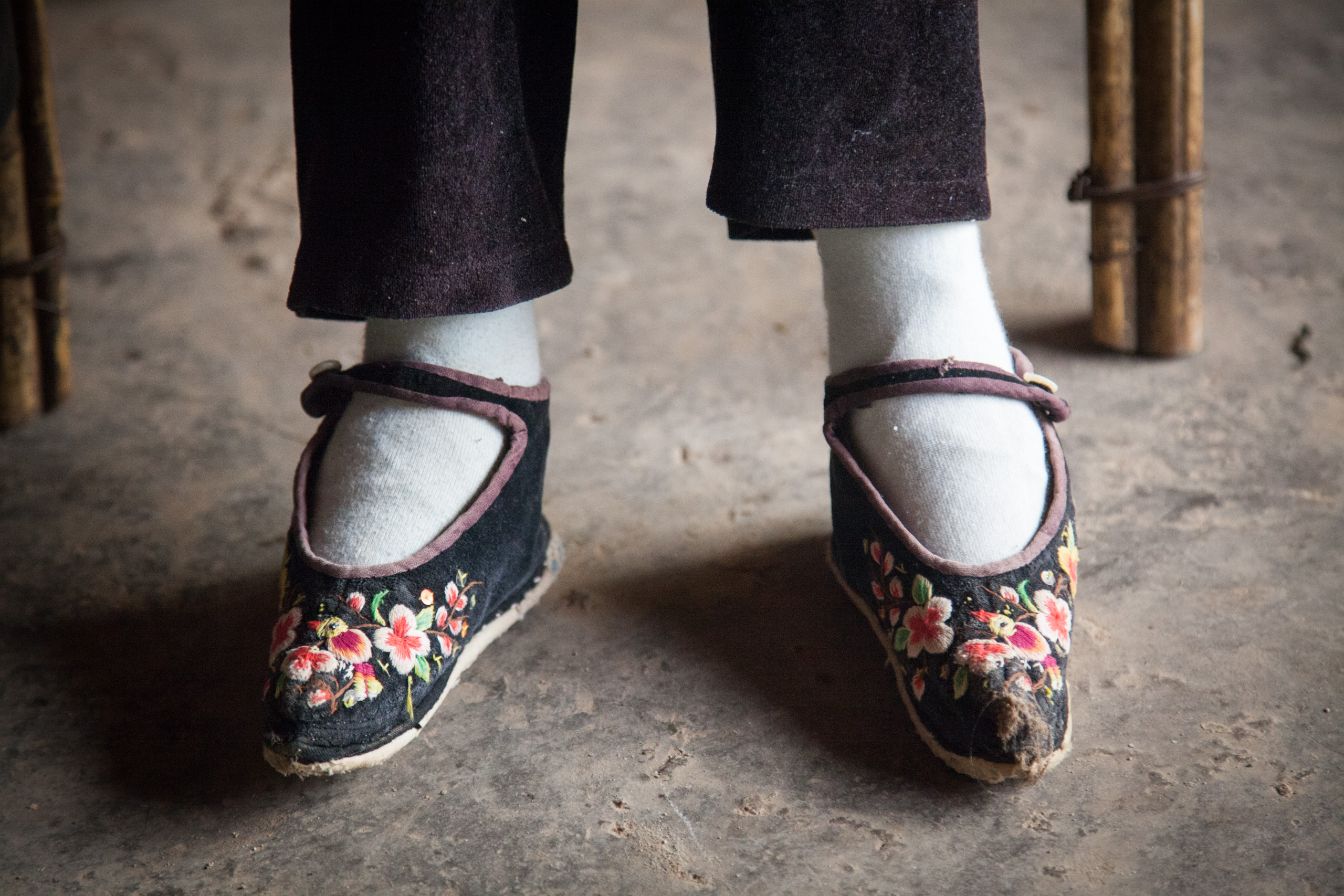
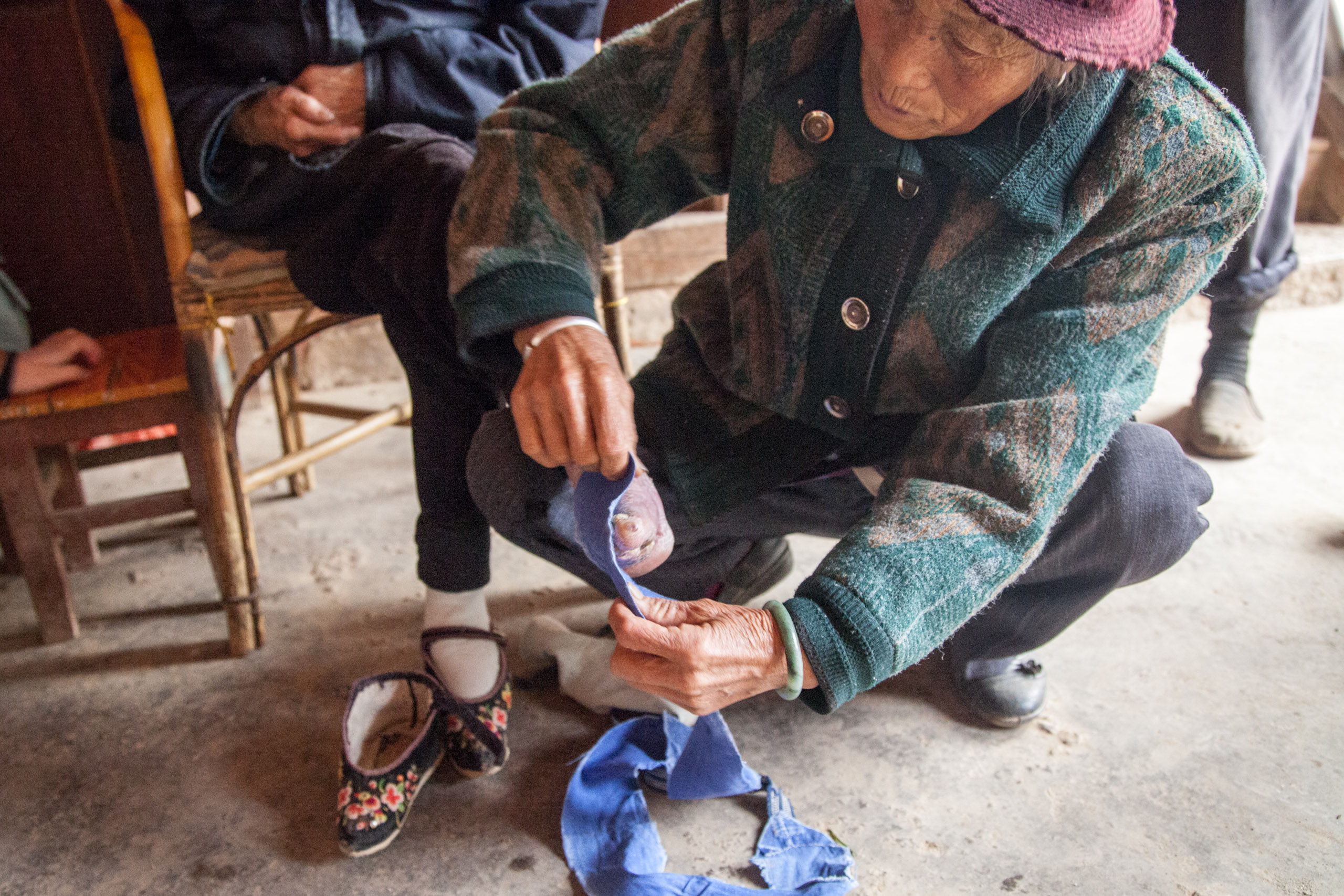
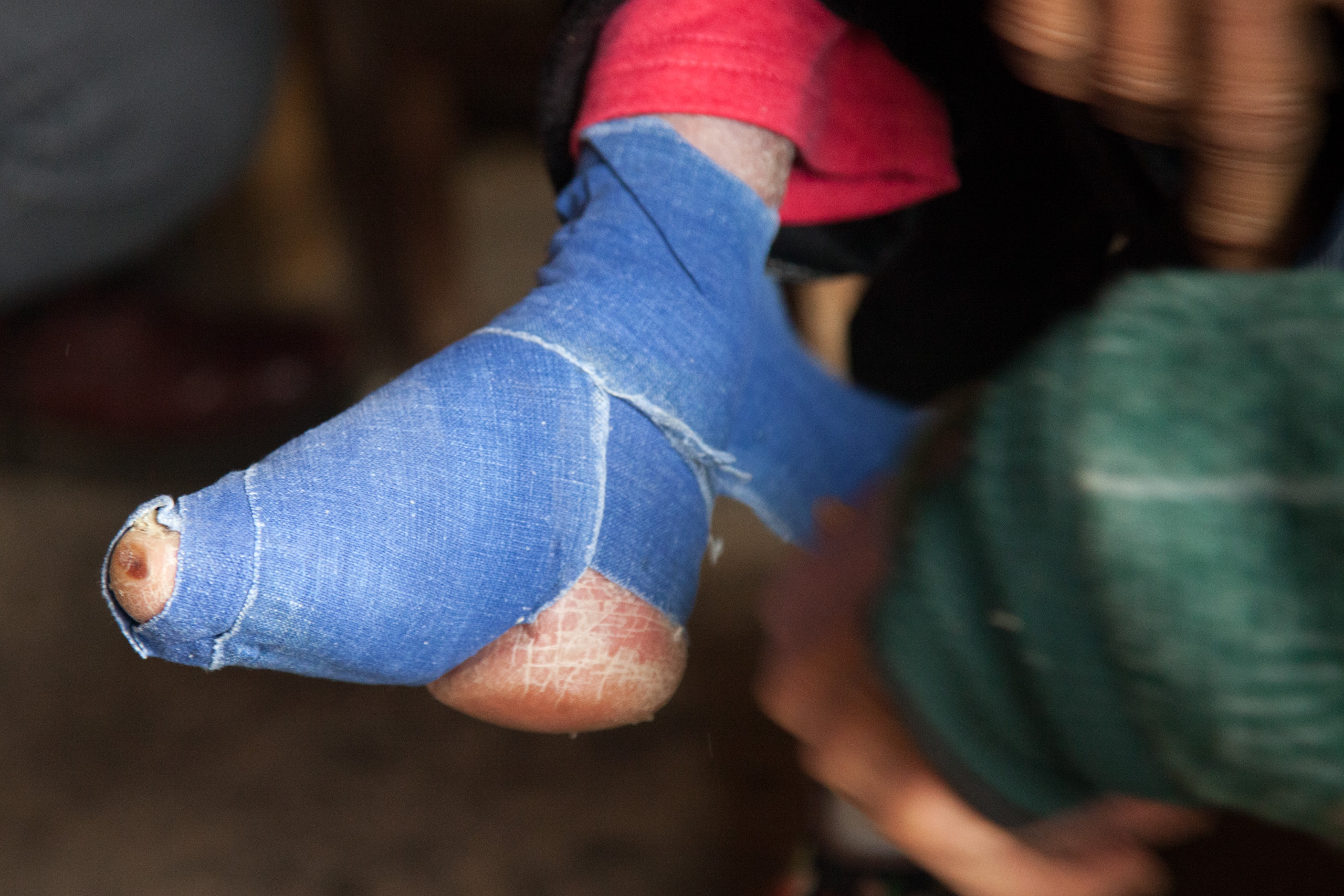

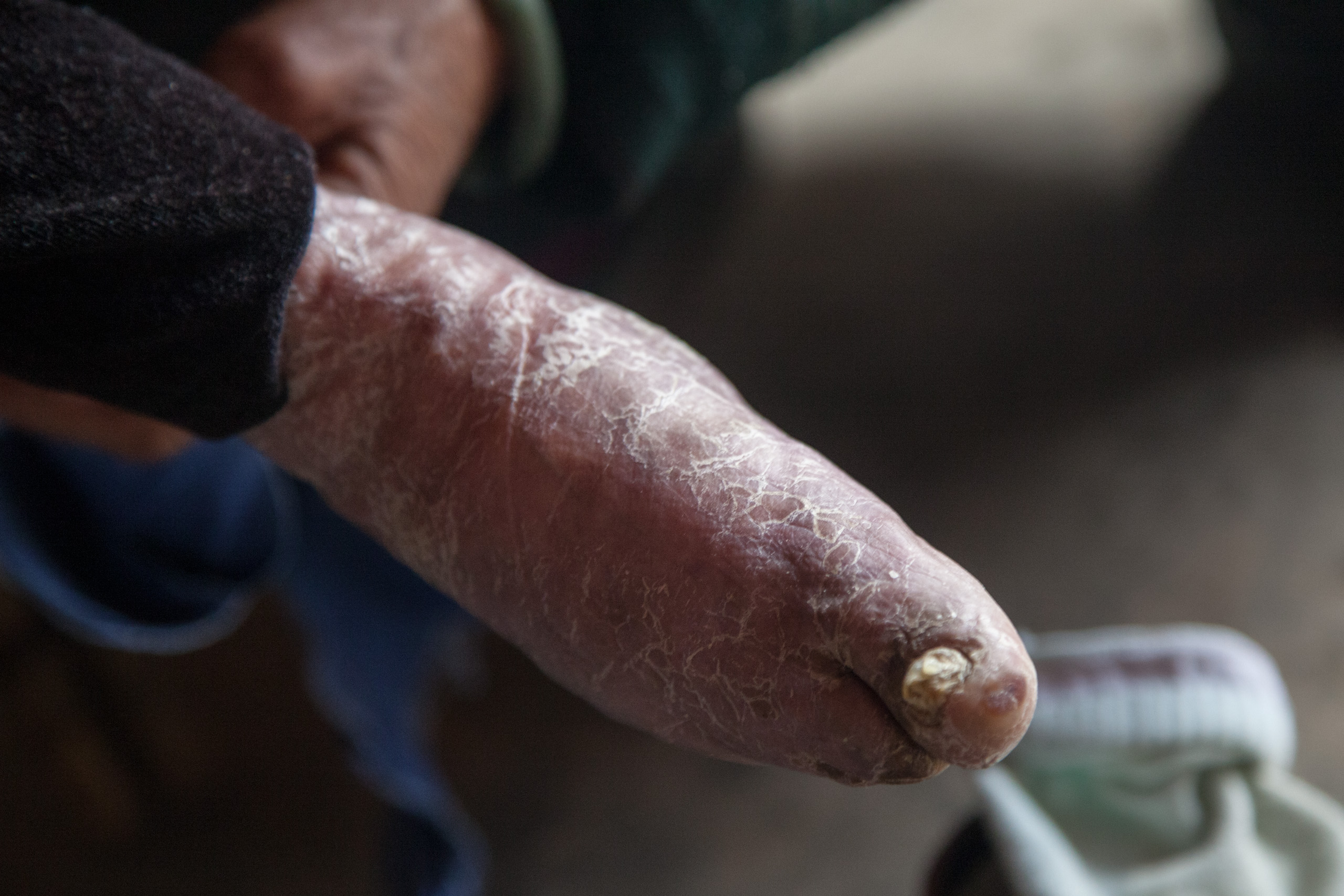
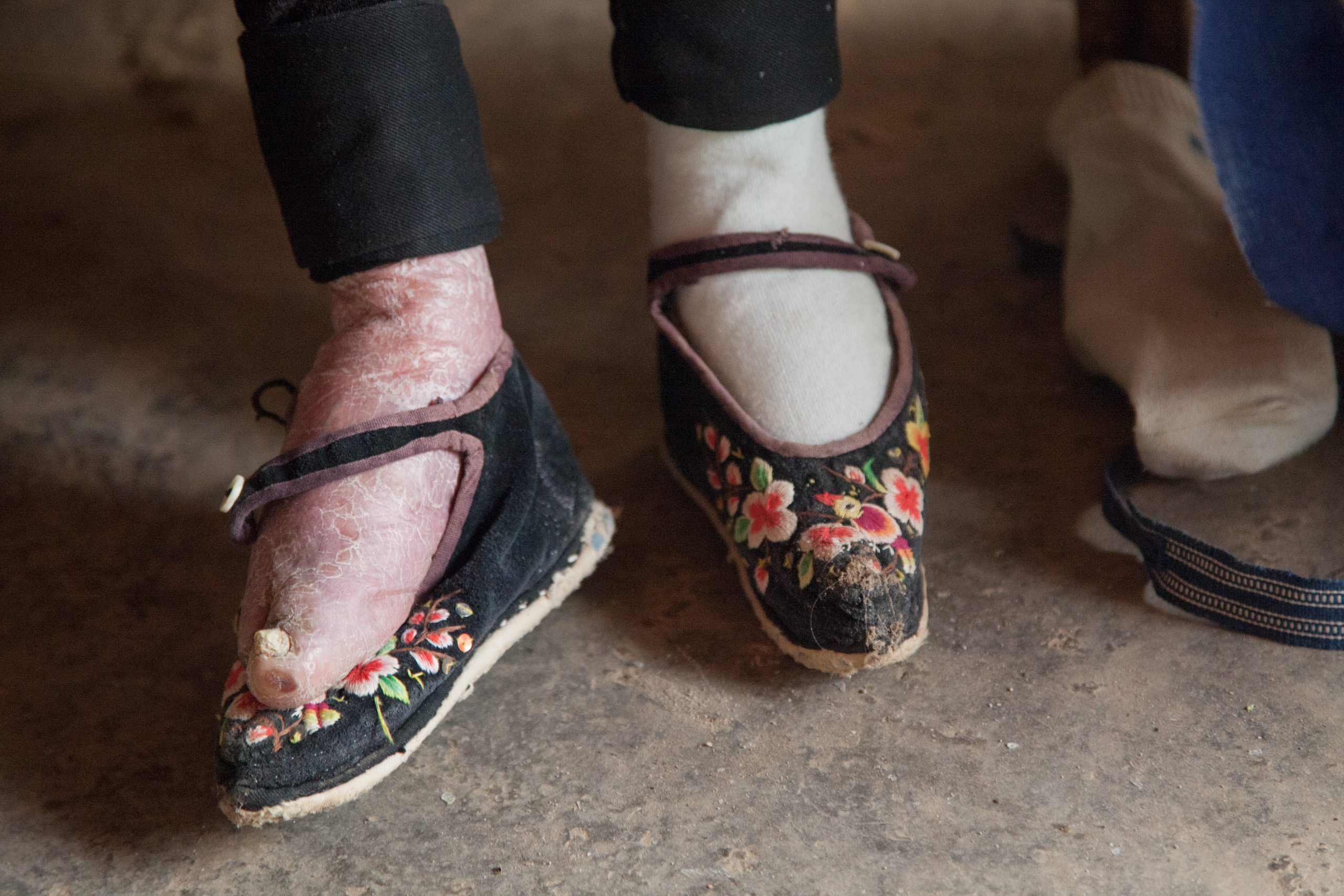
Yang Zhaoshi's daughter-in-law unwraps her bound foot. Photos: Gary Jones
YANG WAS BORN JUST one year after foot binding was banned in China, in 1912, following the fall of the imperial Qing dynasty and the establishment of the republic. The practice, seen by the new Nationalist regime as backward and shameful, continued furtively in remote areas, however.
Largely isolated from the authorities, the area around Liuyi was one of the last places in China to abandon the ritual, and girls’ feet were still being bound as late as the early 1950s — even after the communists had come to power in 1949 and Mao Zedong had famously extolled gender equality by declaring that women “hold up half the sky”.
By the late 1990s, in fact, there were still more than 200 bound-feet women living in and around Liuyi. Today, there are fewer than 20.
“The mountains are high and the emperor is far away,” says Yang’s eldest, employing an ancient Chinese saying to explain how foot binding persisted even once banned. Dressed in a blue Mao jacket and cloth cap, he looks every bit as out-of-time — in a modern China of cloud-busting skyscrapers, super-fast bullet trains and glitzy shopping malls — as his mother.
“[Foot binding] was kept secret,” he says. “If government officials came, the village girls would be locked away. Once the officials had gone, life would carry on as normal.”
A short stroll from Yang’s home, Pu Guifeng is exchanging village gossip at a shop selling seeds and fertiliser. Though the 77-year-old is willing to chat, she waves away the camera like a seasoned movie star dealing with bothersome paparazzi. “No photos,” Pu barks, grinning.
Pu has enjoyed a certain level of fame. In the early 1990s, she and an energetic sorority of Liuyi’s other remaining women with bound feet formed an unlikely dance troupe, performing as far away as the provincial capital Kunming, a three-hour drive to the north.
“We danced some disco, we did traditional tai-chi moves with fans and scarves,” says Pu. “We were very popular; quite famous, in fact. Even recently, just two weeks ago, some television people came down from Beijing, wanting us to dance for them.”
Pu says that, though many view her as an oddity nowadays, once upon a time the opposite was true. “Back then, if you didn’t have small feet,” Pu says, “you would be shamed for being different — you didn’t fit in, you were considered weird.”
And though the dance troupe was at best a novelty, and at worst something of a modern-day freak show, she relished her brief moment in the spotlight. “It’s a shame we don’t dance anymore,” Pu says. “I’m still quite nimble, but some of the troupe are too old now; in their 90s. It’s difficult to get them into a car to travel long distances.”
A TWO-HOUR DRIVE south of Liuyi, heading towards the border with Vietnam, the picturesque and pleasingly well-preserved walled hamlet of Tuanshan nestles on low hill amidst verdant farmland.
Originally established as a mining centre in the 14th century, Tuanshan’s ochre-hued residences, temples and ancestral halls were constructed later — during the 19th and early 20th centuries — when the area prospered from trade with Southeast Asia made possible by a French-built railway.
Outside one ancestral hall, an elderly woman without bound feet squats on the grey-stone threshold. A cardboard box at her side contains exaggeratedly miniscule silk shoes that she sells for Rmb20 (then about US$3) a pair to the occasional tourist.
“The small feet women used to make them and sell them, but they are too old now,” she says, adding that there are only two such women remaining in Tuanshan. “Head down towards the lake. Ask for Madam Zhu.”
Zhu Shao Qiong is soon found wiling away the sunny afternoon in the small convenience store owned by her third son (she has four, and three daughters). She is elegantly decked out in a traditional blue smock, pressed grey-blue trousers and peach socks, and her feet are encased in dainty black-leather lace-up shoes not much longer than a cigarette lighter. (The last factory making such shoes in China closed in the late 1990s; towards the end, the business — in the far-northeastern Chinese city of Harbin — was producing just 300 pairs a year.)
“I couldn’t understand why they were hurting me and I screamed for my mother. They said I had to have my feet made small or I would disgrace the family”
Zhu Shao Qiong, 96
Dwarfed by translator Sally’s size-36 Adidas sneakers, Zhu’s shrunken feet cannot be longer than 10cm in length. She totters with the help of a wooden cane topped by the carved head of a dragon.
Now 96 years old, Zhu says her mother passed away when she was just five. She was then cared for by her maternal grandmother, who bound her feet the following year.
“I couldn’t understand why they were hurting me and I screamed for my mother,” Zhu says. “They said I had to have my feet made small or I would disgrace the family. Afterwards, I couldn’t move. It was as if my feet were on fire. Relatives brought food to my bed, but I couldn’t even eat, I was in so much pain.”
Zhu claims to be of the noble Zhu family (the main attraction in the nearby town of Jianshui is the Zhu Family Garden, a 20,000-square-metre complex of more than 40 residences that served as home to the clan, which made its fortune in tin and opium). Though she vividly recalls the intense suffering of having her feet crippled for life, she bears no resentment.
In fact, Zhu says her grandmother was being kind, not cruel, to her. “It was thought that only girls with small feet were pretty and had value,” she says. “Only girls with small feet would find a husband from a good family, so it was the right thing for her to do.”
“We have to remember that before the 20th century, foot binding was not an imposition or torture that women would shriek from,” says Ko. “On the contrary, it was a privilege that they would embrace — if they were privileged enough to do so.
“Not all women could afford to have their feet bound, only those who could find an alternative means of livelihood indoors. In Yunnan, this meant those who had the skills and means — a loom, for example — to weave cloth at home.”
Like Yang in Liuyi, Zhu was also kept hidden when authorities came snooping. “When inspectors were sent here to make sure [binding] wasn’t happening anymore, our families would hide us away.”
AT THE ORNATE WODDEN entrance to a residential courtyard nearby, Zhu’s 95-year-old friend Xiong Xiufeng relaxes in the shade while a group of her middle-aged neighbours shell peas at her dainty feet. Like Zhu, she has clearly made an effort with her appearance — she wears a similar blue smock to that of her friend, as well as velvety black trousers.
Her doll-like shoes, no bigger than an infant’s slippers, are crafted from star-spangled aubergine corduroy.
Xiong’s mother began binding her feet when she was six. “I couldn’t even move, it was so painful,” says Xiong, who came from a middle-class family of salt traders, and whose father died leaving eight children behind.
“They wouldn’t let me take the binding away no matter how great the pain. It was wrapped on tight, so I couldn’t get it off, and my mother would beat me if I tried. At that time, if your feet were large, no man would marry you; no other family would have you.”
At the age of 14, Xiong married a tin miner from a respectable family, which, she says, may never have come to pass if her feet had not been bound. The couple had six children, but when asked if she had ever thought of binding her own daughters’ feet, she answers immediately and emphatically: “Absolutely not. This is something from the old society. Those days are gone.”
Xiong is clearly proud, however, of her strikingly unusual shoes, which she made herself, and she twists and turns to show them off from every angle. She complains that her poor eyesight means that a simple pleasure she once relished is now a thing of the past.
“I used to enjoy making shoes very much,” Xiong says, “but my eyes just can’t cope any more.”
Asked how many pairs of shoes she has, those eyes suddenly brighten, Xiong’s reedy voice rises and she eagerly snatches at translator Sally’s hand. In a moment, it is absolutely apparent that, although Xiong was born in an era when China was a very different country, some things — for a certain type of lady — were the same back then as they are today.
“Oh, I have so many shoes, but not as many as when I was younger,” she says. “I have more than 20 pairs, I think — I have a big box full of them. I’ve always liked shoes.” ◉
Versions of this story ran in Frankie magazine in Australia (PDF here), The Week in the UK and Post Magazine in Hong Kong (PDF), all in 2013.
SHARE
Tròn and Larry
Twelve-year-old amputee Tròn appeared on the cover of LIFE magazine in 1968, tormenting America's conscience as conflict in Vietnam dragged on. What became of the child immortalised by the war’s most acclaimed photographer?
LARRY BURROWS WAS a seasoned veteran of the Vietnam War when, in early 1968, he met 12-year-old Nguyễn Thị Tròn.
Operating out of the southern Republic of Vietnam’s capital Saigon, the photographer had been covering the conflict for LIFE magazine since 1962, shadowing American troops, documenting ferocious firefights, surviving hours in the air with helicopter-gunship crews, and freeze-framing harrowing moments of bravery and despair, exhaustion and appalling violence in combat zones.
Burrows is celebrated today as one of history’s most accomplished war photographers, but while much of his best Vietnam work had been shot in the thick of the action, he had come to be haunted by the trauma visited upon the Vietnamese people he described as non-political, “simple and hardworking”.
Most, he believed, had been steamrollered by both the South and the communist North to “bear pain in silence”. Burrows noted their stoicism with awe.
“I was walking the streets of Saigon, as I’ve been doing for six years, thinking I’d never really told of the misery and suffering,” the photographer later recalled of meeting Tròn. “Round a corner, in a Red Cross compound, two Vietnamese children were rocking back and forth in a swing […] Walking along the fencing I could see their small bodies rocking to and fro. Now I had a clearer view. They were not the same as any other two youngsters, for they only had one leg between them, and it was Tron who propelled the swing.”
Tròn had lost her right leg just months earlier, in October 1967. The inquisitive youngster had been collecting firewood and foraging for plants in a Viet Cong-infiltrated no-go area — a free-fire zone in which American troops had clearance to shoot to kill anything that moved. The rustling of branches, perhaps the pale flash of Tròn’s conical nón lá straw hat, and she was spotted from above. The metallic chak-a-chak-a-chak-a of a US helicopter’s machine guns rattled out, startling songbirds from the banyan trees.
Tròn’s injuries resulted in amputation of her leg below the knee.
A SELF-CONFESSED “adventurer by nature”, Burrows regarded US-supported South Vietnam’s fight against the North as virtuous (he was “rather a hawk”, he would write, who “generally accepted the aims of the US and Saigon”). His meticulous, unflinching approach to getting the picture resulted in arguably the most searing visual record to emerge from the Southeast Asian war.
But Burrows also knew the full story of the conflict was not to be found in a monsoon-flooded foxhole, and that thousands of modest battles were being fought across Vietnam every day. He wanted to tell that story, and to photograph a personal but no-less-crucial fight in the war that had raged for more than a decade.
Burrows and his interpreter approached the children on the swing, asking Tròn where she lived. “I felt then that if I could only show the sufferings of her people through her eyes,” the photographer said, “this could speak of the huge losses the Vietnamese have suffered over the last 25 years.”
A few weeks, perhaps a month later, 41-year-old Burrows rocked up to the tumbledown hamlet of An Điền in the rural district of Bến Cát in Bình Dương Province, less than 30 miles north of Saigon.
And so began an unlikely friendship between one of Vietnam’s most battle-hardened photojournalists and a war-damaged child.
BURROWS’ COVER OF LIFE magazine on November 8, 1968, during a relative lull in hostilities, featured the maimed youngster and the headline: “As the Bombing Stops — This Girl Tron”. In the cover picture, she balances on her surviving leg, watching nervously as a Saigon workman fashions a crude wooden limb at his bench.
Burrows had visited Tròn and her family a number of times in 1968, documenting her rehabilitation: the fitting of her primitive prosthesis, learning to walk and ride a bicycle again, returning to school and sorting vegetables besides the family’s dilapidated shack, just one of the village homes that LIFE’s Saigon bureau chief Don Moser described as “flimsy constructions of corrugated iron, cardboard and the universal pop art of the country, sheet metal stamped with beer can labels”.
Burrows’ pictures were published over 12 pages and captioned in his own words. One description recounts Tròn trying her new leg for the first time: “Then it was her turn to be fitted and she was frightened. She buried her head against a post as a workman shaped a leg from wood blocks, and then sat while a plaster mold was squeezed against her stump. Finally she could stand. She balanced with the help of crutches, bit her lower lip and let the crutches be taken away. I won’t forget that moment. Tears ran down my cheeks, but I blinked so I would not miss seeing any of her joy and excitement.”
Many affecting images came out of the Vietnam War. One of the most enduring is Nick Ut’s Pulitzer-winning 1972 image of naked and burned nine-year-old Phan Thị Kim Phúc fleeing a napalm attack in Trảng Bàng — less than 10 miles from where Tròn was shot.
Ut’s picture is one of the most globally recognised of the 20th century, and Phúc became feted internationally as “the girl in the picture”. Her story since then is well known: in the 1992, she and her husband secured political asylum in Canada. She has since become a mother, a United Nations goodwill ambassador and an activist highlighting the plight of children affected by war.
But what of Tròn? What has been the fate of the girl in Larry Burrows’ pictures?
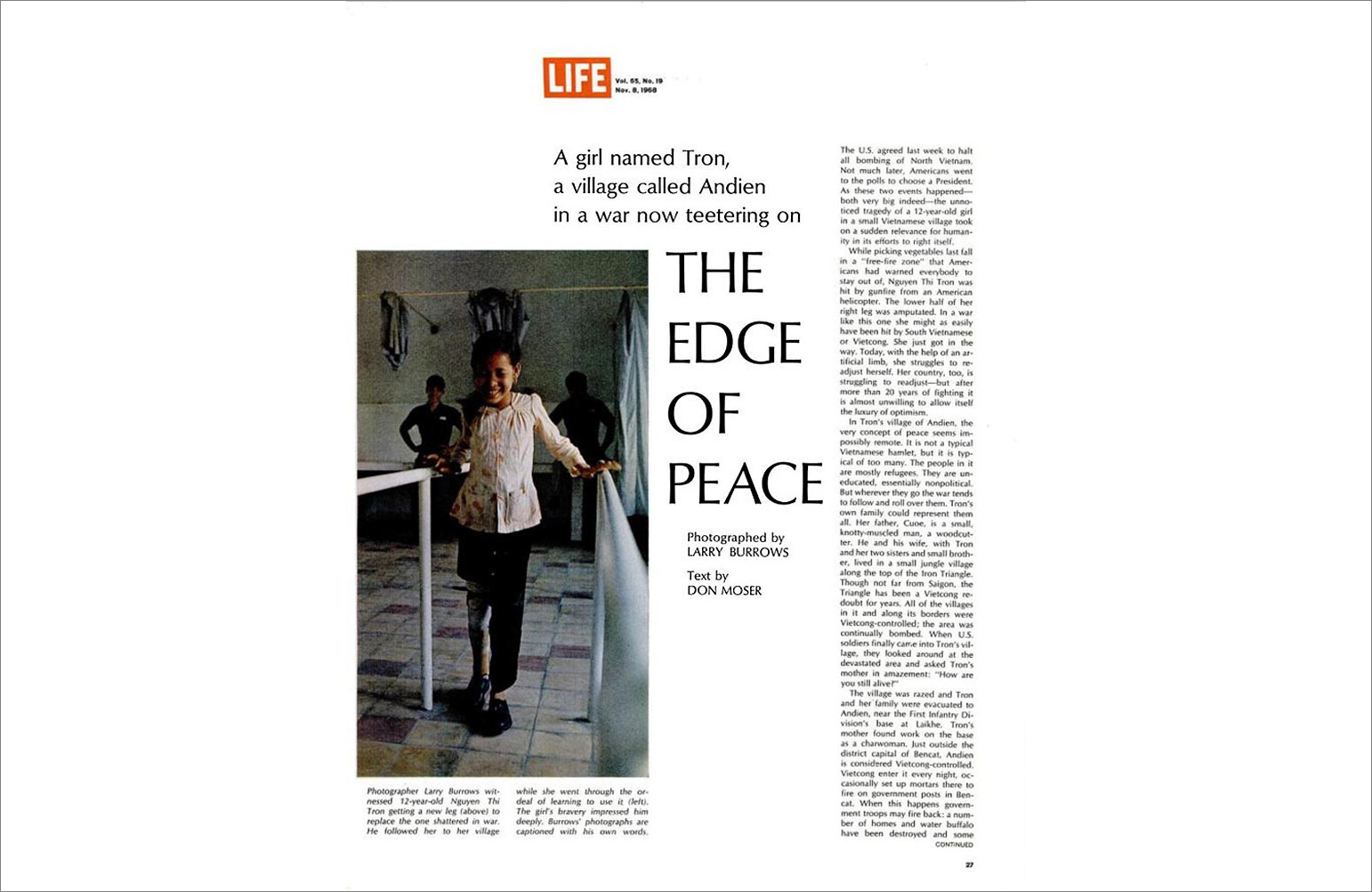
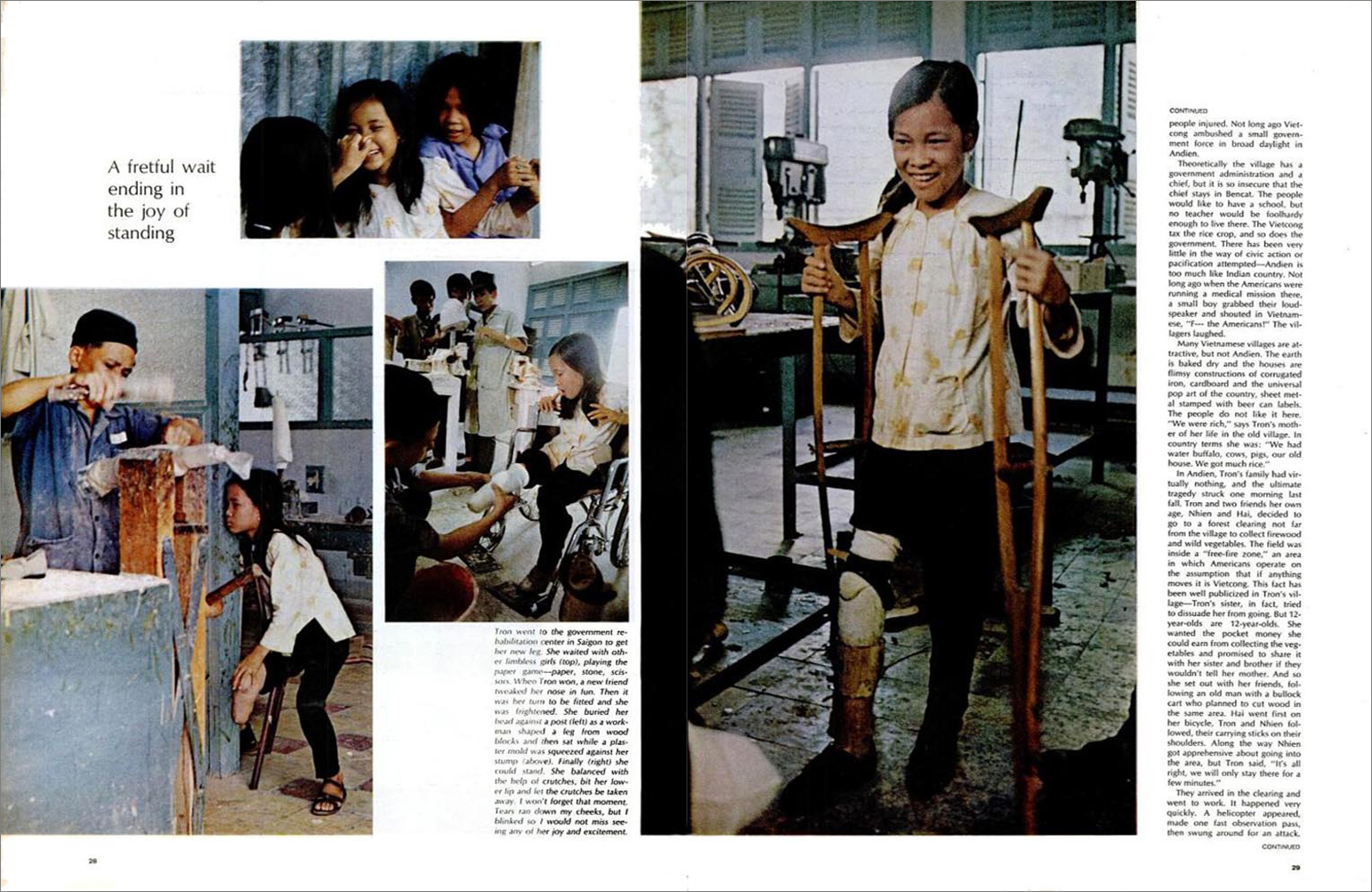
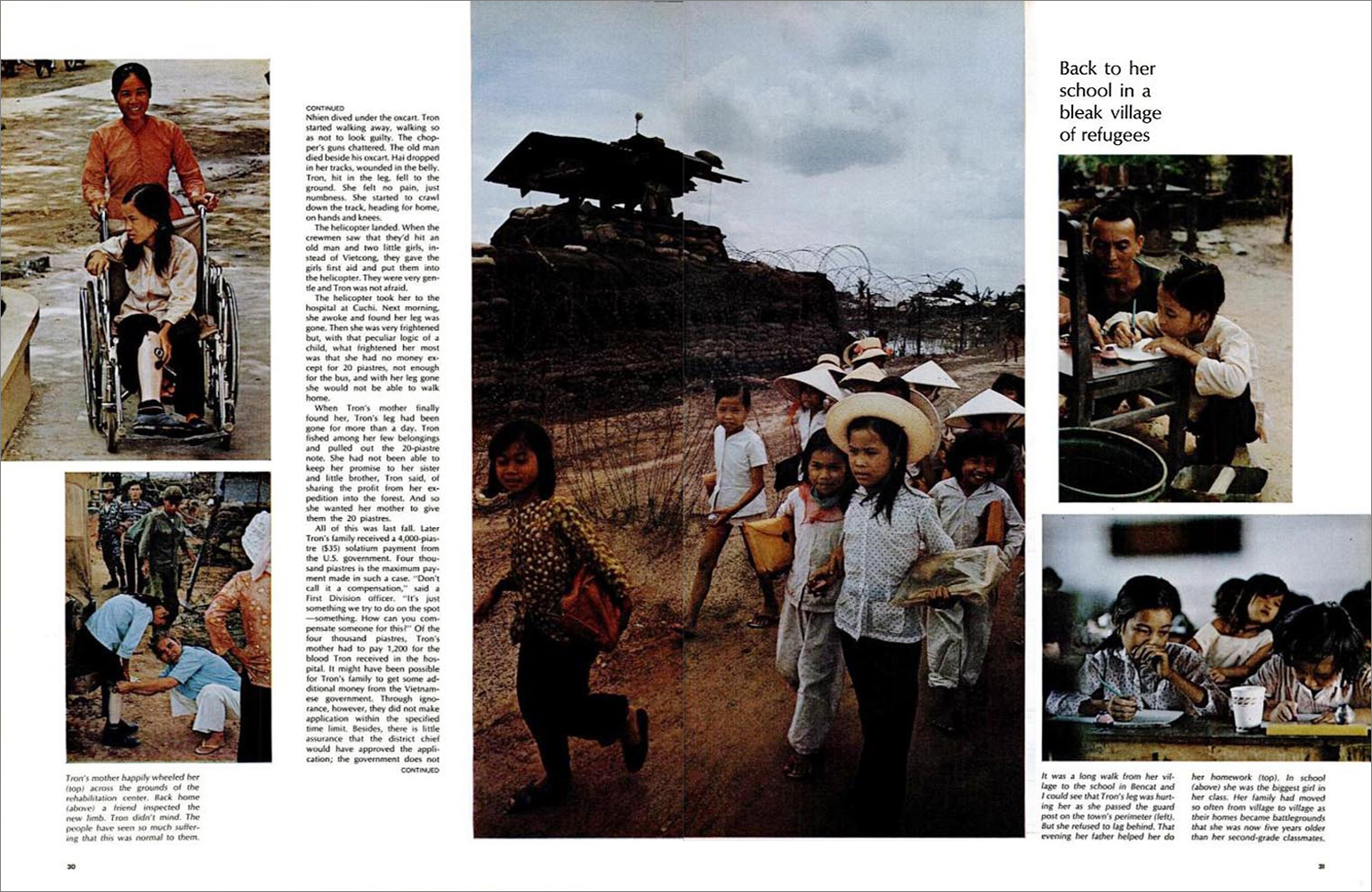
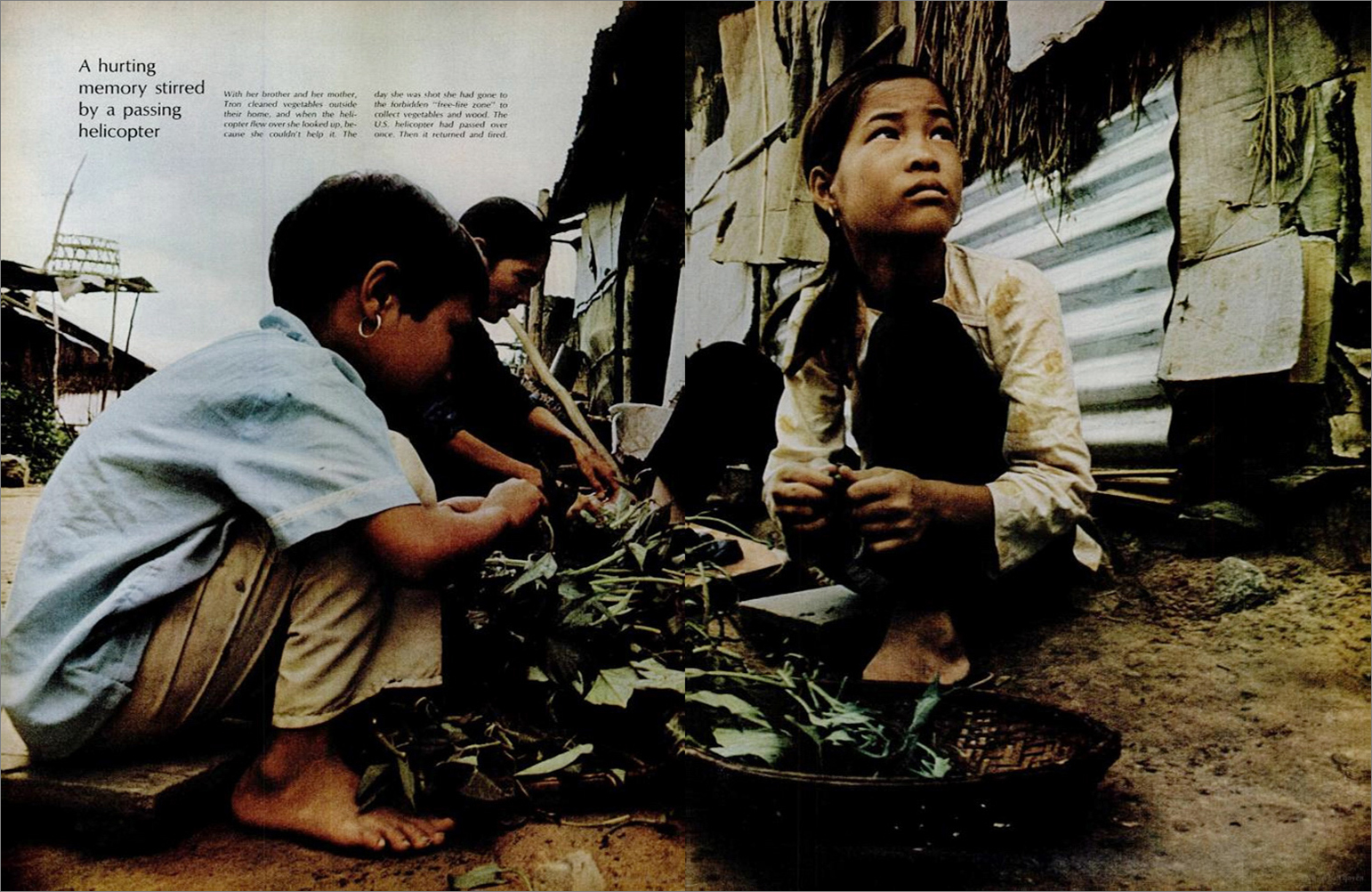
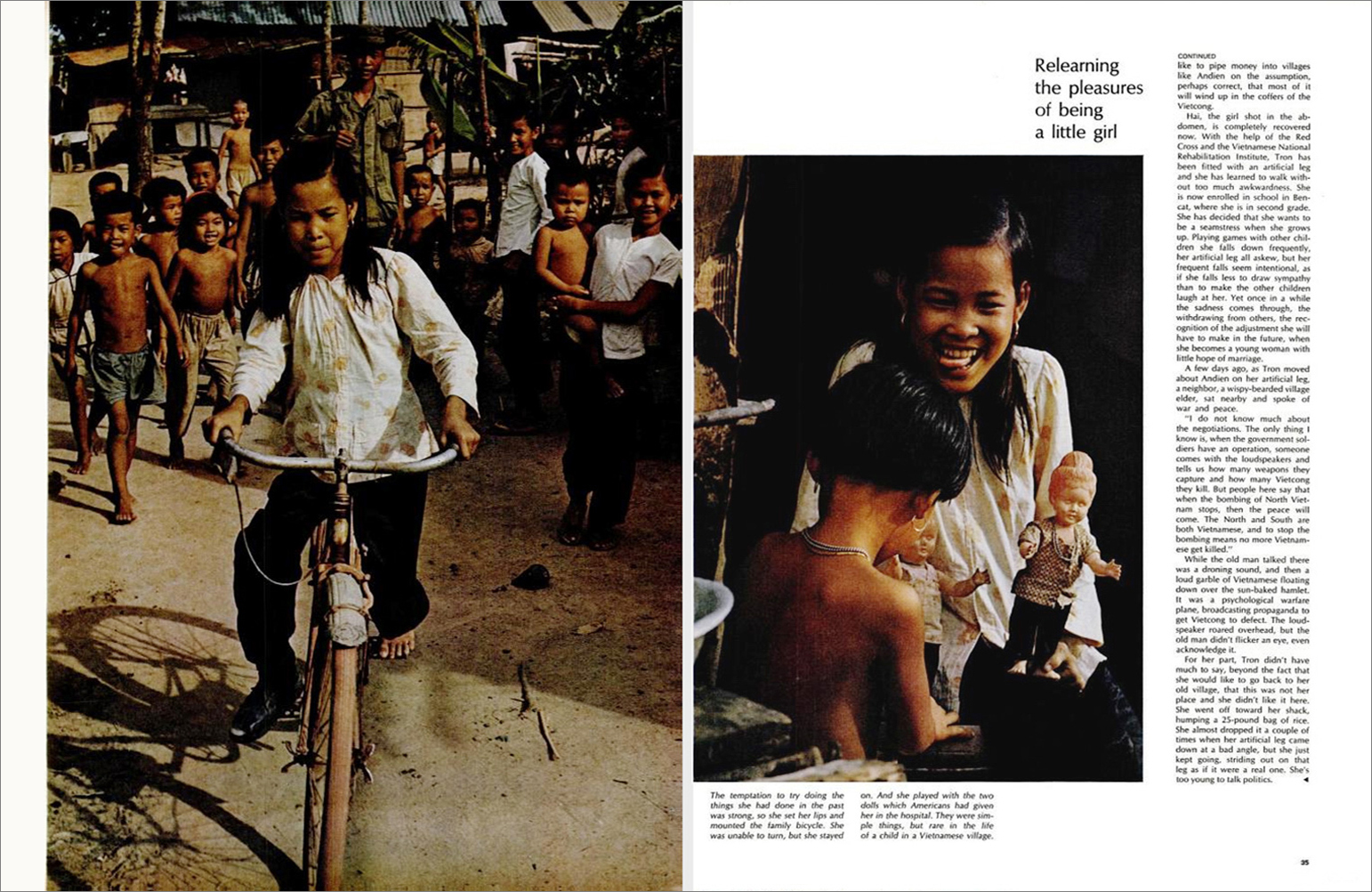

Tròn's story, with Burrows' pictures, in LIFE magazine, November 8, 1968.
SAIGON WAS RENAMED Ho Chi Minh City, in honour of the North’s revolutionary leader, in 1976, a year after the war’s end. Heading northeast from that city today, a three-hour drive passes through Củ Chi, home of the underground network of hidden tunnels that were the Viet Cong’s base of guerrilla operations for the Tết Offensive in early ’68, as well as the US military hospital to which Tròn was taken after being gunned down.
My destination is Suối Đá commune in the Dương Minh Châu district of Tây Ninh province, which borders southern Cambodia. The land here is sun-scorched, roadkill flat and agricultural, with star apple, rubber, sugarcane, peanut and maize being popular crops. Perhaps a kilometre down a side road of compacted red earth hides a small shack of weathered wood, bare brick and concrete. The shack is a community convenience store sparsely stocked with candy and potato chips, basic medicines, stationery and everyday essentials.
The store also provides seamstress services, and a sewing machine takes pride of place at the road-facing service hatch. Tròn sits at a concrete table out front, shaded by leafy banyans. Cicadas thrum in the branches and roosters scrabble among roots that have raised the land, causing flooding to the shop with rainy season.
Petite and slender in build, her wavy black hair only flecked with grey and pulled into a ponytail, Tròn, now 62, wears loose-fitting black trousers and a short-sleeved floral blouse — the practical, no-nonsense uniform of rural women across Indochina. She lives with Chi, her bubbly 30-year-old niece whose smile sparks readily beneath her nón lá, and who welcomes us with chilled coconut water.
Tròn recalls the day her life changed.
“I’d only run a short distance when shooting from the helicopter started. I tried to hide in the trees, but I was hit”
Nguyễn Thị Tròn
Tròn, her farming mother and father, two sisters (one older, one younger) and little brother had lived within the 120-square-mile communist stronghold known during the war as the Iron Triangle. Located between the Saigon River to the west and the Tinh River to the east, and about 25 miles north of Saigon, the area’s strategic position made it the scene of much fighting. Destruction of their village saw the family evacuated to An Điền, close to a Republican army base at Lai Khê, also headquarters of the US Army 1st Infantry Division.
“My family was very poor and my father went to the forest every day to collect firewood to sell in the village,” remembers Tròn, who speaks in a lilting whisper and whose movements are slow and measured. “My mother worked for whoever would hire her. We lived day to day, my parents doing whatever they could.”
Though villages in the area were under Republican control by day, the situation was less clear after dark, with Viet Cong moving around freely. There was often confusion as to who was in charge.
“In that area, there were two zones: the Liberated Zone, which belonged to the communists, and the Republican Zone, controlled by the South, so people had been split up in the region,” Tròn says. “One day, Republican soldiers said we could go into the liberated area, maybe to see relatives, and I went with two friends, children like me, to collect wood. One of my friends had a bicycle. My other friend and I ran behind her.”
The children were exploring when came a shrill warning to flee. “An old lady shouted that a helicopter was coming from the Saigon River and that we should leave quickly, so my friends and I started running back,” Tròn remembers. “I’d only run a short distance when shooting from the helicopter started. I tried to hide in the trees, but I was hit.”
One of Tròn’s young companions was also shot, in the abdomen, and later made a full recovery. LIFE reported that a man cutting wood and loading an oxcart in the area was killed by fire from the helicopter.
“I felt no pain at first; my leg felt numb,” says Tròn, whose 87-year-old mother, Nguyễn Thi Xuân, lives close by and sways in a hammock outside the store. “I had grown up in the liberated area, and older people had told me that if I was shot by the Americans I might die, so I got up and tried to run. I was so scared. But when I tried to run, I couldn’t. My leg would not work and I cried out for my mother.”
The helicopter landed and the soldiers realised their mistake, gathering up the wounded girls to evacuate them to hospital. “That was when I felt very great pain. I did not know how to stop it and kicked at the American man treating me.”
Hearing of the shooting, Tròn’s mother hurried to the restricted area, finding dried blood and learning that children had been gunned down, perhaps killed. She headed for the US army base. “I spoke to the interpreter there. I asked if she could help me find my daughter,” the older woman recalls, her sun-weathered face suddenly animated.
Tears well in Tròn’s eyes as she listens to her mother’s account and she turns away to hide her sadness. “They called all the hospitals in the area, they could not find her, but they said there was a hospital where they had not checked, at Củ Chi — the army hospital of the Americans.”
“My leg started to itch, so I tried to scratch it with the other one. That’s when I realised they had cut off my leg, and I cried”
Tròn
Far from her home and family, Tròn felt alone. “Many people came and asked me who I was, what I did, what I’d been doing there, who I was visiting,” she remembers, the desperation of that moment, 50 years ago, entering her voice. “I tried to answer but I was in so much pain. I just wanted the pain to stop, but they kept questioning me.”
And Tròn remembers discovering the loss of her limb while in a hospital bed. “My leg started to itch, so I tried to scratch it with the other one,” she says. “That’s when I realised they had cut off my leg, and I cried.”
Reaching the army hospital was difficult for Tròn’s mother. Movement in the area was restricted, and she waited days for the only bus. “When I found her, she just cried and cried,” she says, adding that her daughter was tormented by the thought that, coming from a peasant family, she would never be able to work. “She said, ‘I can no longer have a life, I am useless, I will die.’ I tried to reassure her, telling her I would do my best to earn a living so that she could grow up. I told her, ‘I will never leave you. I will always take care of you.’”
A group of pictures in Burrows’ LIFE essay shows Tròn fooling around with young friends, taking on “the role of a comic to hide the sadness”. His caption reads, “Like her country, Tròn can never be the same again after the war is over. She makes the best of it even when she falls while playing hopscotch, turning it into a clownish joke. But sometimes the sadness appears. ‘I will stay with my mother until her dying day,’ she told me. ‘I have only one leg. I can do nothing.’”
Tròn’s disability, and how that impacted upon a woman of her generation and background, means she never found a husband or had children of her own.
THOUGH YOUNG TRÒN came to refer to Burrows as her American father (to the unworldly Vietnamese child, all Caucasians were Americans), Burrows was British.
Born in London in 1926 to a truck driver father and housewife mother, Henry “Harry” Frank Leslie Burrows left school at 16. Keen on photography, and after stints working in the darkrooms of the Daily Express newspaper and Keystone photo agency, he joined LIFE’s London bureau as errand boy-cum-apprentice. Burrows was called Larry to avoid confusion with another Harry in the office.
Increasingly adept with a camera, Burrows progressed to shooting everything from the Suez crisis and French starlet Brigitte Bardot on a London shopping sally to Ernest Hemingway touring Spain with its greatest bullfighters, and the 1962 Indo-China War. But though LIFE sent the photographer on varied assignments from his Hong Kong base, including the 1964 Tokyo Olympics, Burrows lost his heart to Vietnam.
Tall, rake-thin and with unruly dark hair and thick-framed glasses (he was rejected from the British military because of poor eyesight), Burrows looked part Hollywood matinee idol and part gear nerd (he was often ribbed for forever tinkering with his top-of-the-range cameras). Though a loner, his age, reputation for fearlessness and gentlemanly manner made him a father figure to younger photographers of the war, to whom he would quote from Shakespeare’s Henry V (“We happy few; we band of brothers”).
One of Burrows’ best known photo essays, published in LIFE on April 16, 1965, was entitled “One Ride with Yankee Papa 13″ and documented a fatal US mission out of Da Nang. Multiple helicopters were taking part in what was expected to be the routine assignment to airlift Republican troops, and Burrows tagged along. When the choppers hit the landing zone, dug-in Viet Cong attacked and “played merry hell”, in Burrows’ words, with “raking crossfire”.
Discovering that another helicopter, Yankee Papa 3, had been downed, Yankee Papa 13 rescued two of its injured American crew. One died while the bullet-riddled aircraft limped home.
Burrows’ pictures, taken before, during and after the firefight, not only convey the panic of the ambush but also tell a human story. The visual narrative begins with fresh-faced, 21-year-old helicopter crew chief Lance Corporal James C. Farley on liberty the day before the mission, goofing around in a Da Nang market. It concludes with Yankee Papa 13 back at base, when exhausted Farley surrenders to his grief, collapsing in tears.
Burrows also pioneered the use of colour film in combat photography, giving his work a greater sense of reality than black and white, which can distance the viewer from events. His most famous colour image from Vietnam was taken in 1966 and has come to be called “Reaching Out”. The tableau-like scene reveals wounded Marine Gunnery Sergeant Jeremiah Purdie wading through thick mud and extending his arms towards a fallen comrade on a defoliated, battle-scarred hill just south of the Demilitarised Zone.
In his introduction to the book Larry Burrows: Vietnam, published in 2002, Pulitzer-winning journalist David Halberstam, who reported from the war-torn country for the New York Times in the early ’60s, writes: “Because of […] his talent, his courage, and his particular feel for the Vietnamese people, [Burrows] became the signature photographer of that war, a man whose journalism, in the opinion of his colleagues and editors, reached the level of art.”
But while journalists will always hark back on Burrows’ daring and technical brilliance, Tròn remembers his kindness — and his dashing safari suits.
MEETING BURROWS, TRÒN says, was a “pivotal moment” in her life, and he visited her every month or two. “Even now, I can still see Larry, very clearly,” she says, and her melancholy dissolves. “He would shout ‘Tròn’ and shake my hand. I’m still impressed that he wore this special kind of jacket that reporters wore, with four pockets. He had several of them, I remember.”
Burrows’ daughter, Deborah, was the same age as Tròn and he reached out to the injured girl and her family, even buying the corrugated-iron sheeting needed to fix the roof of their leaking shack.
“He was funny. He always tried to make jokes and cheer me up,” Tròn says. “I was very sad sometimes, and he would make me feel better. He would take me shopping in the city, and when he came to my home he would always bring gifts, like toys or food. Seeing that my family was so poor, he bought materials to rebuild our hut.”
Burrows also recalled moments of fun. “In between picture-taking we played children’s games, some that I knew, some that Tròn had to teach me,” he told his editor. “She wants to be a seamstress so I bought her some cloth. By the time the story was finished we were very close.”
The story of Larry Burrows and Tròn, however, was far from over.
Burrows continued to drop by An Điền in 1969, a year in which “a degree of disillusion”, he wrote in LIFE, had settled over the war-weary South Vietnamese. A nagging unease was also crystalising in his own work.
The power of Burrows’ photographs of Tròn had pulled at heartstrings in the US, and a two-page follow-up spread appeared in LIFE on December 12, 1969, two years after the loss of her leg. The sequel told of how LIFE readers, moved by the girl’s plight, had sent gifts (which Burrows distributed in Tròn’s village); how she had a new baby brother and “had outgrown her original artificial leg and found it difficult to walk without an embarrassing limp”.
Burrows had taken Tròn to be fitted with a more comfortable limb, as well as on shopping trip, which he photographed. “On her recent trip to Saigon, the prospect of buying new shoes excited Tròn almost as much as her new leg,” the LIFE text read, continuing, “[…] But in choosing shoes, she might have been any 13-year-old girl. She bought five pairs of practical sandals — and couldn’t resist a pair of pretty white pumps.”
WITH HEAT HAZE rising from the dusty road and only the occasional three-wheel tractor passing by to compete with the cicadas, Tròn’s niece Chi has prepared lunch of rice soup, chicken cooked with coconut milk, black bean tea, and sliced watermelon and jackfruit. Tròn is pleased that her guest enjoys the simple fare (“I was worried our food would not be acceptable,” she says, smiling shyly) and she searches out the meatiest pieces of chicken with her chopsticks to slip them into my bowl.
Tròn wants me to see her collection of Burrows’ pictures of her, and though I’m confident I’ve seen them all before, her mother, sprightly for her years, leaps onto her bicycle to return in minutes. The pictures — some on photographic paper, others simple laser prints — were given to Tròn by Burrows’ New York-based son, Russell Burrows, who, with his then 16-year-old daughter, Sarah, searched her down in 2000, when an exhibition called Requiem, of Vietnam War photographs and including his father’s work, opened in Hanoi. (Requiem now has a permanent home at the War Remnants Museum in Ho Chi Minh City.)
Among Tròn’s collection are pictures that never made LIFE’s pages. The most intriguing shows young Tròn outside the family’s hut in An Điền. She sits at a sewing machine, of the old-fashioned type, manually powered by a foot pedal, which she pumps with her prosthetic leg. Her mother, carrying the girl’s new baby brother, stands behind her, smiling proudly.
“Once, Larry asked what I wanted to do when I grew up,” Tròn says. “I said I would like to learn to sew. A month later, he came back with a sewing machine.”
During 1970, Burrows dropped by occasionally when in Vietnam, but persistent malaria meant he spent a proportion of the year working in Europe, away from the tropical heat. He was also concerned about his emotional attachment to the injured Vietnamese child.
“Larry became quite attached to Tròn and she to him, and this worried him constantly,” LIFE’s Saigon Bureau Chief Moser later recalled. “He realised that if she became too dependent on him, her life would be even more difficult when he left her. So he tried to maintain a certain emotional distance from her, acting like a cheerful uncle and trying — not always successfully — to mask the depth of his own feelings.”
Having taken sewing lessons paid for by Burrows, Tròn, now a teenager, used her sewing machine to supplement the family’s income, but by 1972 it was decided that they would move north, to Tây Ninh province, to find work. “Life was so poor where we were,” Tròn says.
Transporting the sewing machine, the family’s only possession of value, would be risky. There would be roadblocks along the route, and soldiers might confiscate the expensive machine, suspecting it stolen. Tròn’s mother trekked to Saigon, to LIFE’s office, to find Burrows to obtain a letter confirming ownership.
There she learned that the photographer, at the age of 44, had been killed.
“He had deep passions, and the deepest was to make people confront the reality of the war, not look away from it”
Ralph Graves, LIFE’s managing editor in 1971
Larry Burrows died alongside fellow photojournalists Henri Huet of the Associated Press (AP), Kent Potter of United Press International and Keisaburo Shimamoto, a freelancer working for Newsweek, when their helicopter was shot down over southern Laos on February 10, 1971. They had been covering Operation Lam Son 719, a massive invasion of the neighbouring country by South Vietnamese forces against the Vietnam People’s Army and the Pathet Lao.
Looking back, Tròn says that as a youngster she would mischievously play tricks on the Englishman, testing his patience, which she now regrets. Knowing that ice-cold water was not easy to come by, that’s what she would demand whenever Burrows asked if she was thirsty.
“Once he took me in a helicopter from Tân Sơn Nhất airfield, to fly me back from Saigon to my hometown, where there was a big American army base. I said that I only wanted to drink cold water, and he agreed, finding some ice and waiting until it had melted to give to me. Only then did we get the helicopter. He treated me so well and sometimes I was bad.”
The most poignant photograph in Tròn’s collection, which she dwells over more than once, was not actually taken by Burrows. In the picture, Tròn wears an offbeat gift from the newsman: a woollen bobble hat unsuitable for the tropical sun overhead. The photo was shot, possibly by Burrows’ interpreter while holding his camera, when he delivered the sewing machine, the entire village jostling to see.
Two years after Burrows’ death, Tròn’s father fell ill and, with no money for treatment, he also passed away.
Tròn says the photograph, which she has had laminated for its protection, is precious because “it has the two most important men in my life”: her father and Burrows. She runs her fingers over the plastic, brushes a tear from her cheek and whispers to both men, “Why did you have to die?”
TV NEWS CORRESPONDENT Edgar H Needham carried out the last interview with Larry Burrows, at the LIFE man’s office in Hong Kong on January 26, 1971, just 15 days before his death. Needham described Burrows as “an urbane, gracious Londoner with a perpetual twinkle in his eye” and “a phenomenon — one of those people who keep up the average of the human species. He could inspire, but he could not be imitated. His touch with a camera was as sensitive and telling as anyone’s I’d ever seen. And talk about grace under pressure.”
Needham asked Burrows how, having witnessed so much suffering, “he retained his humanity”. Burrows answered at length, recalling One Ride with Yankee Papa 13: “So when Farley was crying by the open doorway … it’s moments like this when you hesitate and say, ‘Is it my right?’ It’s a thing I’ve said many times: does one have the right to capitalise on the grief of others? The only reason I can give myself is that if one can show to others what these people are going through, in this scene in Vietnam or wherever else in the world, then there’s a reason for doing it.”
Needham also pointed out: “Larry was concerned about being labeled a war photographer. ‘That’s actually a lot of twaddle,’ he almost exploded.”
In the February 19, 1971, issue of LIFE, published a week after Burrows’ death, managing editor Ralph Graves delivered a tribute. “He had deep passions, and the deepest was to make people confront the reality of the war, not look away from it,” Graves wrote. “He was more concerned with people than with issues, and he had great sympathy for those who suffered.”
Stories like that of Tròn had cemented Burrows’ reputation as a reflective, empathetic photographer whose work, while having immense journalistic merit, transcended documentary and created a new visual vocabulary for covering war and disaster.
In 1972, LIFE published a retrospective of his work. The book was called Larry Burrows: Compassionate Photographer.
AFTER THE DEATH of her father, Tròn used Burrows’ sewing machine to help support her mother and siblings. When the war in Vietnam finally ended on April 30, 1975, with the fall of Saigon and victory for the North, Tròn — now a young woman — trained to become a nurse and later a midwife, working out of the local Suối Đá Commune Health Station.
Chi later followed her into the profession and today she is also a nurse, specialising in providing care to the handicapped.
And throughout her adult life, Tròn has supplemented her income with tailoring. She also fell back on the skill when she stopped nursing, though her eyesight is now beginning to fail. “When I started to feel old, I felt I had to reduce working as a seamstress, but I still need to earn a living, so I opened this store.”
Opening before sunrise and not pulling down the shutters until 9pm or 10pm — to service rubber harvesters who work at night — Tròn, who also suffers from diabetes, spent six months in hospital this year being treated for tuberculosis. She puts her ill health down to long working hours.
In the years after the war, Vietnam’s communist government decreed that war amputees should receive funds for new prostheses. “The government paid for a new leg but it was worse than the old one,” Tròn says. She returned to using the leg made in 1969, which Burrows took her to Saigon to have fitted when she was 13. She still wears that leg today, though weight loss from her recent illness means it no longer fits so well, causing debilitating pain when she walks.
Tròn lifts the leg of her trousers to reveal that the wooden leg — almost half a century old — is cracked and held together with a strip of bandage tightly wrapped just below the knee.
THE REMOTENESS OF the helicopter crash site in the Laos jungle, as well as political restrictions, made recovery of the lost journalists’ remains impossible for decades. In 1998, veteran AP correspondent Richard Pyle and his photographer colleague Horst Faas, who had been friends of Burrows in Vietnam, mounted a campaign to retrieve their bodies.
Working with Pentagon forensic experts, they discovered fragments of cameras and lenses, rolls of 35mm film, rubber boot soles and other debris. The mangled metal body of a Leica camera and a watchband are believed to have belonged to Burrows. The remains of the four journalists, as well as those of a South Vietnamese military photographer also aboard the helicopter and its Vietnamese crew, were honoured and interred at the Newseum in Washington DC in 2008.
“Burrows was of that breed of photographers who were acutely conscious of the human misery they portrayed,” Pyle and Faas wrote in their resulting book, Lost Over Laos, adding that time spent with Tròn had affected him deeply.
Tròn was also profoundly changed by their relationship, and she remains so. She says she often thinks of Burrows, who gave her not only kindness, but a practical means of survival.
And Tròn continues to sew.
“People say, ‘You are old now, you don’t need to do this any more, you should retire from tailoring,’” she says, “but I still feel passionate about it because it’s the career that Larry gave me. I want to do it until my eyes can see no longer.”
The sewing machine at the entrance to Tròn’s store today is powered by electricity rather than a foot pedal. The machine that Burrows gave her, having been repaired many times, finally gave up the ghost less than 10 years ago. “I used it until it had too many problems,” Tròn says. “The mechanic said it was worn out.”
Rusted and idle now, the sewing machine is stored in a cabinet in Tròn’s home. She keeps it in memory of her childhood friend. ◉
SHARE
Sailing to Freedom
The first instalment in a two-part story recounts how, in the years after the 1975 fall of Saigon, tens of thousands of persecuted refugees fled their country by sea. And how one ship came to symbolise their long and perilous journey.
“IN OFFICE AT 07.45 and then at 09.30 it all started: Skyluck cut her anchor chain and drifting. The proverbial hit the fan and we were off.”
June 29, 1979, panned out to be a “day of high drama” for Talbot Bashall, who had recently been appointed controller of the Hong Kong government’s new Refugee Control Centre. He recorded its chaos in his diary.
Bashall’s unenviable task was to oversee the arrival, processing and care of tens of thousands of desperate Vietnamese who, having taken to the high seas, had fled their country to seek refuge in the British colony on the southern coast of China. The Skyluck was a 3,500-tonne, Panamanian-registered freighter. Its cargo on this day was 2,600 men, women and children, just a small cross section of the mass migration of refugees from Indochina that the global media had dubbed “the boat people”.
The Skyluck had stolen into Hong Kong on February 7, more than more than 20 weeks earlier. Authorities in the territory had refused to let the refugees land, however, effectively keeping them prisoner on the overcrowded ship.
With the Skyluck’s engines immobilised (Hong Kong Marine Police having removed the ship’s fuel pumps), the 105-metre vessel and its frustrated passengers had been anchored in the West Lamma Channel, between the outlying islands of Lamma and Cheung Chau, for months.
Finally, believing they had been abandoned by Hong Kong and the international community, and in a do-or-die move arising from utter despair, the refugees had severed the Skyluck’s anchor chains with a storm approaching. And now, under a bruised sky, buffeted by strong winds and pushed and pulled by fierce currents, the colossal ship was loose and out of control.
Police launches and salvage tugs were rushed to the scene, scrambling to get lines to the stricken vessel, but their crews were pelted from the Skyluck with bottles, cans and flaming Molotov cocktails. At the top of the ship’s gangplank, one refugee waved an axe to keep cops at bay.
Less than two hours later, the Skyluck’s portside flank smashed into rocks at the north-western tip of Lamma island, where, at the mercy of heavy swells and grinding on bare granite, it began taking in water. While the younger and fitter refugees shimmied down rope ladders and cargo nets to run for the hills, many of the elderly and very young waited on board or huddled by the water’s edge — tired, forlorn and wretched in the rain.
The Skyluck’s journey had come to an end. Those of its passengers had just begun.
FOUR DECADES LATER and I am in San Jose, a Silicon Valley city on the southern edge of San Francisco Bay, in northern California. San Jose has a population of one million, with 10 per cent and 7 per cent respectively claiming Vietnamese or Chinese heritage. (San Jose, in fact, is believed to have the largest Vietnamese population of any city outside of Vietnam.)
Signs at the bus station are in English, Spanish and Vietnamese. My Mercedes-piloting Uber driver is Vietnamese. He drops me at a shiny shopping-and-dining complex called Vietnam Town, where I have a lunch appointment at a Chinese seafood restaurant that, with its circular tables, bright lighting and cacophony of loud voices, could be in Sheung Wan or Shenzhen.
A convoy of cars (including many more Mercedes) makes circuits of the car park. Flags waved from windows are either the stars and stripes of the United States, or yellow with three horizontal red stripes — the standard that was once that of South Vietnam. Protesting modern Vietnam’s larger and increasingly assertive neighbour’s claim to the Spratly Islands in the South China Sea, banners and placards read, “China Get Out of Vietnam Waters Now!”
Five members of a Chinese-Vietnamese family have invited me to join them in a private room at the restaurant, to recall their epic voyage to Hong Kong and how that journey was the springboard to new lives in America’s “Golden State”.
Andy Tran, his brother Bryan Chan and sister JoAnn Pham, and their cousins Bill Quach and Richard Quach, were all aboard the Skyluck when it slammed into Lamma, along with 12 other members of their extended clan. Andy and Bill live in San Jose, with the others scattered across the Bay Area.
“Everyone had grown so tired, they would take any risk,” Andy Tran, now aged 60 (and 20 when he fled his homeland in 1979), says of the day he finally made contact with Hong Kong soil. “Once the chain was cut, the Skyluck started drifting. At first, the Hong Kong police didn’t know what was going on. They shouted, ‘Don’t panic, we will throw you a rope and pull you back out.’ Then everyone went, ‘Ha ha ha, not a chance.’ When they threw the rope up, we threw it back.”
Taking risks was by now second nature to those aboard the Skyluck. Many had sacrificed everything — settled lives, houses and possessions, family members they might never see again — in their all-or-nothing quest to escape their homeland, and find new homes.
ON APRIL 30, 1975, with the fall of Saigon, the capital city of South Vietnam, to the communist North, the South Vietnamese government collapsed, bringing an end of the long Vietnam War. The following year, Saigon would be renamed Ho Chi Minh City, in honour of the North’s late revolutionary leader.
With the country soon to be officially unified under the Communist Party of Vietnam, bloody revenge against the people of the South (which many had predicted and feared) was not forthcoming. Once the dust of conflict had settled, however, as many as 300,000 people, especially those associated with the southern government and military, were sent to re-education camps to be “reformed” through hard labour and political indoctrination.
A further million, mostly city dwellers, were dispatched to New Economic Zones, essentially primitive agricultural communes where — if they were to survive — they needed to clear malaria-infested jungle and try to grow crops. In 1976, French journalist Jean Lacouture described one zone he visited as “a place one comes to only if the alternative to it would be death”.
Such treatment, as well as growing economic hardship and food shortages, resulted in the persecuted taking to the high seas — often in clapped-out fishing junks entirely unsuited for long-distance journeys — hoping to find sanctuary in Southeast Asian countries such as Thailand, Malaysia, the Philippines and Indonesia. Many would not survive the passage, succumbing to storms and shipwreck, murderous pirate attacks, boat breakdowns and starvation.
The numbers of boat people were initially small. By the end of 1975, some 3,900 had arrived in Hong Kong to be accommodated in hastily prepared camps. The government observed a “first asylum” policy whereby the British colony provided shelter to refugees if Hong Kong was their first port of call, and the Office of the United Nations High Commissioner for Refugees (UNHCR) sent representatives to the city to assist.
With the volume of arrivals being low, refugees were quickly resettled overseas, most notably to the US.
By 1978, however, the trickle had become a flood (at its most extreme, in 1979, more than the total number of refugees that arrived in Hong Kong in 1975 landed in the city in a single day). This was largely due to the forced socialist remoulding of industry and harassment of Vietnam’s ethnically Chinese population, who had historically dominated commerce, especially in the South. In March 1978, “all trade and business operations of bourgeois tradesmen” were abolished in Vietnam, and tens of thousands of private enterprises were shut down.
Adding further to the perfect storm, tensions were rising on the Vietnam-China border through 1978, eventually resulting in China’s invasion the following year. Vietnam was increasingly viewing it’s ethnic Chinese as potential fifth columnists and a threat to national security.
FIFTH-GENERATION MEMBERS of an ethnically Chinese family in Vietnam, my San Jose dining companions had lived in a Chinese neighbourhood in Saigon. Andy Tran describes the family as being upper middle-class at the time. They spoke Cantonese and sometimes Fujianese with family, friends and neighbours, and Vietnamese at school, where they also learned Mandarin. “My family sold materials — copper, steel, iron bars — to the construction industry. [Cousin] Bill’s father was working in coffee distribution and retail.”
Their businesses, however, were forced to close.
The group’s escape from Vietnam began in mid January of 1979, when they trekked to the languid riverside town of Bến Tre in the Mekong Delta area of southern Vietnam, about 80km south of Ho Chi Minh City. In the delta, the mighty Mekong river, having meandered 4,300km from the Tibetan Plateau, empties into the South China Sea.
Initially, in the years immediately after 1975, authorities would try to stop all Vietnamese fleeing the country by boat. By late 1978, however, regime officials were accepting under-the-counter payments to look the other way, and soon the cash-strapped government not only encouraged the migration — wanting the Chinese-Vietnamese gone — but also recognised an opportunity for profit.
When the North’s tanks had rolled into Saigon in 1975, many Chinese-Vietnamese had hidden their wealth, often in the form of 24k gold bars or leaves. Now, Vietnamese authorities — notably the Cong An, the Public Security Bureau, effectively the police — in collusion with shady international syndicates, racketeers and unscrupulous foreign ship crews, would facilitate their evacuation, charging for their departure and snatching their homes and worldly goods into the bargain.
“The communists figured out, ‘If we let them go, they’ll pay us and we can take their houses. What a deal!’” says Andy Tran. “The benefit of paying the government was that you would not be caught and sent back. They would let you go.” And the downside? “You’d have to give them everything you left behind.”
Despite denials by Vietnamese officials, all evidence pointed to state-sanctioned people smuggling on a monumental scale.
“My grandmother gave everyone a small gold ring to wear, pure gold, so if we became separated, each of us would have something we could sell”
Skyluck survivor Andy Tran
According to accounts of refugees who spoke to Post Magazine for this story (individuals named here, as well as others who chose to remain anonymous), an adult would be charged, on average, 10 to 12 taels of 24k gold for space on an escape ship (one tael being 1.2 troy ounces); the fee for children was lower and dependent on age.
The price of gold in January 1979 hovered at about US$240 an ounce, so an adult would have been paying approximately US$3,000, the equivalent today of more than US$10,000.
After a few days of waiting nervously in Bến Tre, the family group of 17 was summoned on a date believed to have been January 19, 1979, and boarded a wooden fishing boat taking refugees out to sea.
“We didn’t take much; a little emergency food like instant noodles, because we thought out there we would have nothing, and cans would be too heavy, so easiest would be some crackers and dried food like noodles,” Andy Tran says. “We thought we might not have hot water, but at least you can chew on them. Possessions? Only what we could hand-carry.”
Each person in the group also carried what Tran describes as “self-survival necessities” for emergencies. “My grandmother gave everyone a small gold ring to wear, pure gold, so if we became separated, each of us would have something we could sell. We also carried some US dollars, though not a lot.”
The group did not know where they were heading, only that they were leaving. “We’d just been told we would get out,” says Andy Tran. “The journey was not to anywhere, but to somewhere. Once out, we’d be on our own.”
Having headed out to sea, within hours their small craft was swallowed up by the shadow of an immense ship called the Kylu, its name daubed in large, white letters on the bow and stern of a rust-streaked hull, its deck dominated by a tangle of cargo cranes. Loading took days, says Tran.
Finally, on Wednesday, January 24, 1979, the Kylu — now crammed with some 3,200 refugees — set sail into the unknown.
EXACTLY ONE WEEK after our lunch in San Jose, it is a blue-sky winter’s day in Washington DC, on the opposite side of the United States. Descending into a funky basement coffee shop (its website describes “a Cultural Salon; an Intellectual Sanctuary”), I find myself taking the stairs immediately behind Quan Tran and his son, Thuan “Tom” Tran, the very people I have arranged to meet.
The coffee shop is in the Adams Morgan area of the US capital, a culturally diverse neighbourhood celebrated for its lively nightlife and dining scene. While 42-year-old Tom (close buzz cut; jeans; purple hoodie) lives nearby, Tran senior, who is now 71, resides in the town of Silver Spring, in the state of Maryland, immediately to the north. His olive-green knitted hat matches his quilted North Face jacket, he smiles readily and his short but thick dark hair is only slightly flecked with grey, belying his years.
Quan Tran carries the manuscript of a book he has written, in Vietnamese, “for my family”. It is about their epic voyage to Hong Kong and entitled Thiên Vận, a literal translation of “Sky Luck”, though Tom later explains that more accurate English rendering of the Vietnamese might be “divine destiny” or “heavenly fate”.
“We were the defeated side. I knew at that time that my children would have no future; they would never get to high school. So I thought we had better get out of the country, to find a better life for my children”
Skyluck refugee Quan Tran
In Vietnam, Quan Tran’s family lived between central Saigon and Cholon, the latter originally being a community, located about 10km west of Saigon proper, established by Chinese immigrants to Vietnam in the 18th century. Cholon was recognised as a city in its own right in the 19th century and has long since been absorbed into the urban sprawl that is Ho Chi Minh City today.
Quan Tran’s parents ran a restaurant and he had been an instructor at Saigon’s mechanical engineering school before being drafted into in the South Vietnamese army for two years of the war, serving as a lieutenant. With the South’s collapse, he was sent to a re-education camp, but laboured there, he says, for less than five months because his teaching skills were needed.
Once back at the engineering school, however, Quan Tran could see just how much life had changed for the people of the South. “We were the defeated side,” he says. “I knew at that time that my children would have no future; they would never get to high school. So I thought we had better get out of the country, to find a better life for my children.”
Like Andy Tran in San Jose, Quan Tran left Vietnam in a large group, this time of 15. They included his wife (who, like Tran himself, was 30 at the time) and their two children (daughter Thao, then aged four, and Tom, only days away from his second birthday), as well as three sisters, one brother, three cousins and four more-distant relatives.
Also like the Californians, their departure point would be Bến Tre, where Quan Tran was introduced to the owner of the fishing boat that would be his family’s means of escape. The man needed a mechanic and by taking the role, Quan Tran would not need to pay to get out, handing over only six ounces of gold for his wife, and three ounces for each of his children. “My sisters and cousins paid 12 ounces of gold each,” he says.
As the day to leave drew closer, those waiting in Bến Tre learned of how large ships, which would be significantly safer on the seas than rotting, overloaded fishing boats, had been used by other escapees. Most notable would have been a 4,000-tonne freighter called the Huey Fong that had left the Mekong Delta on December 18, 1978, carrying some 3,300 refugees.
The Huey Fong’s intended first port of call was Kaohsiung, in Taiwan, and so was initially refused entry to Hong Kong. The ship had been intercepted by Hong Kong Marine Police off the Po Toi islands (5km southeast of Hong Kong Island), but was finally received on January 19, 1979, news that was reported on radio stations such as BBC’s World Service and Voice of America.
“We asked the police if we could go in a similar way to the Huey Fong and the police said maybe,” says Quan Tran. “They didn’t promise, but then they said they had a big ship for us. They said there was one condition: if they transferred us to the ship, we would have to give them our boat, so that they could sell it. That was the agreement between us and the police.”
Quan Tran says his fishing boat, carrying what he estimates to have been 120 to 150 people, was one of the first to reach the Kylu. “We were waiting, waiting, and they keep loading people on, back and forth, back and forth. I think it took three or four days before the captain said, okay, enough, and took us away.”
SIXTEEN-YEAR-OLD MAI Tran and his sister Thu-Hong, aged 14, were also aboard the Kylu when it set sail.
The siblings’ father had been a South Vietnam diplomat, stationed in the late 1960s and early 70s at the embassy in Bangkok — the family living in the Thai capital — before returning to Vietnam in 1972 to work in government in Saigon. With the end of the war, Tran’s father and uncles were sent to re-education camps. Tran’s mother eventually bribed an official to have her husband released.
The couple had six children — four girls and two boys — and, says Mai Tran, they tried to escape from Vietnam as a family five times from 1976, but were always caught, his elder sisters being punished with spells in prison. By 1979, a decision had been made: the family would split up for future attempts. Mai Tran and Thu-Hong would go first.
Having learned of how Chinese-Vietnamese were being permitted to escape from the country, Mai Tran’s parents took the two children to the Mekong Delta.
“From Saigon, we went to my mother’s hometown, Bến Tre, where we were met by the local official. They put us into police housing while we waited,” Mai Tran, 55, says by telephone from his home in Fort Collins, in the US state of Colorado. “From there, they took us to Bình Đại, which is the town near the ocean, where we got on the boat. We waited there a week.”
“On our boat — a small, wooden fishing boat — there were 200 to 300 people. It took maybe two or three hours before we could see the ship. Getting aboard was really dangerous — we had to climb up these nets that hung down”
Skyluck refugee Mai Tran
Mai Tran’s parents paid 15 ounces for each child and gave him a 24k gold wedding band that could be sold in an emergency. “We had small bags with just two or three sets of clothes,” Mai Tran says, adding that they also had no idea where they would be heading. “We only knew that we were getting out.”
Mai Tran says he and his sister left Bình Đại early one morning. “On our boat — a small, wooden fishing boat — there were 200 to 300 people. It took maybe two or three hours before we could see the ship. Getting aboard was really dangerous — we had to climb up these nets that hung down.”
Once aboard, the youngsters had to fend for themselves. “We settled in. No cabins, just out in hallways; no beds, just anywhere where you can sit or lay down. For two, three days or more, more people were coming, coming, coming.”
Soon the deck was a chaos of makeshift tents and tarpaulin shelters. Below deck, the ship had three main cargo-storage areas, each split into upper and lower holds. The higher levels filled up first — the dank, dingy bowels still containing some cargo in the form of huge rolls of paper.
“There was a space between the first and second floors, about a metre-high,” says Mai Tran. “There were about six other kids without parents, and that’s where we went, and we would sleep between the paper rolls. Nobody else wanted to be in there — it was dark — so we stayed separate from the main population. They called us ‘the paper kids’.”
QUAN TRAN, IN WASHINGTON DC, says the Kylu’s captain had told him the ship would steer for Hong Kong, to the northeast, but once on the move, he realised this could not be the case. “Each day, I went up to the control cabin to see where the ship was going. I know that at first they go south, but I don’t know where. One day, we saw offshore drilling [possibly for oil or gas], so we thought maybe we were close to Malaysia or Thailand.”
The arrangement that Quan Tran and others had made was simply to get out of Vietnam, hopefully to reach a refugee camp or perhaps to be picked up at sea by a friendly naval vessel, and to be resettled in another country. Where they would land first was not important.
“We took an old oil container, a 55-gallon drum, cut it in half, cleaned it with salt water, and cooked in that. That’s why we ate rice soup with a diesel smell”
Quan Tran
What quickly became the most pressing issue was food. Quan Tran says he initially recalls sandwiches and crackers being provided, but they ran out after just a couple of days.
“There were 3,000 people and they did not have enough food for us, so we had to organise cooking rice soup, but there was nothing in which to cook it. I remember we took an old oil container, a 55-gallon drum, cut it in half, cleaned it with salt water, and cooked in that. That’s why we ate rice soup with a diesel smell. The ration was a cup of rice soup for each person, two times a day.”
For Andy Tran’s sister JoAnn Pham, who was 13 while on the ship and now aged 53, the rice soup was so unappetising it seared into her child’s brain, where it remains as an unpleasant memory. “The worst thing I remember is the porridge cooked in a barrel. Yeuch! You could taste the metal. It was water and just a little rice, and all these other …” — she scrunches her face in disgust — “bits.”
Mai Tran has no recollection of sandwiches, and remembers even more meagre rations. “The food was rice soup, once a day,” he says. “There was no fixed time, it just came when it was your turn. That’s all we had for five to six days.”
The food shortage occurred, the refugees believe, because there were far more people on the ship than had been planned. Though it is true that large numbers of ethnically Chinese were fleeing Vietnam, and large ships and freighters were laid on by people smugglers for those willing to pay to escape, many on board were effectively stowaways, or had been forced aboard, and a large proportion were not Chinese at all.
While the Tran and Quach families, now living in California, are of Chinese ethnicity, only one grandfather of Maryland-based Quan Tran was Chinese, and he considers himself fully Vietnamese. Mai Tran claims no Chinese ancestry at all, which may account for why his parents paid over the odds: 15 ounces of gold for his journey, and 15 for that of his sister, considerably more than most other children.
Years later, after being reunited with his parents, Mai Tran would learn more about the deal they struck to get him out of the country. “According to my mom, they only anticipated 600 to 800 people who paid, but in the end there were 3,000 people. Almost the whole of the village at Bình Đại, they knew what was happening and they used [the ship] as a way to get out as well. Those people were Vietnamese and they got on for free.”
“[The authorities] hired a lot of locals to transport us, and some of them saw an opportunity,” says Andy Tran. “When they transported us, they also came aboard.” The result, he adds, was that many paying customers were stranded in Bến Tre when shuttle boats failed to return from the Kylu. “[Years later] I happened to run into one who … didn’t get on because his fishing boat never came back to pick him up. His taxi never came.”
And, according to Quan Tran, there were Chinese-Vietnamese on board who had not intended to escape at all. “Lots of people in Bến Tre were forced out of their homes in the night because they were Chinese,” he says, adding that while they would not have paid a fee, the Cong An would have snatched their homes and belongings.
Remembering the Skyluck. Video: SCMP/YouTube
IN THE CLOSING days of January, the Kylu entered waters of the western Philippines and verdant tropical islands hove into view. On the evening of January 31, the ship cautiously edged closer to one island and dropped anchor. Soon, refugees were queuing on the freighter’s deck, to descend the gangway to water level to be ferried ashore under cover of darkness.
Mai Tran says he and his sister held back — he saw a chance to assuage their gnawing hunger. “I said to my sister and some other kids, why don’t we just stay back and try and find some food first.” The youngster’s went to where the rice soup was prepared each day and found the barrel in which it was boiled. “We scraped out the burned rice at the bottom to eat.”
Mai Tran was also anxious about leaving the ship’s protection in darkness. “We couldn’t see anything. I said let’s wait until morning, so our group, us kids, that’s what we agreed to do.”
Mai Tran’s caution would result in “the paper kids” being stuck at sea for five more months.
Come the half-light of the approaching day, more than 600 refugees had been offloaded from the Kylu when the mission was hastily abandoned. “It was maybe 5am. My family and I were close to the ladder — I saw the transfer boat that took people from the ship,” says Quan Tran. “Then I heard shots and I saw a flare, and the ship’s crew said the Philippines’ navy was firing on us and we had to get away.”
Andy Tran’s account is similar. “Around dawn, a fishing boat saw us and maybe reported us to the coastguard, so the Philippines navy come out to see what is going on, and we pulled anchor and sailed out of there.”
Meanwhile, in Hong Kong, some 1,400km to the north, 3,274 taels of gold (close to 4,000 troy ounces, then worth almost US$1 million), had been found secreted in a disused oil tank on the Huey Fong, to be confiscated and held at the Treasury. The discovery would have a profound impact on the fate of the refugees chased away from Philippines.
“They parked another ship next to ours and transferred the gold over, guarded by sailors with M16s. They said, ‘Don’t cross this line. This is the open sea, anything can happen here. Cross this line and you’ll be shot'”
Andy Tran
Four decades after the event, what came next for the Kylu is disputed. Though many survivors of the journey are adamant about events they witnessed — and when those events occurred — their personal recollections (like many news reports from the period), while having similarities, are frequently inconsistent.
The accounts of Andy Tran and Quan Tran (who, as far as they are aware, have never met) are alike in many respects. Both claim that, soon after fleeing the island in the Philippines, which would likely have been on February 1, they rendezvoused at sea with another large freighter. Although they had been told the encounter was to be resupplied with provisions, Andy Tran says he witnessed gold being removed from their ship, while Quan Tran suspects this to have been the case.
“The captain said we would meet another ship that would give us food,” says Quan Tran, adding that supplies were shuttled over in a lifeboat, and everyone gathered on one side of the ship to watch. “Meanwhile, they took another boat to the other side [of the Kylu], with the stairs. I went to that side and saw some people. They were not like us; they had nice clothing, not like refugees. I don’t know if they transferred the gold. They had guns. I saw two people with rifles.”
“They parked another ship next to ours and transferred the gold over, guarded by sailors with M16s,” says Andy Tran. “They said, ‘Don’t cross this line. This is the open sea, anything can happen here. Cross this line and you’ll be shot.’ We saw them carry the gold across, and carry food back for us.”
Frank Tran, late brother of Andy Tran, Bryan Chan and JoAnn Pham, and who was 17 at the time, kept a journal about the family’s escape from Vietnam. Later — while being treated for the cancer that took his life in 2011, at the age of 49 — he created a website about their journey (skyluck1979.com). That website also suggests meeting a ship soon after being chased away from the island in the Philippines.
And another US-based refugee from the ship who spoke to Post Magazine recalled heavy bags being taken away on that day, while “men with M16s ensured we stayed at a distance”.
Other accounts of the journey, however, suggest they were met at sea by a freighter in the days or the day before the attempted offloading of refugees. For his part, Mai Tran says he recalls meeting two ships, each on a different day. “On the way from Vietnam to the Philippines, there was a ship that stopped, and people said they took the gold,” he says. “Then, when we left the Philippines, there was another ship that swung by and dropped off food.”
ALTHOUGH THE SHIP had its own captain — from Taiwan — and crew, the refugees had largely been left to their own devices while at sea, and a loose organisational hierarchy had evolved out of necessity, primarily to oversee food distribution.
While some refugees were accorded positions of responsibility because of their Mandarin-language skills (to liaise with the captain), leadership roles were mostly taken by men, in their 20s or early 30s, who had served with the South Vietnam armed forces. Quan Tran was among them.
The refugee leaders demanded the captain tell them of his next move, and they were told Hong Kong was now their goal. Quan Tran claims, however, that the following day (February 2) the ship was again heading south and in the wrong direction. With the refugees angered and unwilling to accept any more delays, Tran describes what happened next as “a little bit of a takeover”.
“When the captain saw that we were a big group, he did not yell at us like he had [earlier in the journey]. He asked what we wanted. We said he had not kept his promise, so we wanted to take over the ship and go to Hong Kong.”
Tran says the captain partially agreed to their demands, but argued that the ship must, for appearances’ sake, remain under his control lest the refugees be open to accusations of piracy, and they accepted this compromise. “After that, I saw a telegram [to the captain], agreeing that we could go to Hong Kong. The message, Quan Tran alleges, also ordered the captain to have the ship’s name repainted.
In short order, crew added the letters S, C and K to the ship’s hull, and the freighter reverted back to its real name. The Kylu, of course, had always been the Skyluck in disguise. And now, loaded with the remaining 2,600 or so refugees, it was steaming towards Hong Kong.
IT WAS NOT THE first time that the long-serving freighter had plied the oceans under a different name to the Skyluck.
While being constructed by Henry Robb Ltd, a substantial Scottish shipbuilding concern at Leith Docks in the Scottish capital of Edinburgh, the vessel was called the Kurutai. Delivered in 1951 to the Union Steam Ship Company in New Zealand, the vessel was then given the name Waimate.
In 1972, the Waimate was restyled Eastern Planet by its new owner, Manila-based Eastern Shipping Lines, and five years later it was purchased by Hong Kong-owned Skyluck Steamship Company and rebranded once more. Soon the name Skyluck would be notorious throughout Hong Kong, the ship commanding front pages of the city’s newspapers and prime slots on the evening news.
“As soon as the anchor was down, I remember everybody came up and went to one side to look, and the ship started tipping. We could see all the lights. It was beautiful”
Mai Tran
In the early hours of February 7, 1979, the Skyluck — as reported by the South China Morning Post the following day — “ignored signals from Waglan Lighthouse” on Waglan Island, one of the Po Toi islands, and quietly slipped into Victoria Harbour, anchoring off the southwest of the Kowloon peninsula, not far from Ocean Terminal.
“We had been living all over the ship — in the cargo hold, all over the deck — but as we approached Hong Kong we were told to throw all the tents from the deck overboard and hide away in the hold,” says Andy Tran. The idea was not to look like “a floating refugee camp”, he adds. “We quietly entered Victoria Harbour at night-time, at about 1am or 2am.”
“Everyone had been told to get inside so we just looked like any other commercial ship,” says Mai Tran. “As soon as the anchor was down, I remember everybody came up and went to one side to look, and the ship started tipping. We could see all the lights. It was beautiful.”
According to the Post’s account of the Skyluck’s arrival, marine police boarded the ship after reports of disturbances on board, to discover human cargo numbering in the thousands and the captain, “to their surprise, tied up and guarded by several refugees” in the wheelhouse. That, insists Quan Tran, was true but not the full story: the captain, he claims, was only tied up once in Hong Kong, and he had agreed to that action in advance.
After initial disagreement from refugee leaders, it was accepted that the Skyluck needed to be moved out of the busy harbour and to a quieter location. This was done at about 2.30pm on the day of the ship’s arrival, the Skyluck escorted to Ha Mei Wan, on the western side of Lamma Island (essentially the part of the West Lamma Channel lying off Hung Shing Yeh and what today is called Power Station Beach — Lamma Power Station only being built in 1982).
Information quickly obtained from Singapore revealed that the Skyluck had sailed from the Lion City at about 8am on January 12. As well as its captain, it held 25 crew (10 from Taiwan, 10 from Indonesia, four from Hong Kong and one from Vietnam), no other passengers and a partial load of paper, corrugated boxes and plywood. With Hong Kong listed as its first port of call, the journey from Singapore would normally take about five days for a ship like the Skyluck.
So where had it been for 27 days?
The captain initially claimed multiple breakdowns at sea, and that his freighter had rescued the refugees from sinking or unseaworthy boats it had encountered between January 18 and 21. His unruly new passengers, he alleged, had seized his logbook and radio log, throwing those records of the journey overboard.
Officers of Hong Kong Marine Department and police were deeply sceptical, however, and an investigation was initiated.
IN COMING WEEKS it was ascertained that, on leaving Singapore, the Skyluck had, in fact, sailed for the southern tip of Vietnam, anchoring off the coast of the Mekong Delta. During the journey from Singapore, the letters S, C and K had been removed from the ship’s name, the goal being to create confusion if the vessel was noticed to be acting suspiciously and reported to any authorities during its illicit mission. (Chemists from the Forensic Science Division of the Hong Kong police examined paint samples taken from the ship, confirming the hiding and repainting of those letters.)
The island in the Philippines where the ship offloaded more than 600 refugees was Boayan Island, off the northwest coast of Palawan Island, in Palawan province. The 1,327-hectare island was largely forested and barely inhabited (as it so remains, with fewer than 1,000 residents, most involved in fishing).
Sheltered by fisherman until rounded up by the Philippines military, the offloaded refugees were transferred to a refugee camp in the city of Puerto Princesa, on Palawan Island, and an Associated Press dispatch released weeks later — in March 1979 — centred around an account, smuggled out of that camp.
Allegedly written by Pham Dang Bao, 30-year-old son of late South Vietnam foreign minister Pham Dang Lam (and one of the refugees dropped off in the Philippines), the account said that gold had been transferred from the Skyluck — “shifted in two sacks” — on January 26, before he left the ship.
The suggestion that a hoard of gold was taken away before the Philippines is supported in the writings of veteran Australian journalist Bruce Grant, drawing on the accounts of Southeast Asia correspondents from Australian newspaper The Age and published in late 1979 as a book (long since out of print) called The Boat People.
In his account, Grant posited that the Skyluck had left Singapore at much the same time as a Taiwan-owned vessel called the United Faith.
“A few days [after leaving Vietnam] she met the United Faith near Indonesia’s Natunas Islands in the South China Sea,” Grant wrote. “The gold was transferred to the United Faith, which was there ostensibly to supply the refugee carrier with food and water. The Skyluck, rechristened the Kylu by the simple trick of painting out the first and last two letters of its name, then sailed north-east towards Palawan.
“The United Faith then made a beeline for Hong Kong where she was met, in international waters, by a fishing boat which offloaded the gold and ferried it undetected in the British territory. ‘A few days later, we saw Vietnamese gold popping up in the local market, but no refugees,’ a Hong Kong official said.”
Indonesia’s Natuna archipelago consist of 272 islands in the south of the South China Sea, off the northwest coast of Borneo, which would tie in with Quan Tran’s assertion that the ship headed south from the Mekong Delta, and that he saw offshore drilling rigs (the area has substantial natural gas reserves, discovered in the early 1970s).
In 1985, however, a Skyluck survivor — by then resettled in New Zealand — told the Post that that gold had been transferred to a “pure white” ship they met off the Philippines one day before the attempt to offload refugees.
“They knew they could not carry the gold with them because it would also be confiscated, so they had another ship park next to it, and offloaded the gold”
Andy Tran
Andy Tran argues that, if the attempt to offload all of the refugees in the Philippines had been a success, there would have been no need to remove illicit valuables from the ship, which again suggests that its booty would have been removed later rather than earlier. “If they had been successful in dropping us off on some island, and we reported to local government how we had been picked up by a ship called Kylu, then they would search for Kylu,” he says. “No one would ever have known that Skyluck had been involved, and they would have gone to Hong Kong as the Skyluck.”
With that strategy thwarted, Andy Tran believes, Hong Kong became the people smugglers’ plan B, but there was a problem. “They knew they could not carry the gold with them because it would also be confiscated, so they had another ship park next to it, and offloaded the gold.”
Another US-based survivor of the voyage tells Post Magazine, “I remember absolutely” that the handover occurred after the Philippines. “[The ships] were moored together side by side, and I saw a man throwing things back and forth between the two boats.”
And on February 24, 1979, the South China Morning Post reported that cryptic ship-to-shore communications, sent as the freighter approached the city, had been traced back by police. One such message — “Pick up auntie” — was believed to have been a request to have something removed from Skyluck.
Whatever the truth, and whether the ship had ever carried a small fortune in 24k gold bars or not, it was now gone. But with the Skyluck’s arrival in Hong Kong — coming so soon after the refugee and riches-laden Huey Fong — the growing fear was that highly organised people smuggling was underway, and of a magnitude that the tiny territory on the southern coast of China would never be able to handle.
With more massive ships crammed with refugees reported to be just over the horizon, the nervous city braced itself for a fully fledged oceanic exodus from Vietnam, and a humanitarian crisis that would stretch Hong Kong’s security forces — as well as its people’s capacity for compassion — to their limits. ◉

Go to Chapter II: Prison Break
With Hong Kong refusing to allow the Skyluck to land, 2,600 men, women and children are kept prisoner at sea. As weeks turn into months, life on board becomes increasingly unbearable, resulting in a high-risk break for freedom.
This feature ran over two consecutive Sundays in Post Magazine in April 2019. Download the entire story as a PDF.
SHARE


